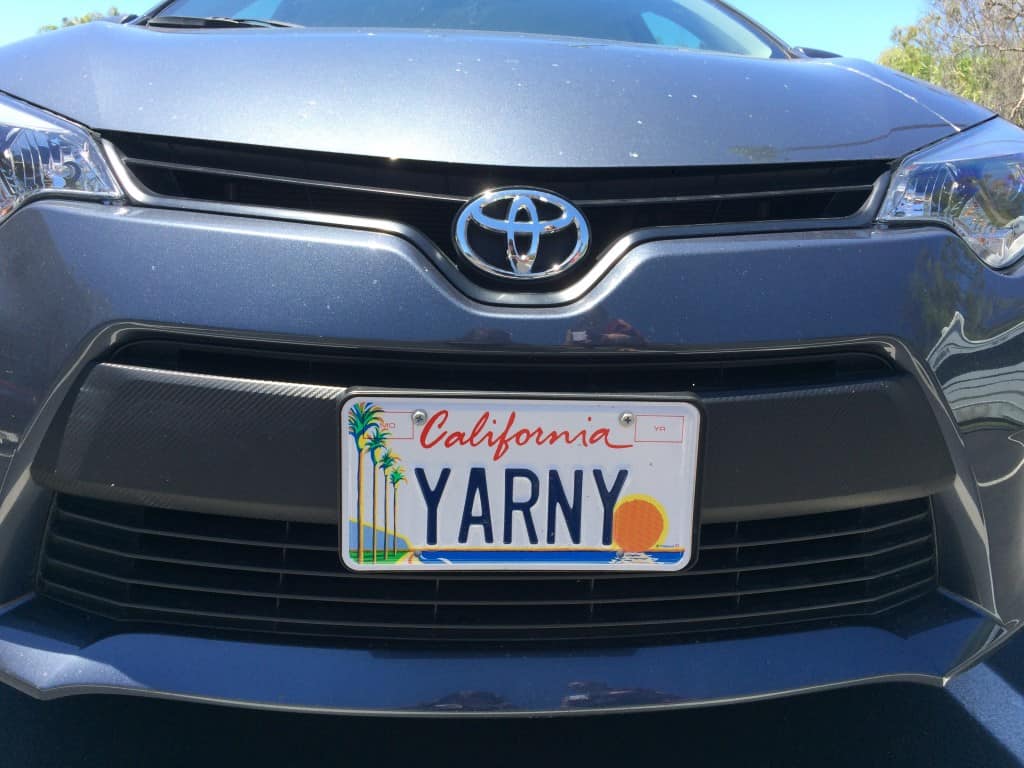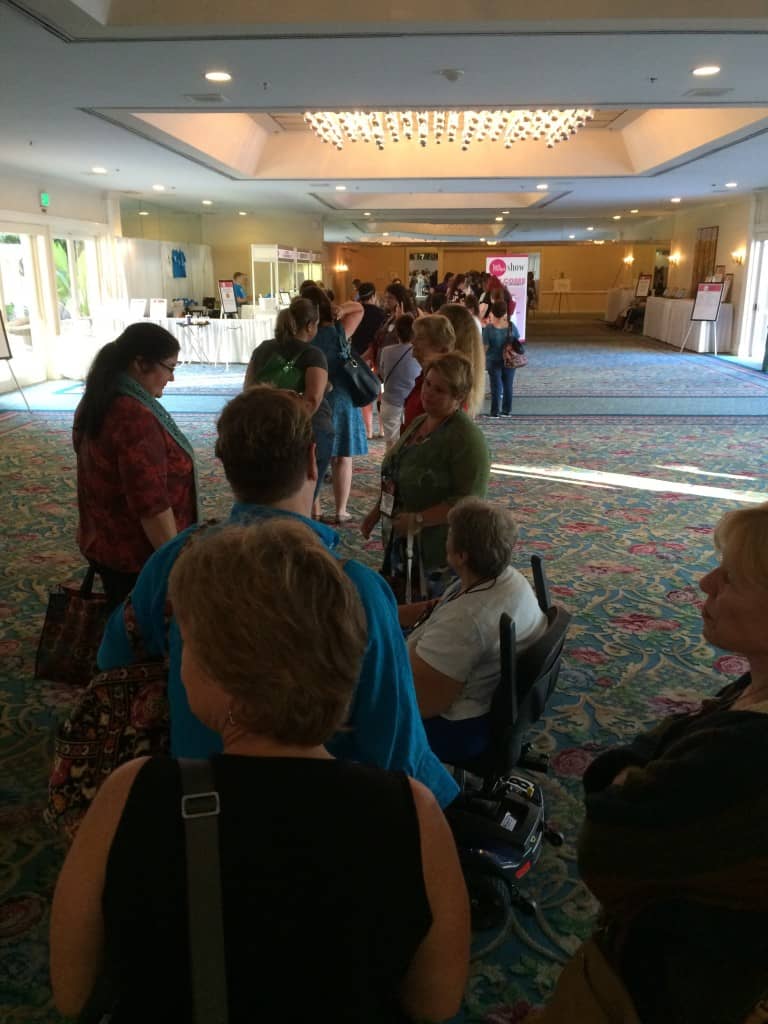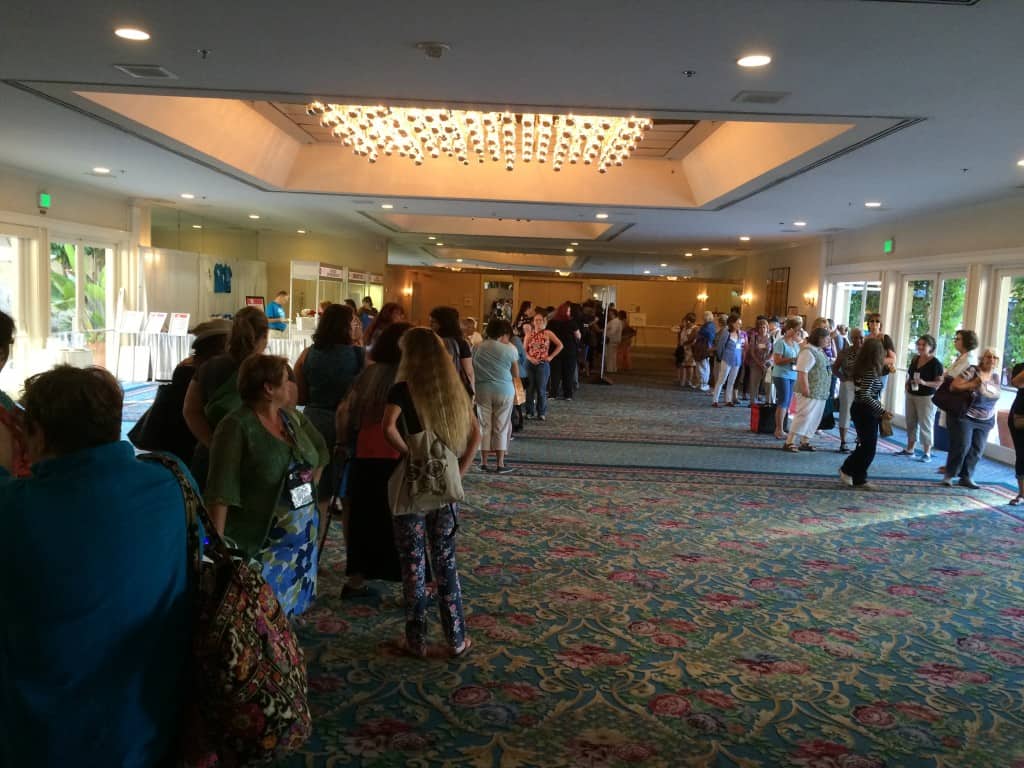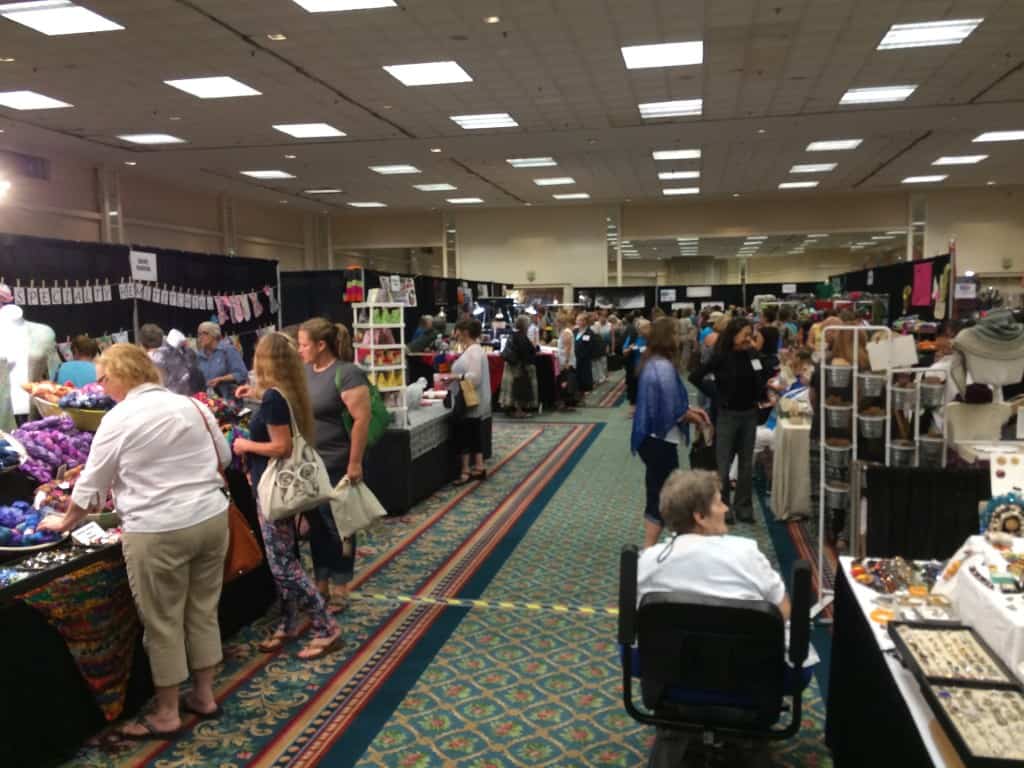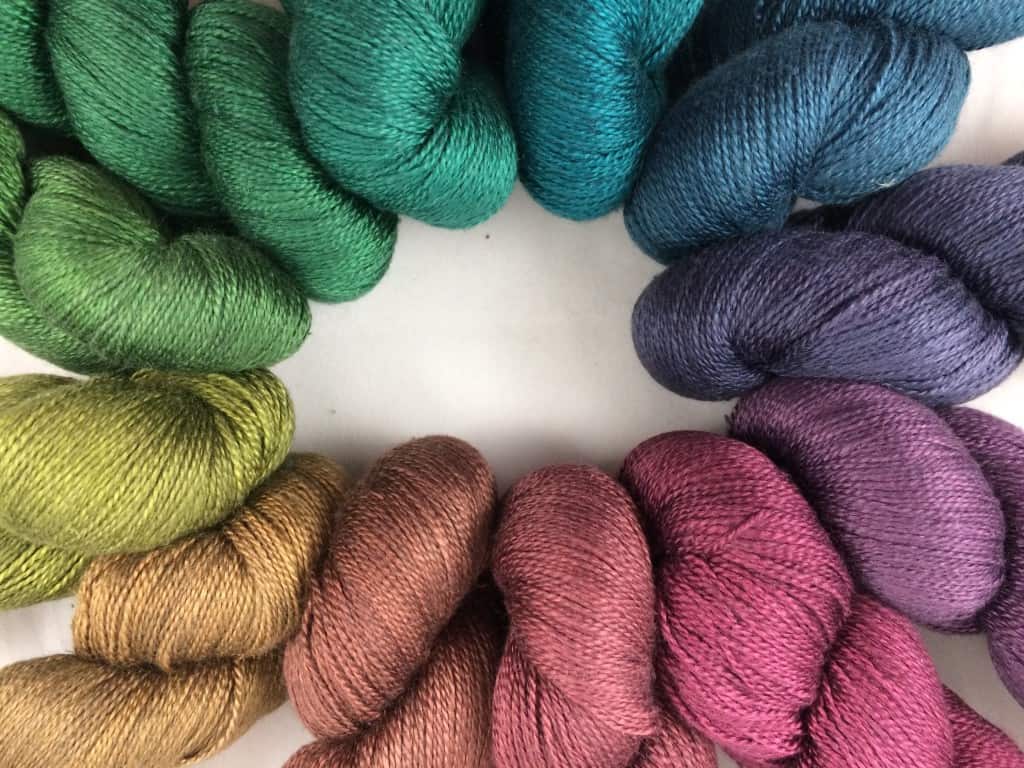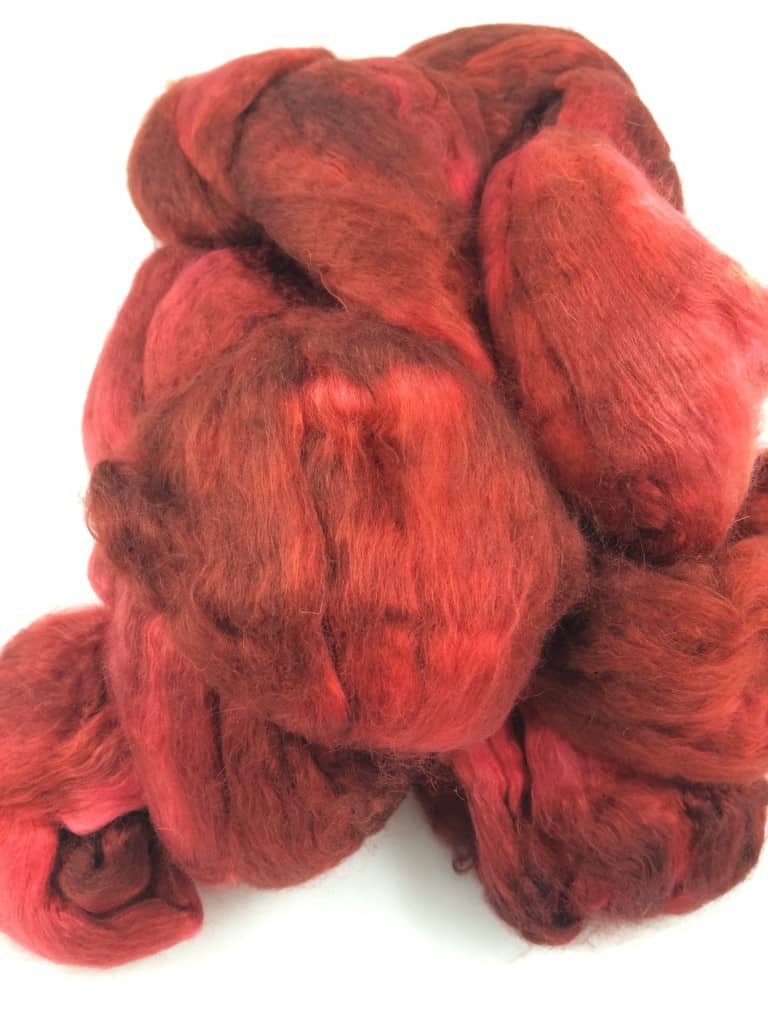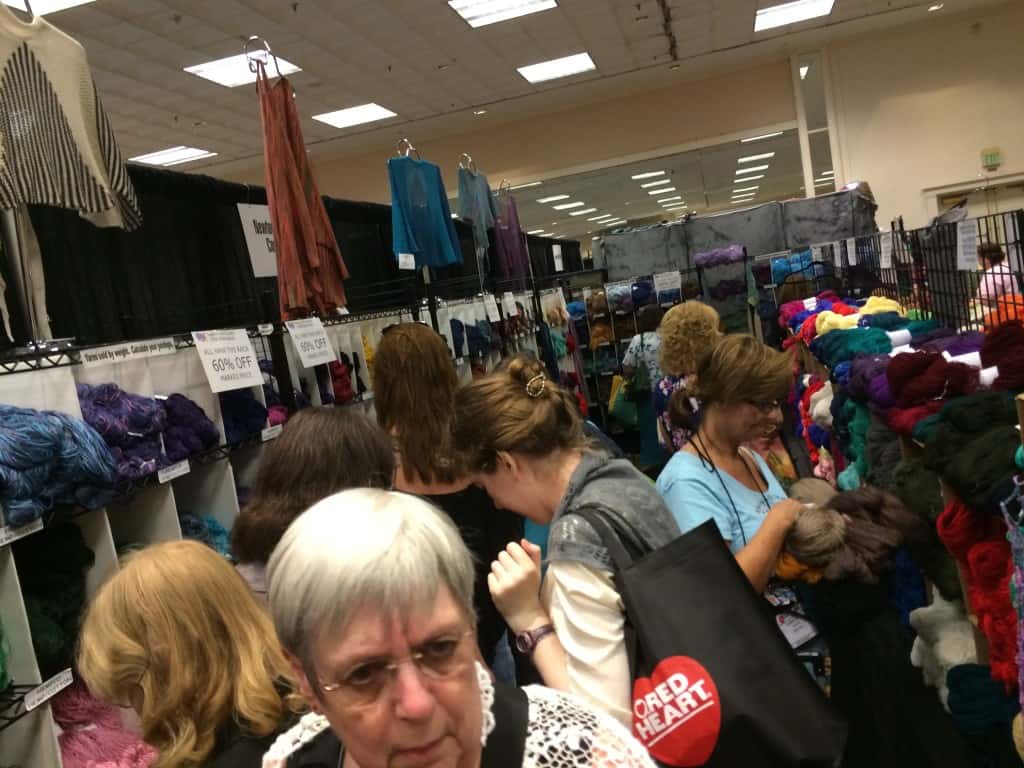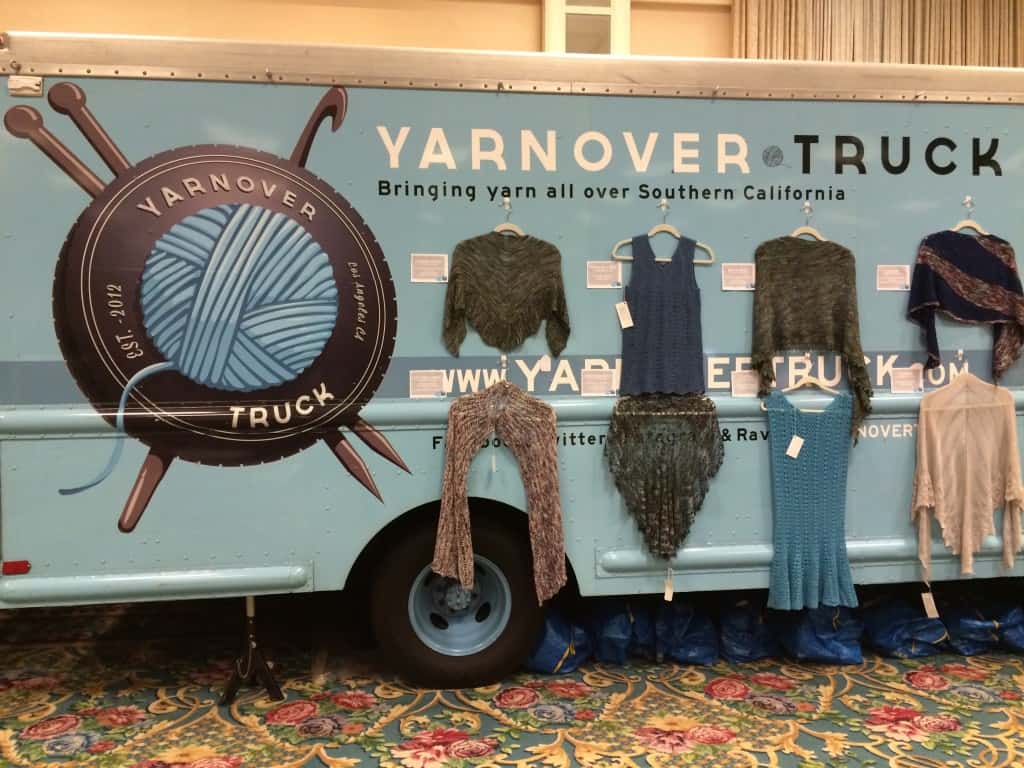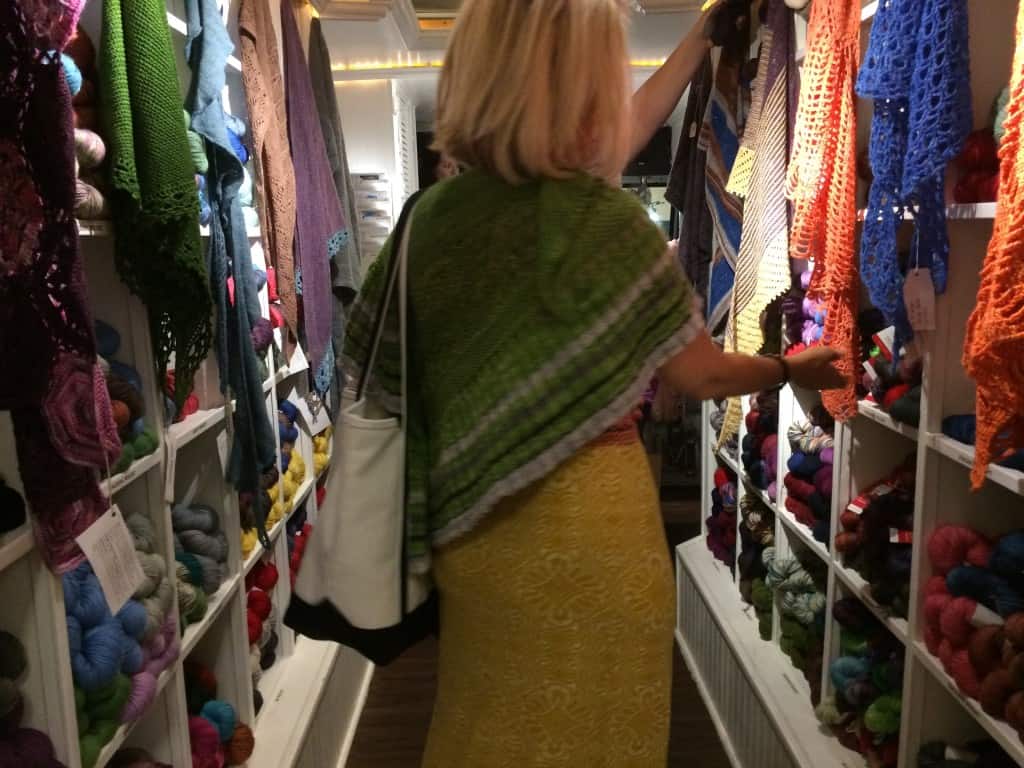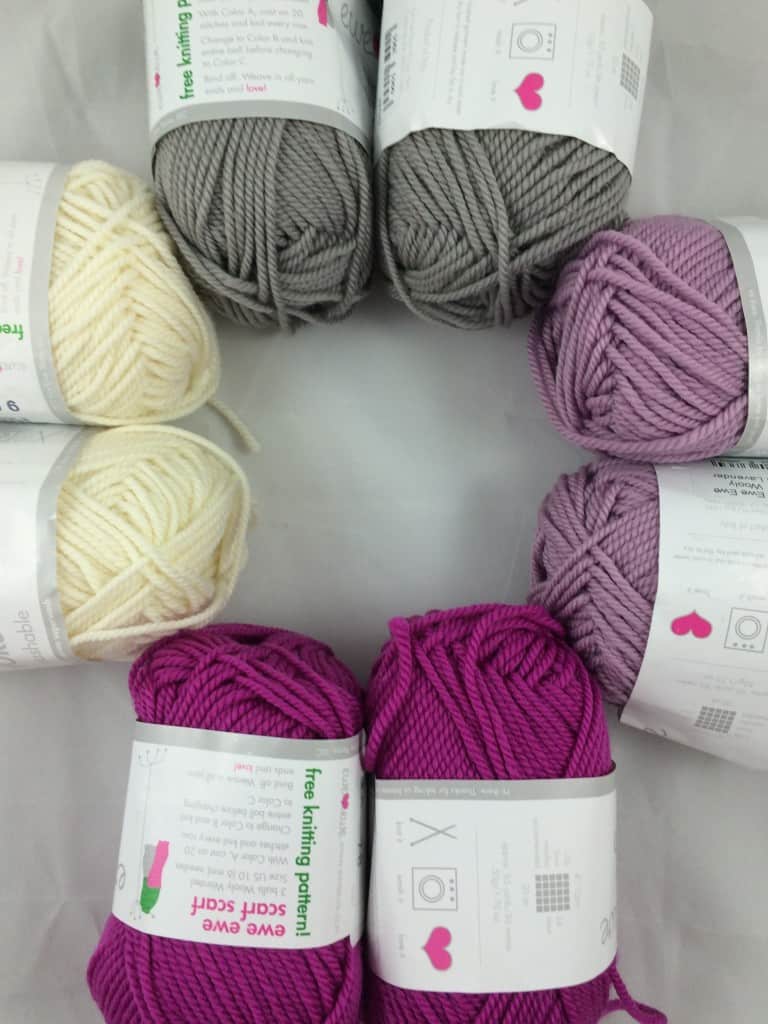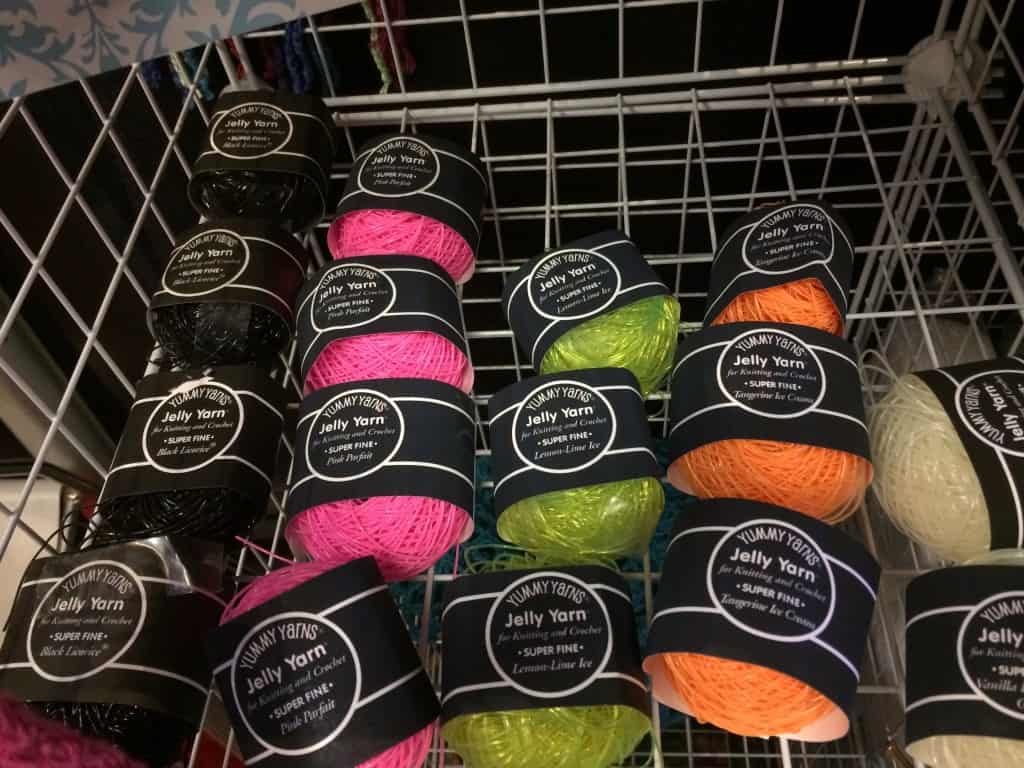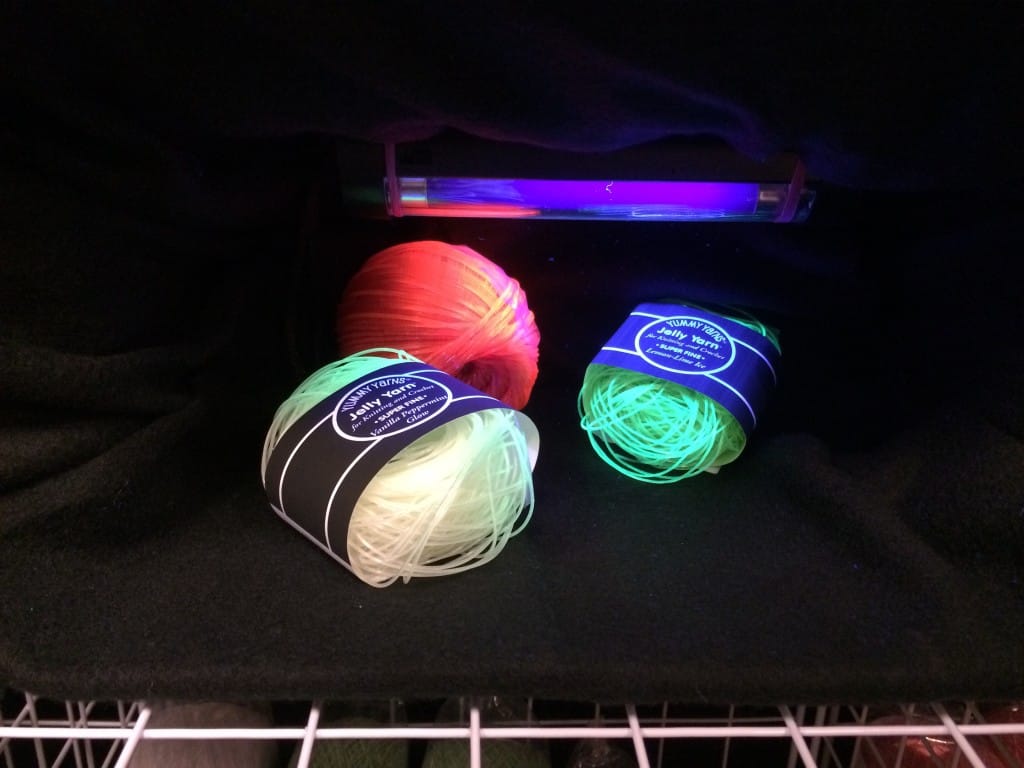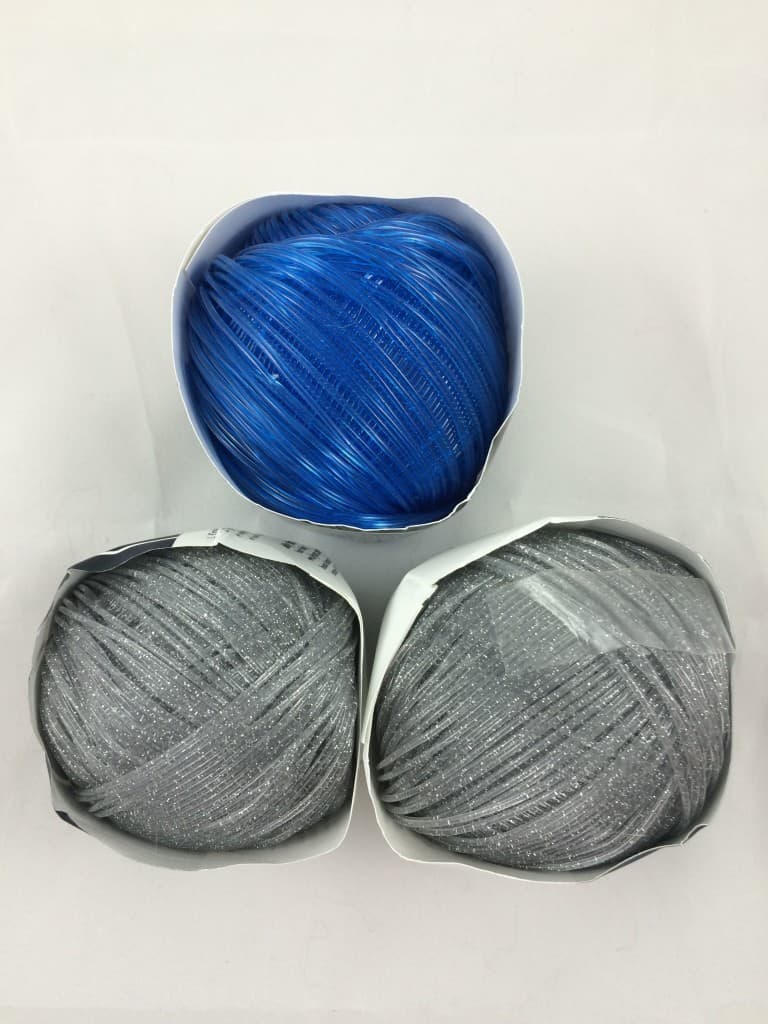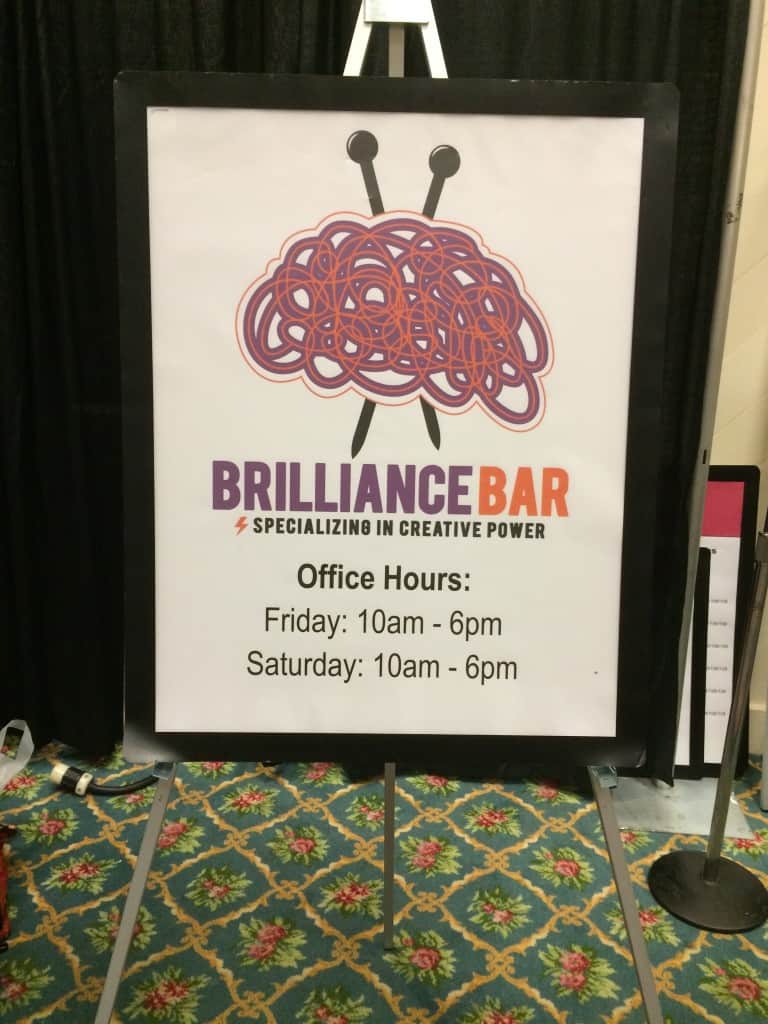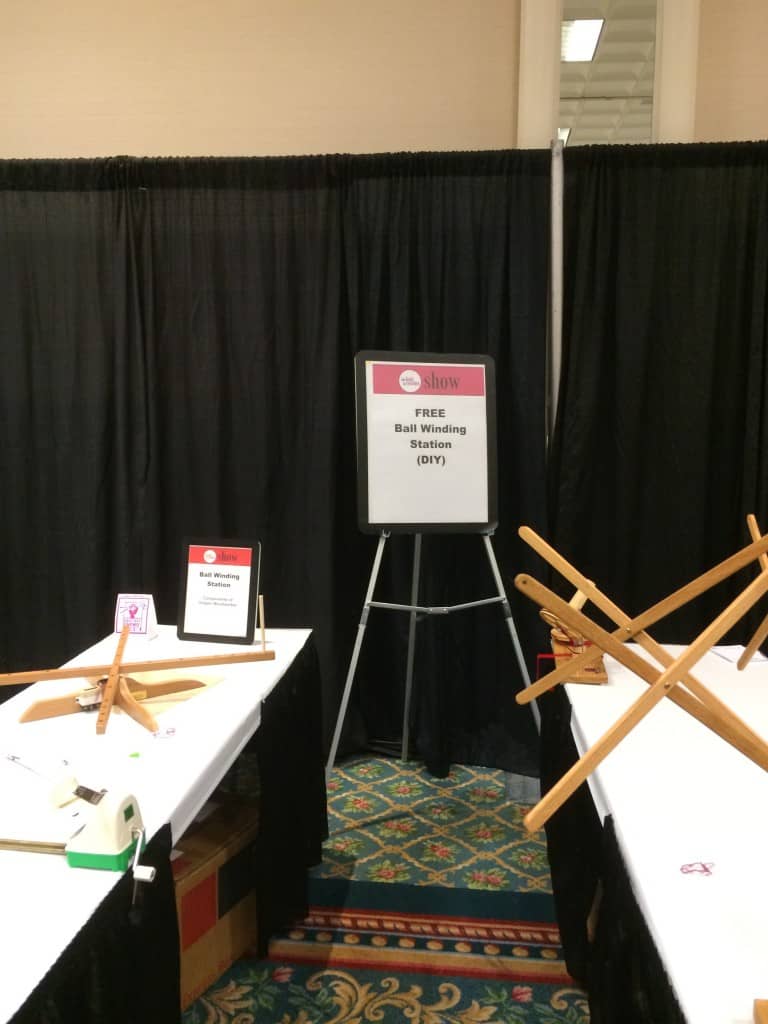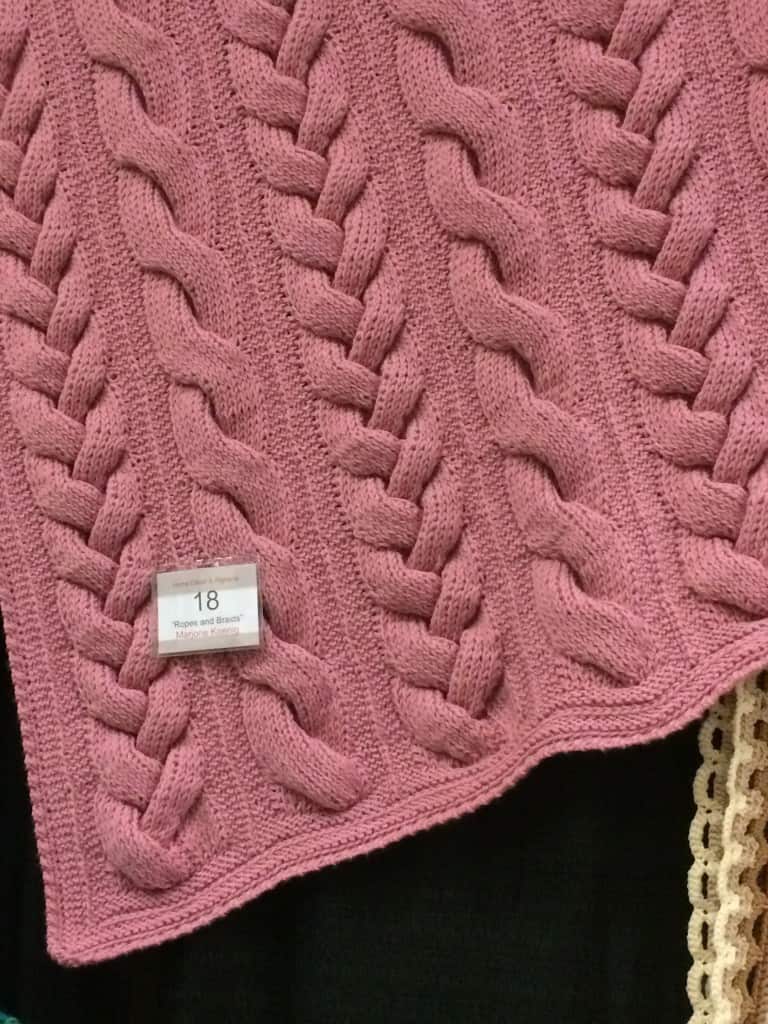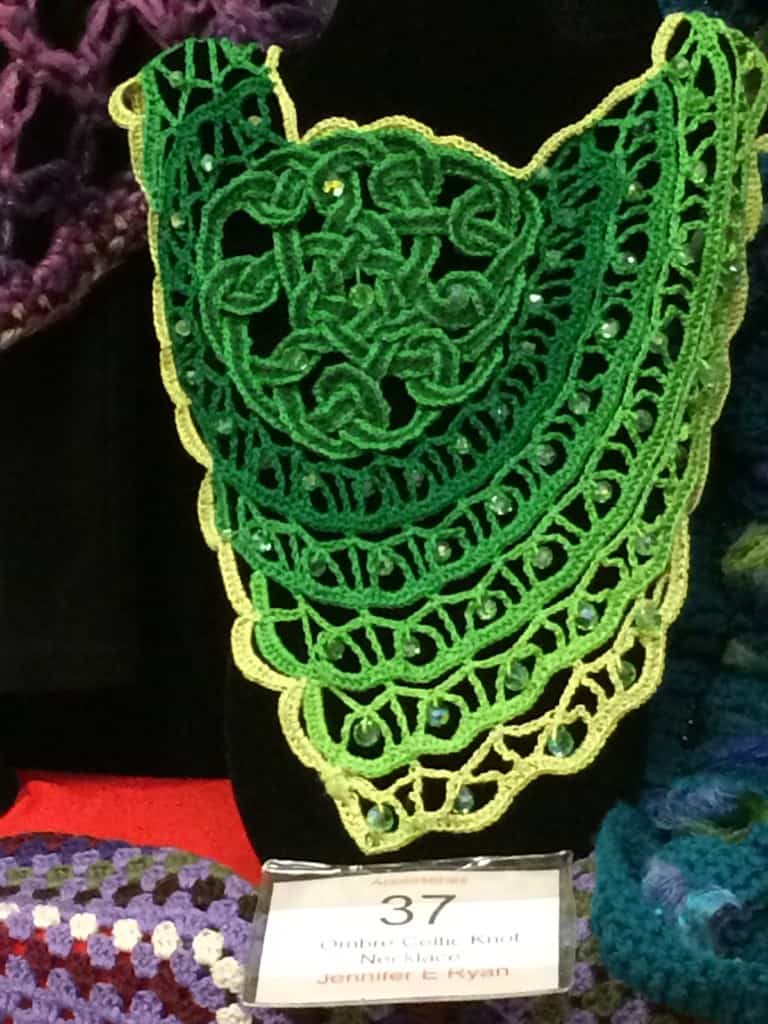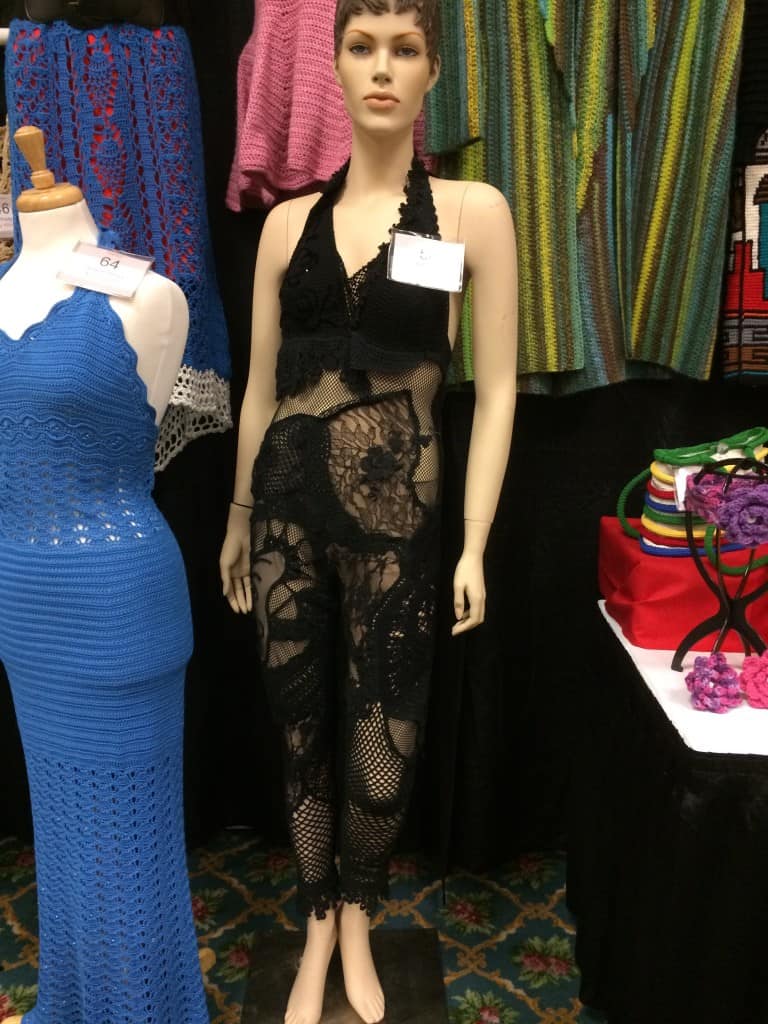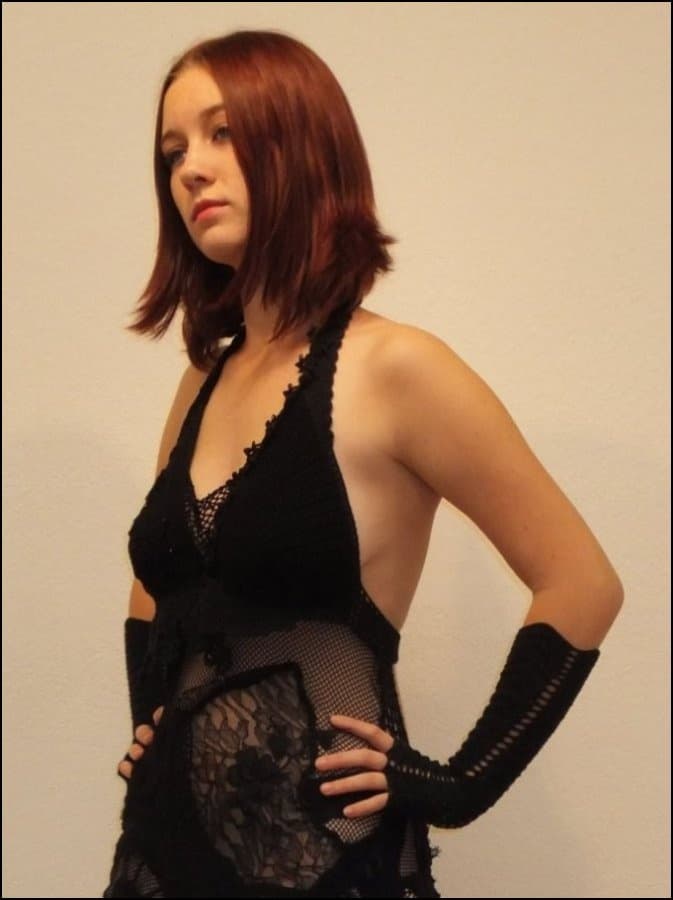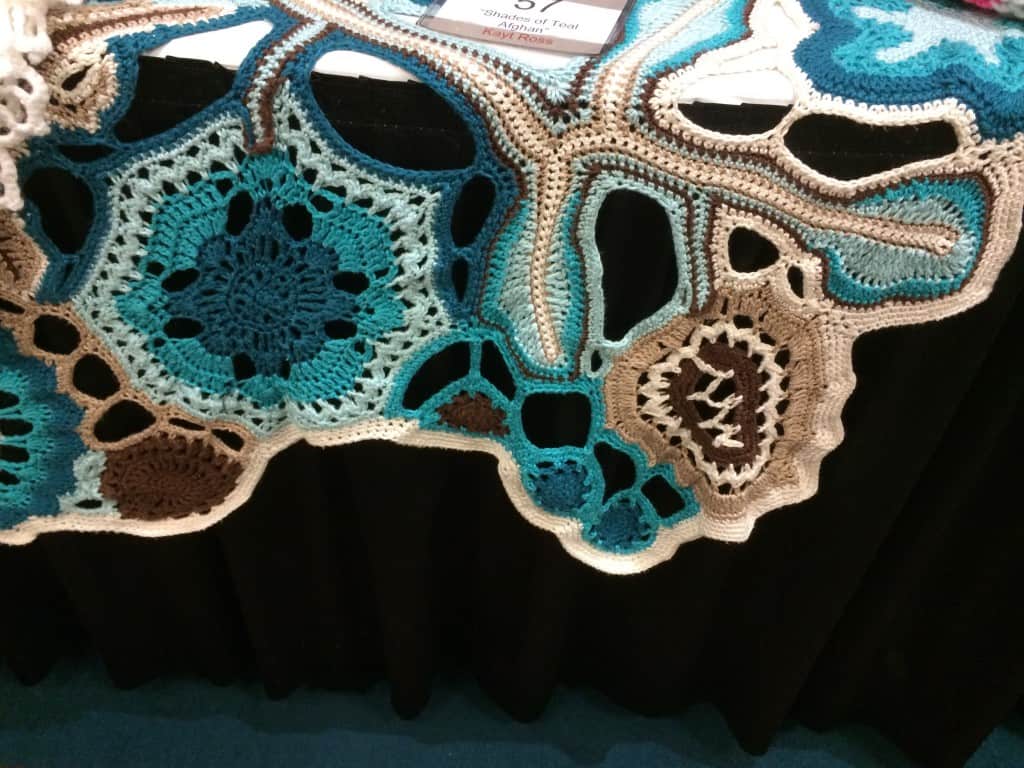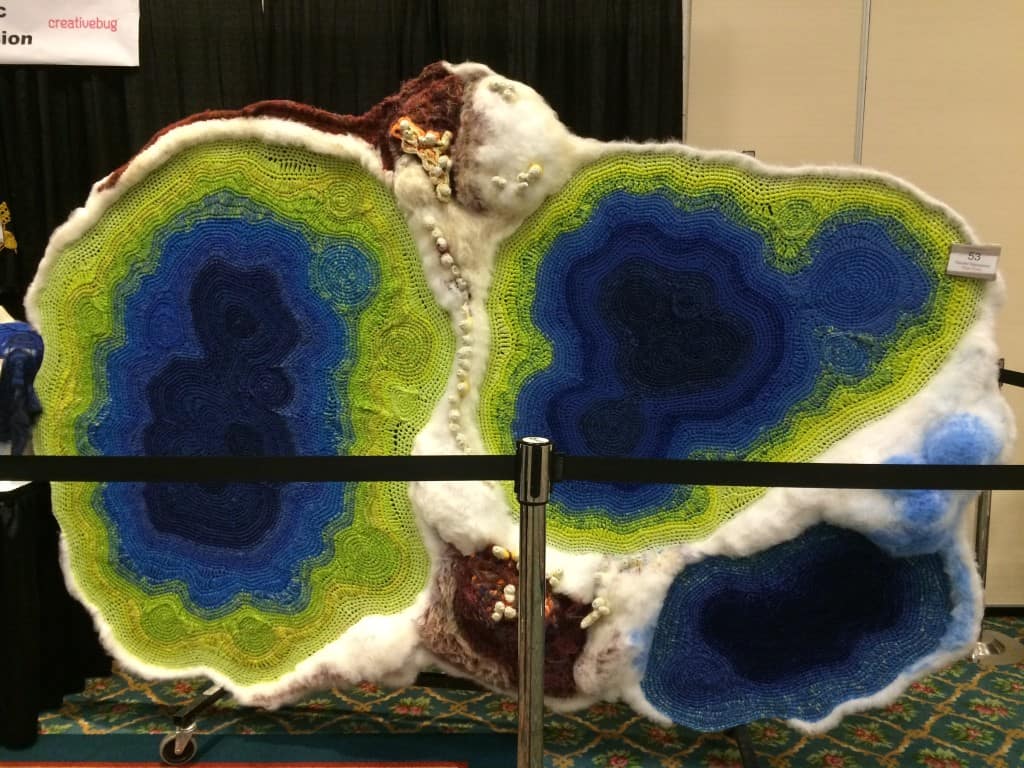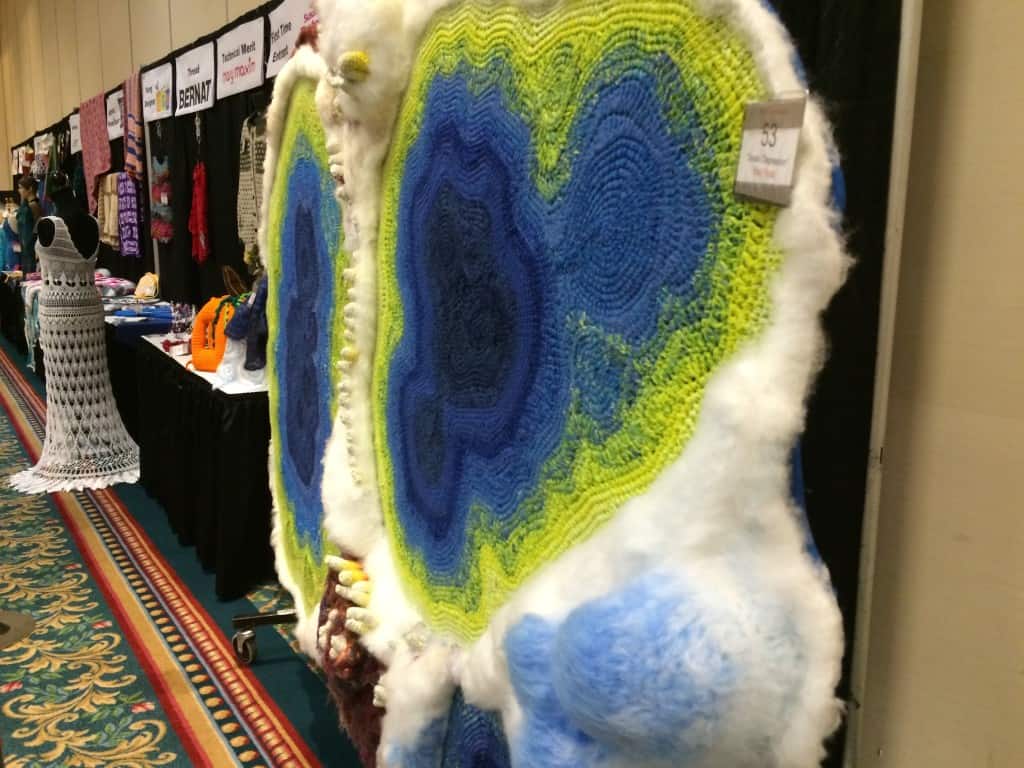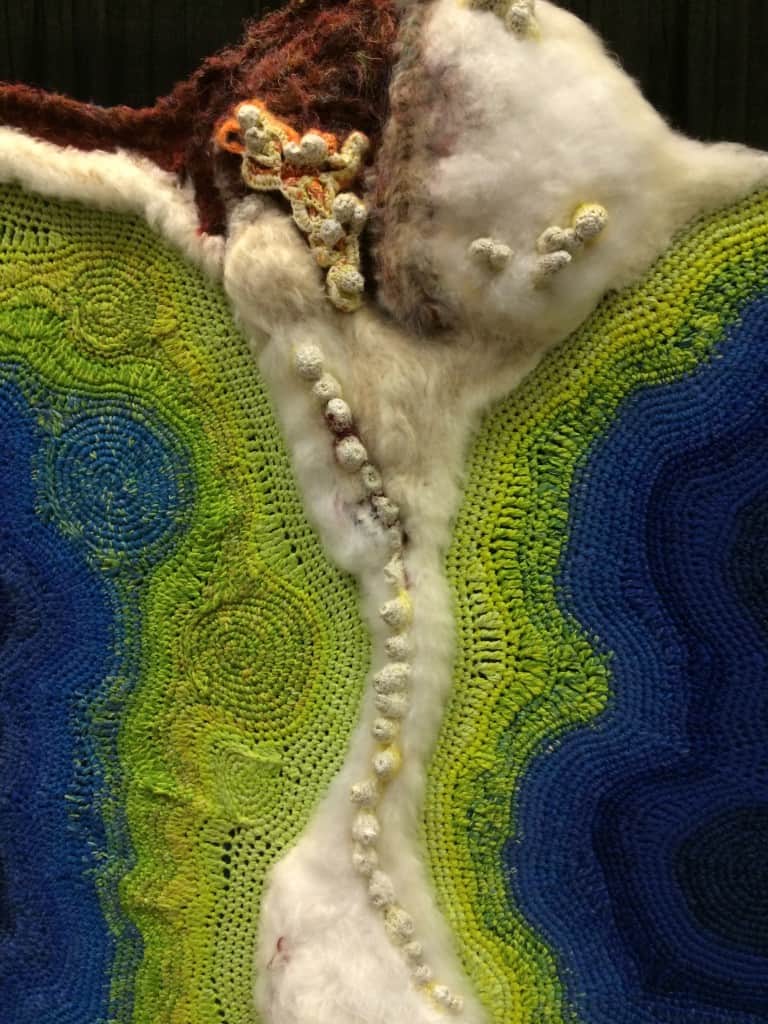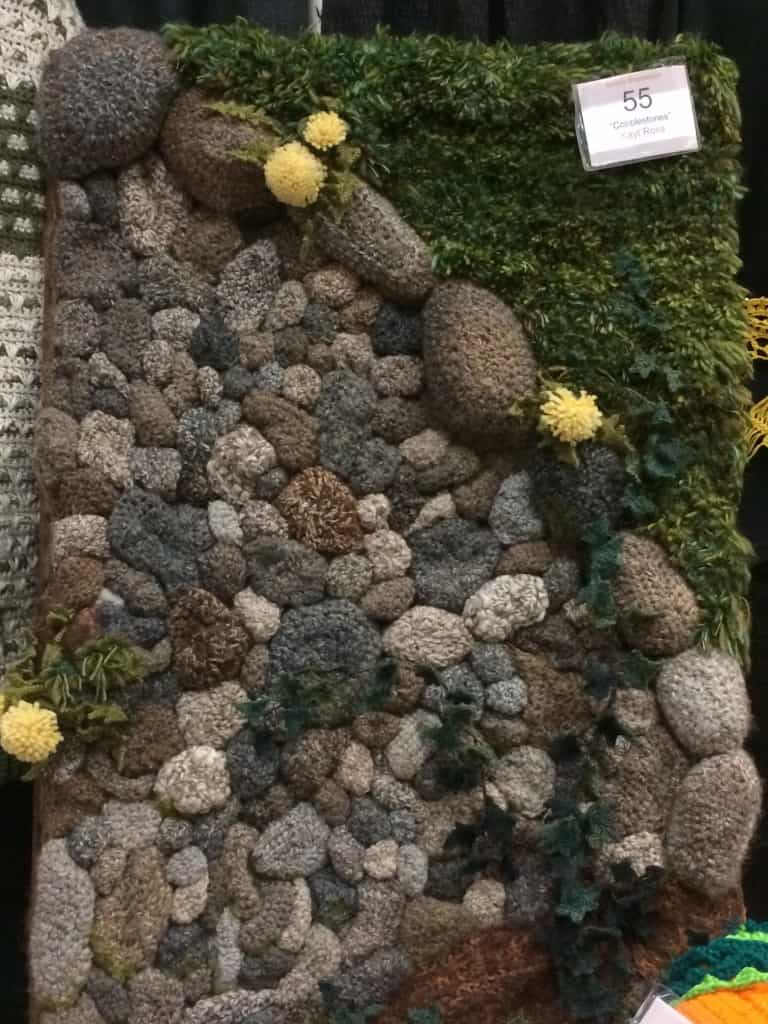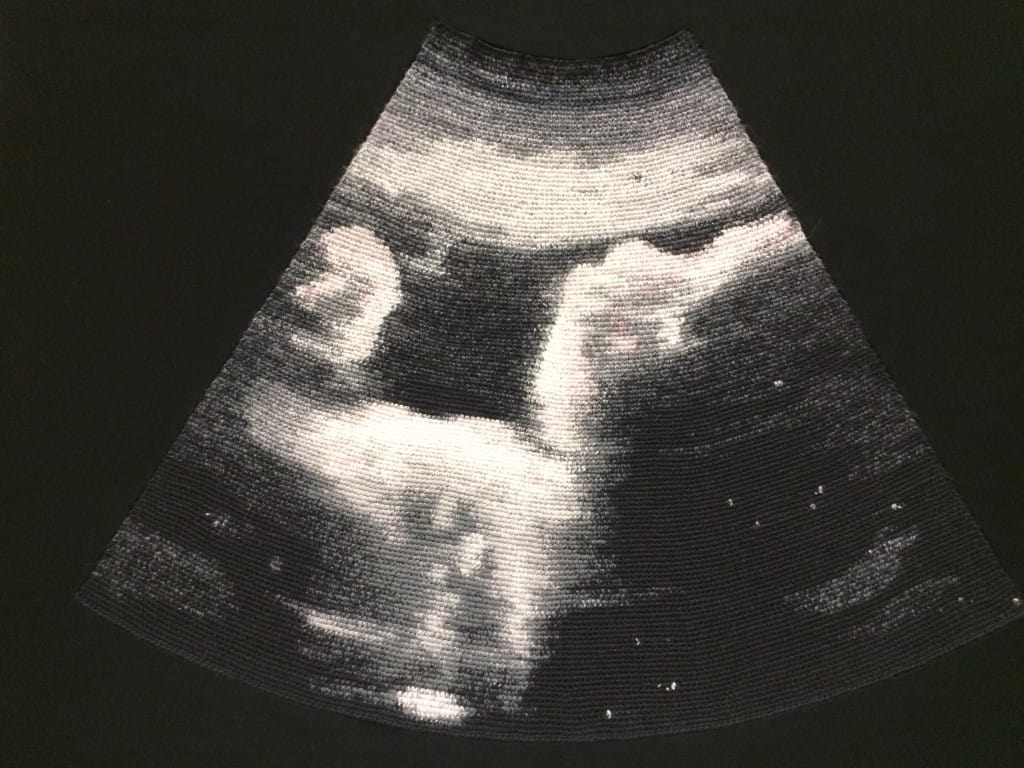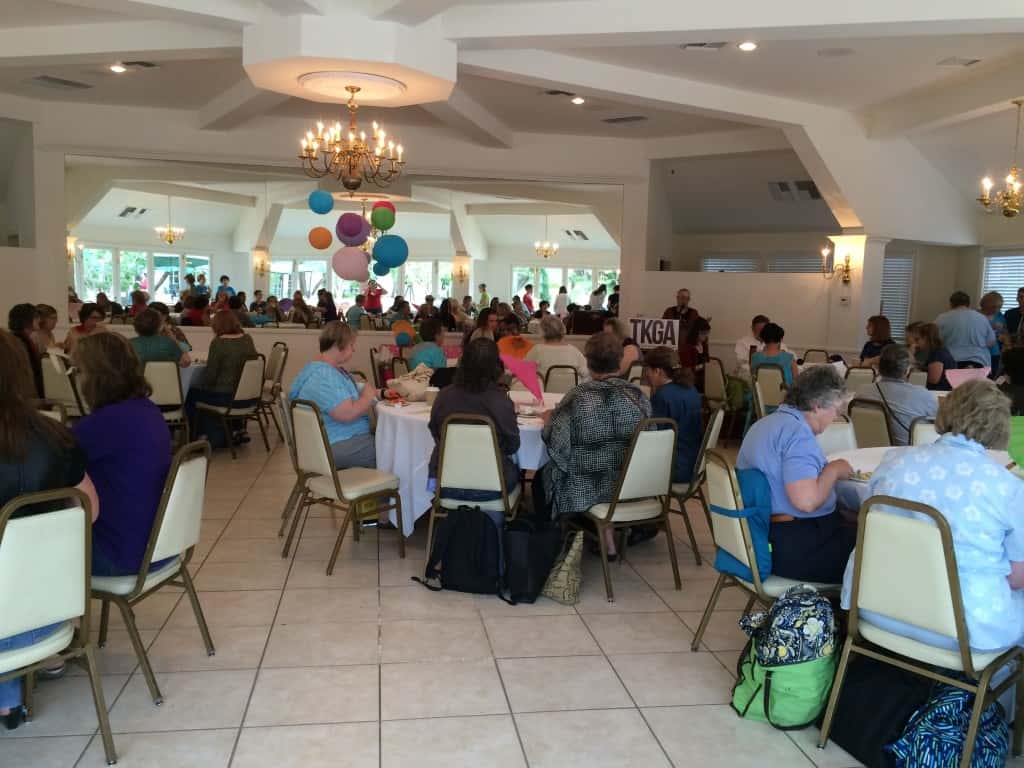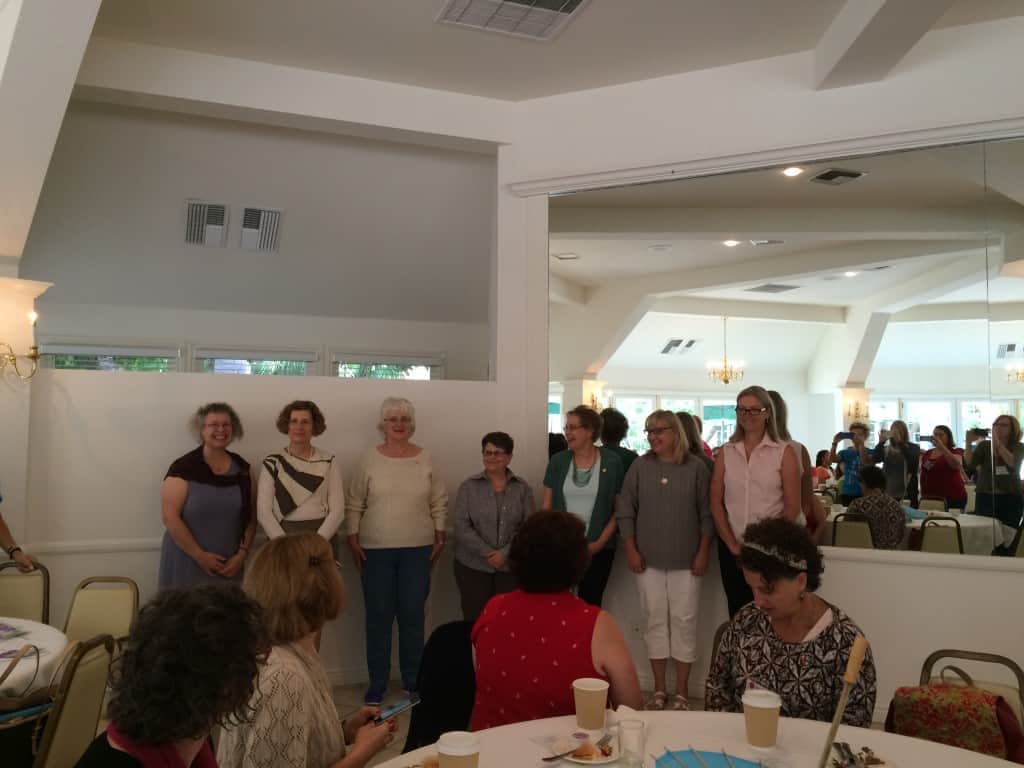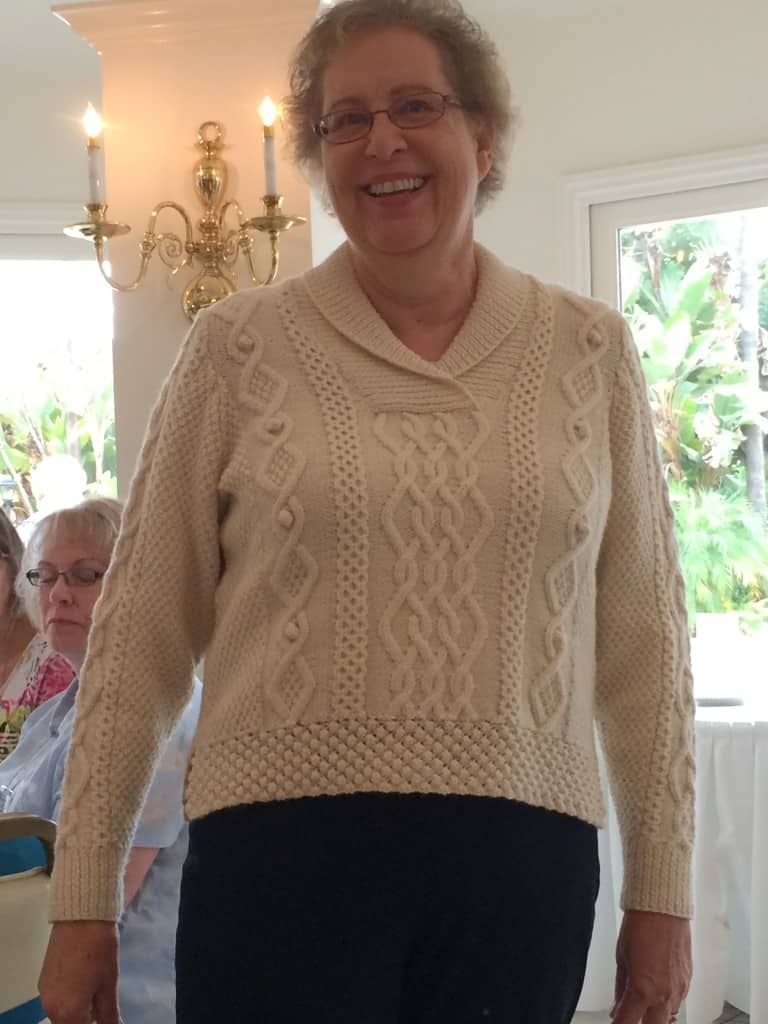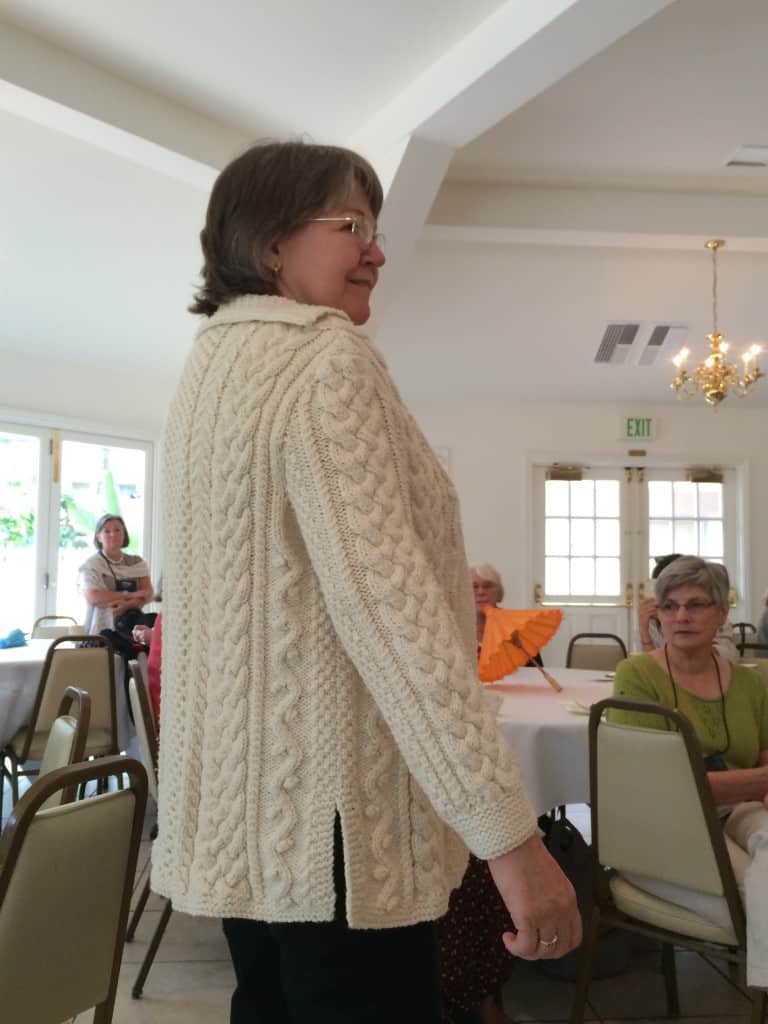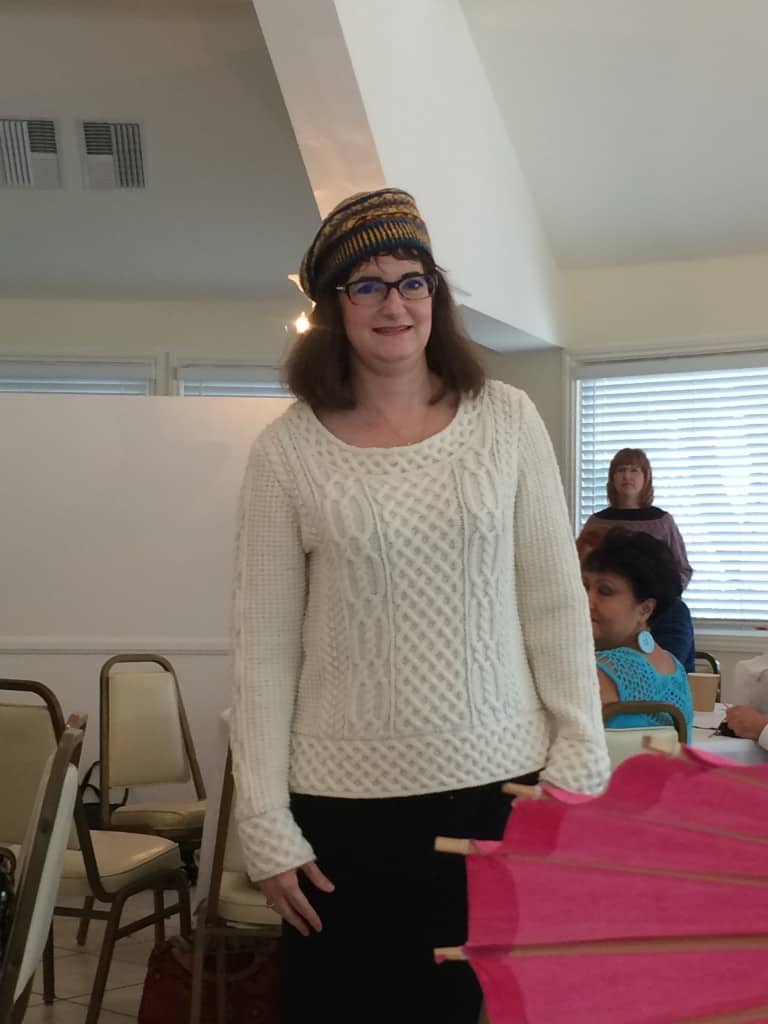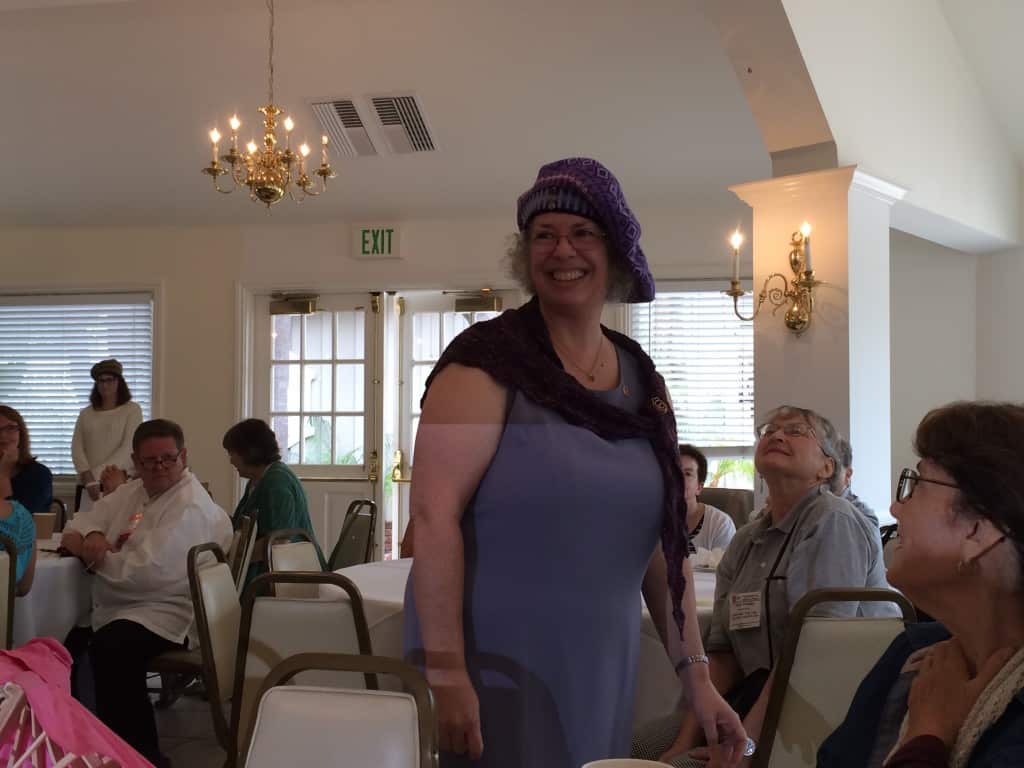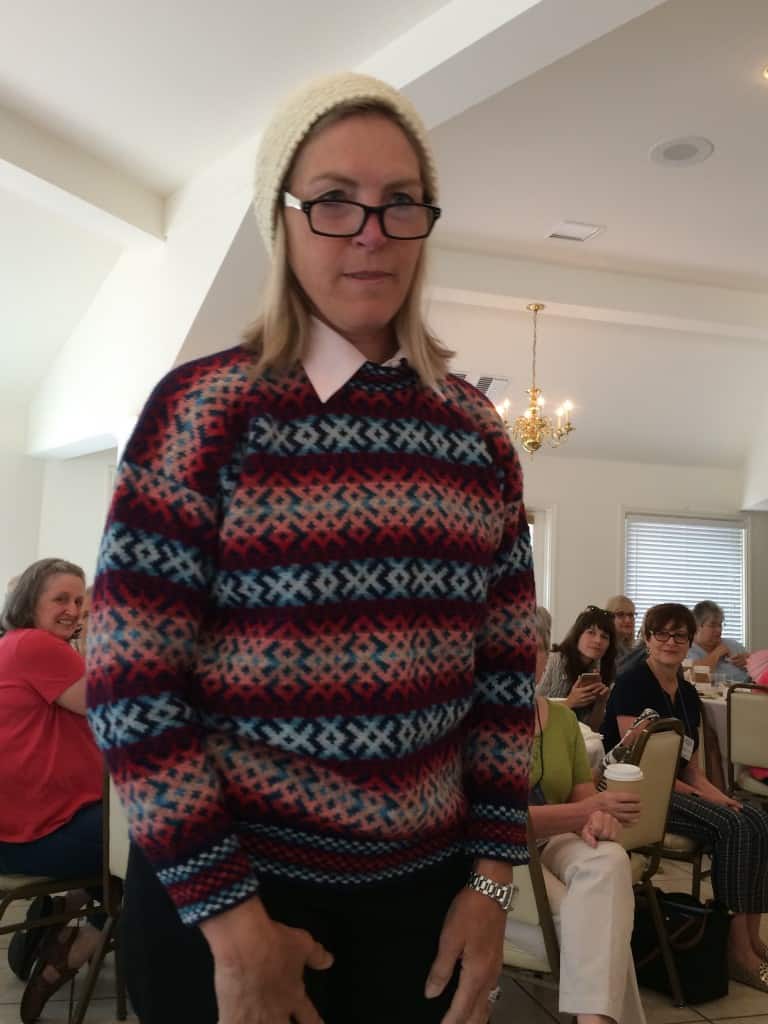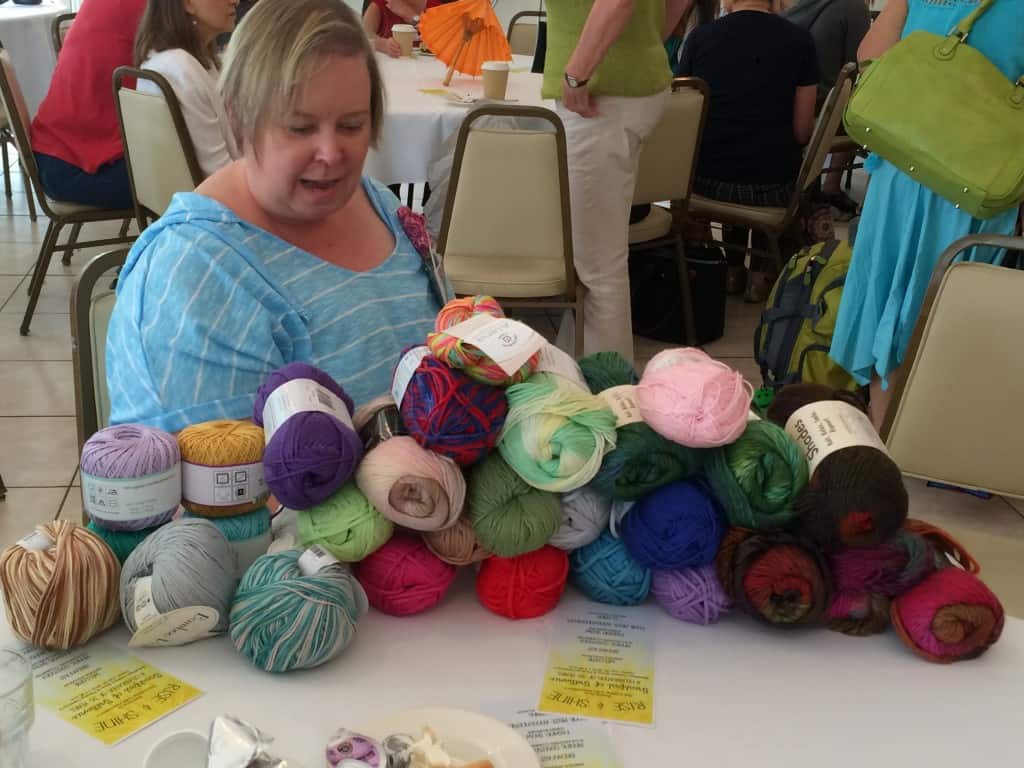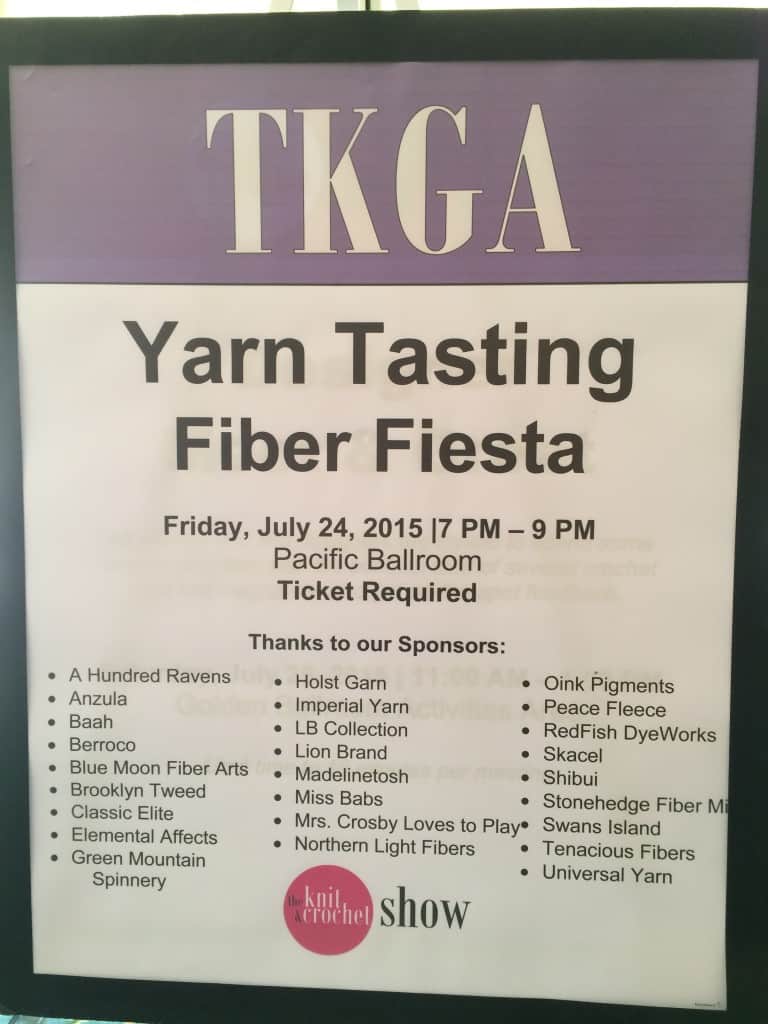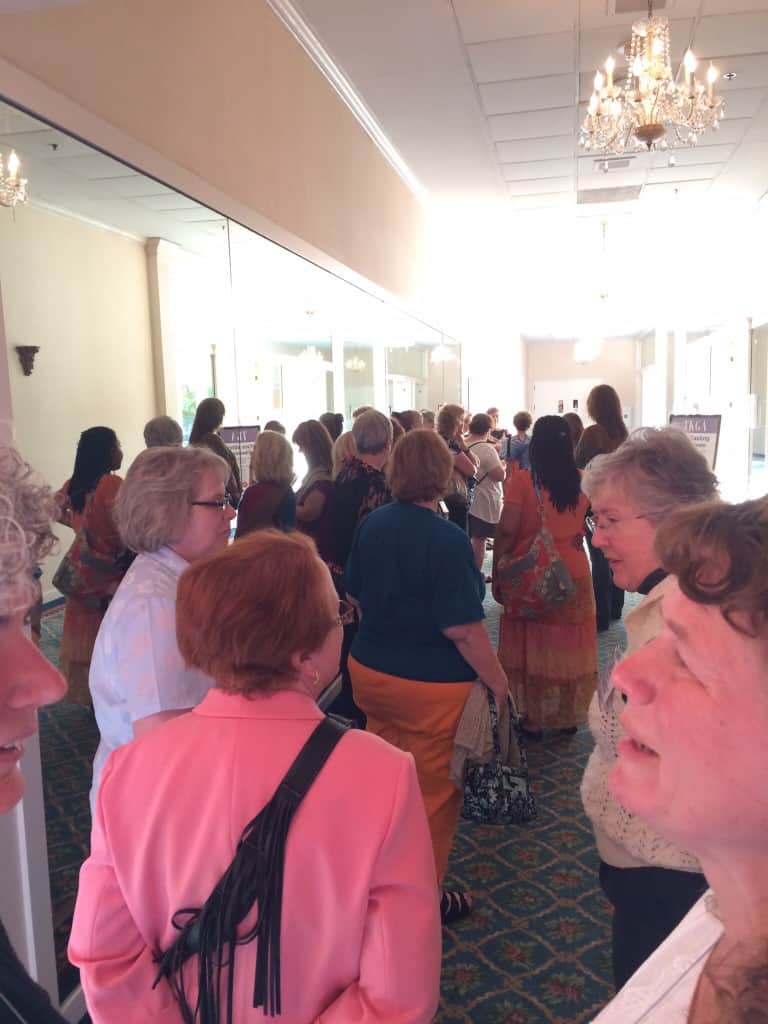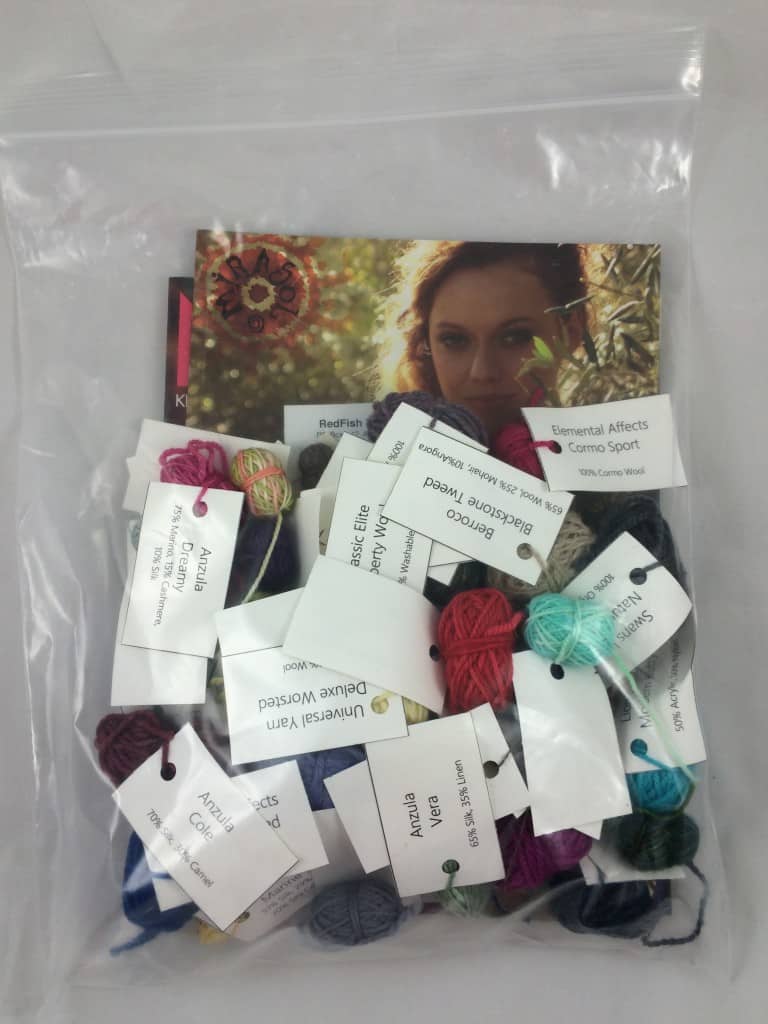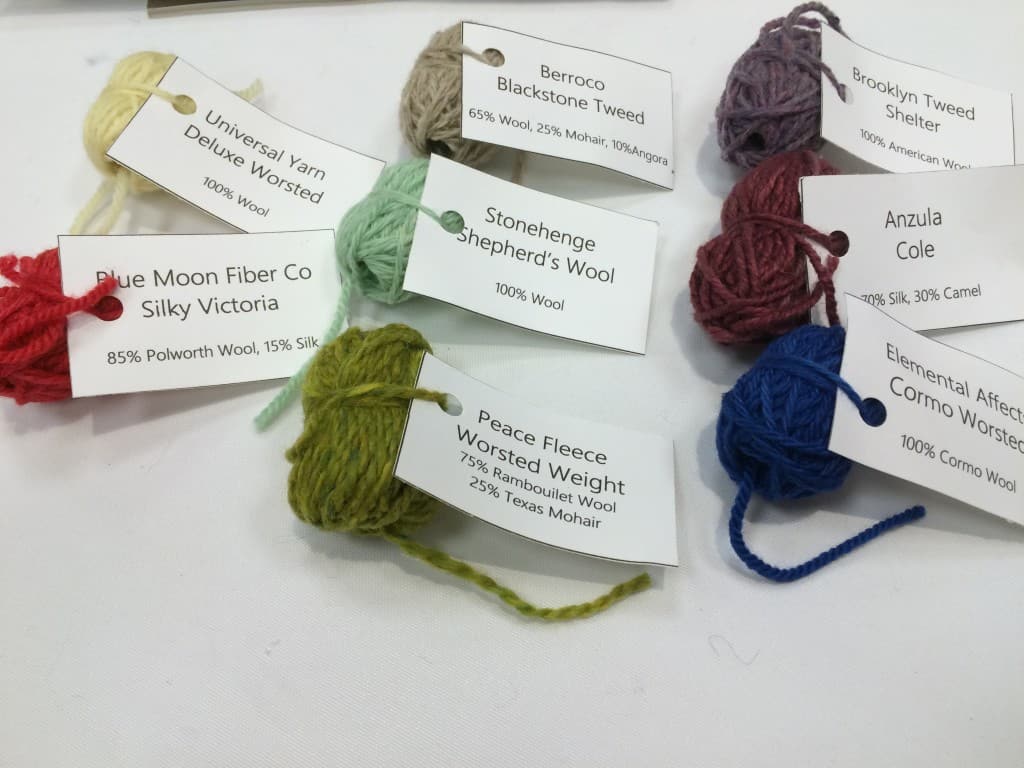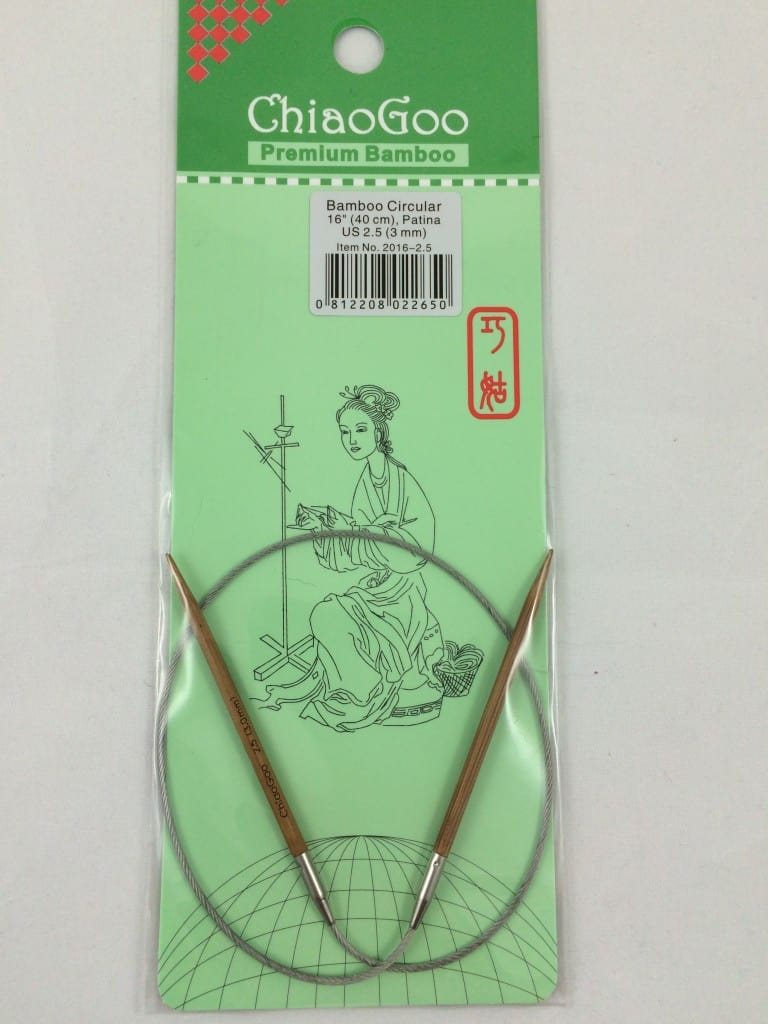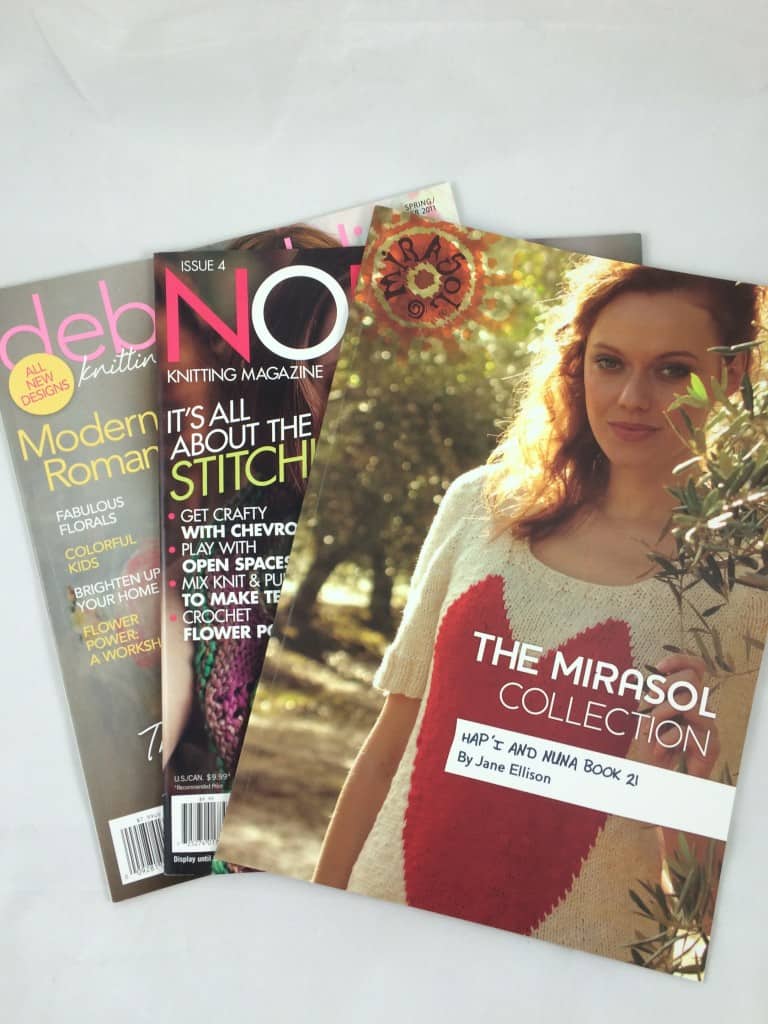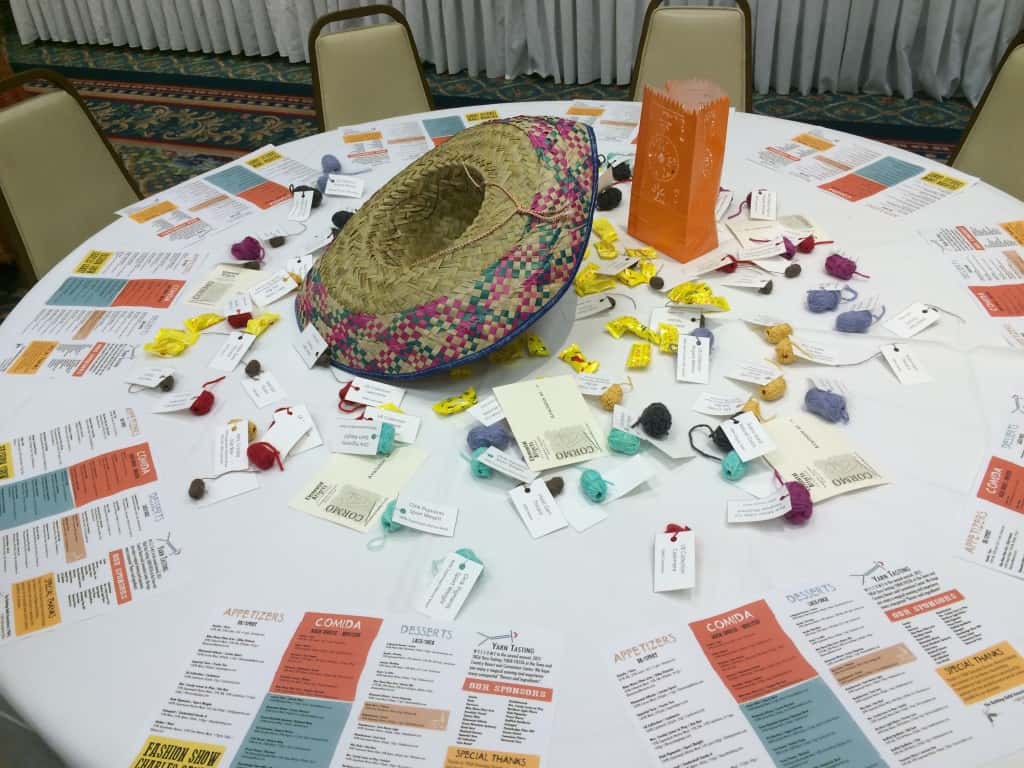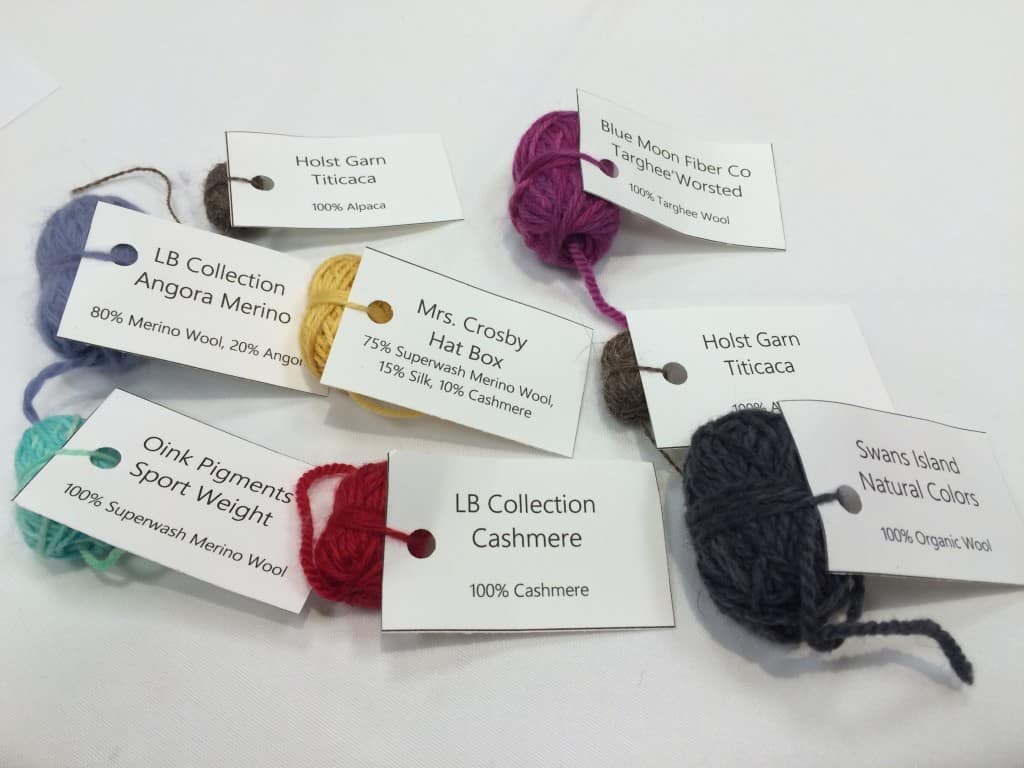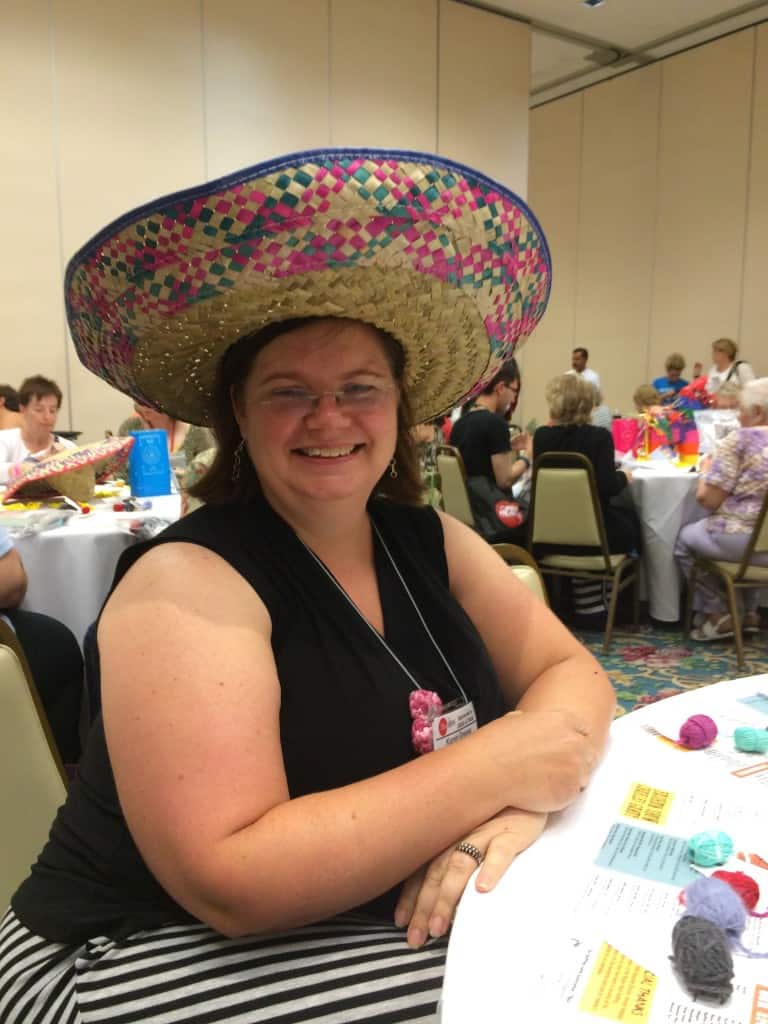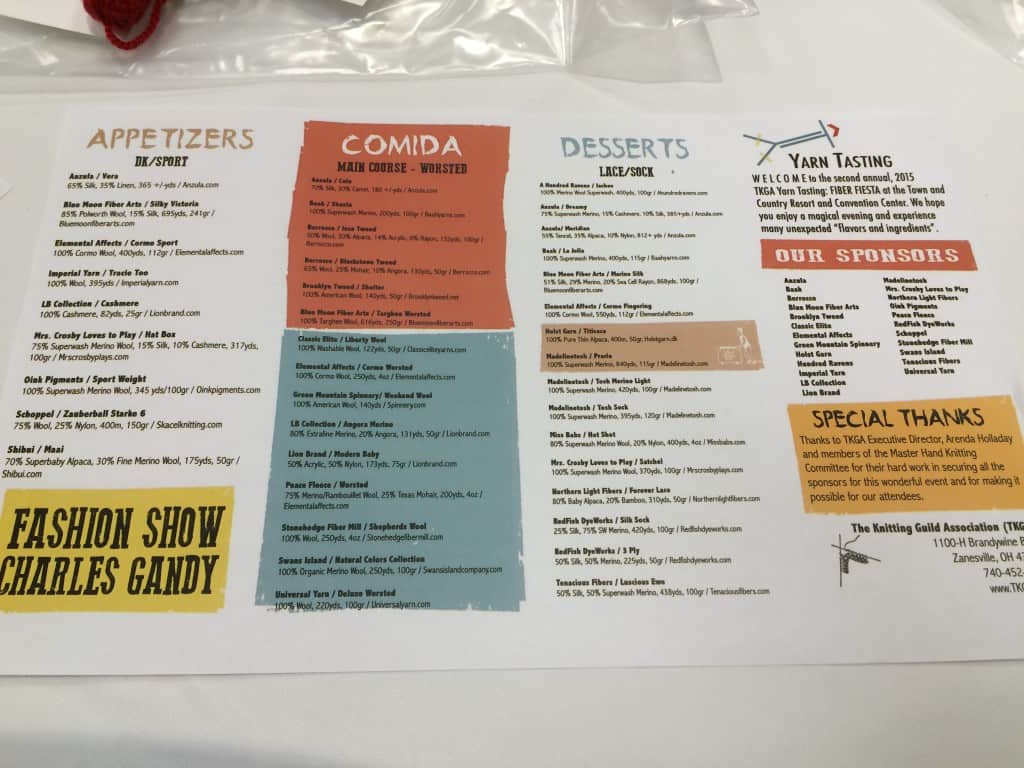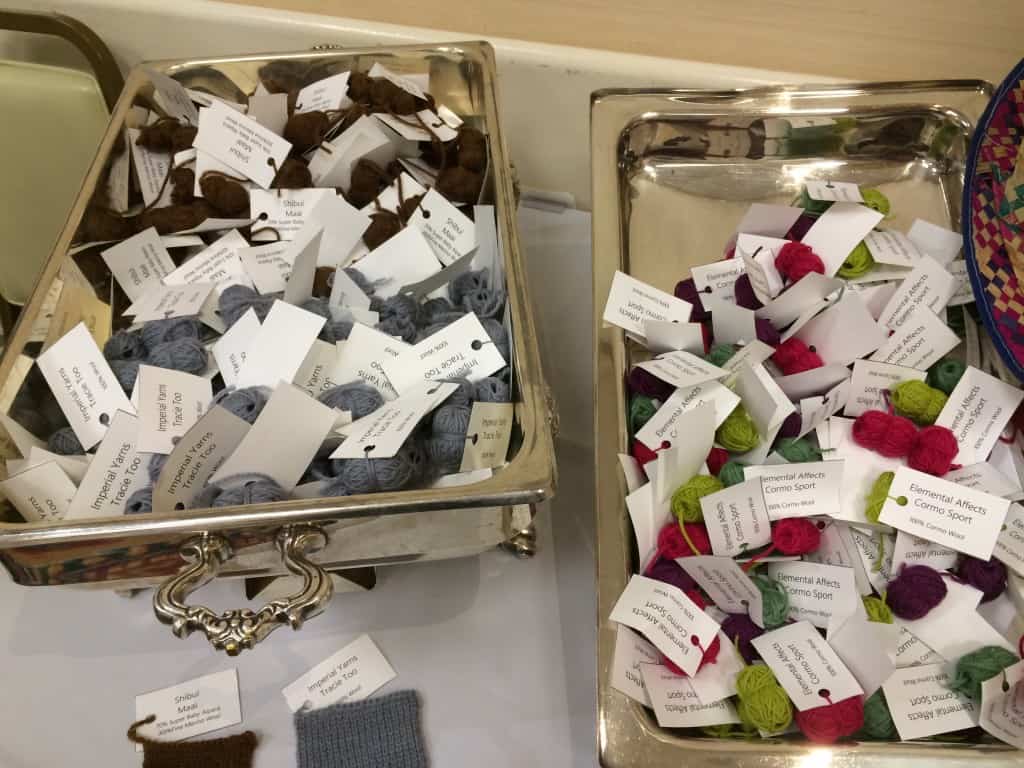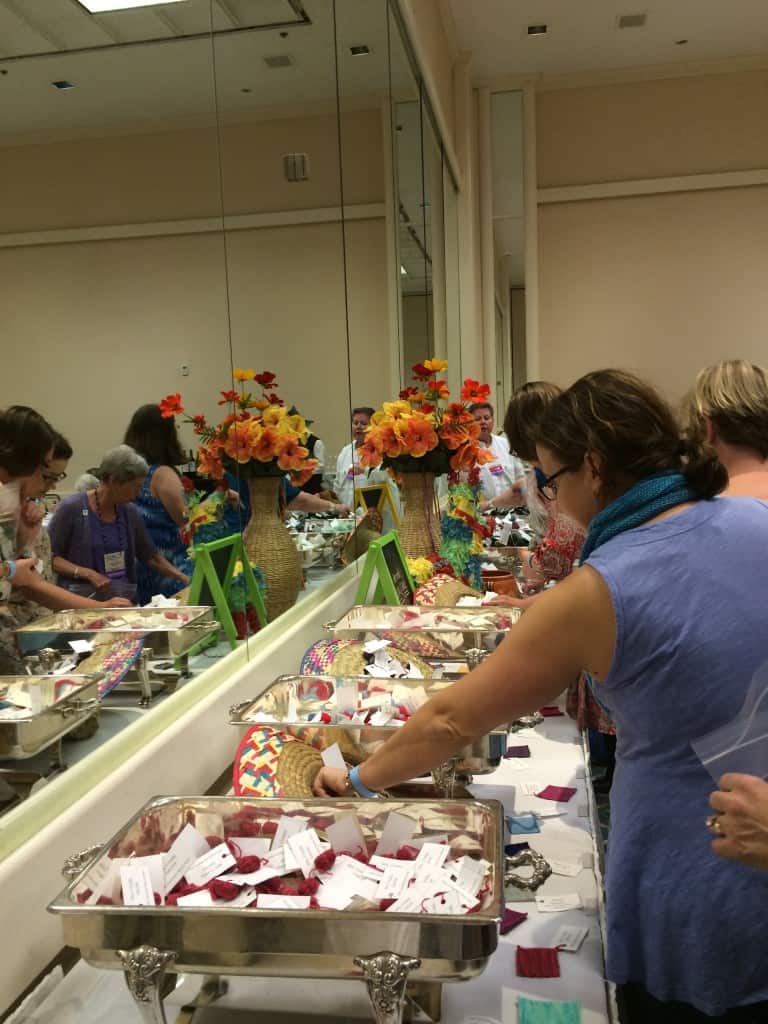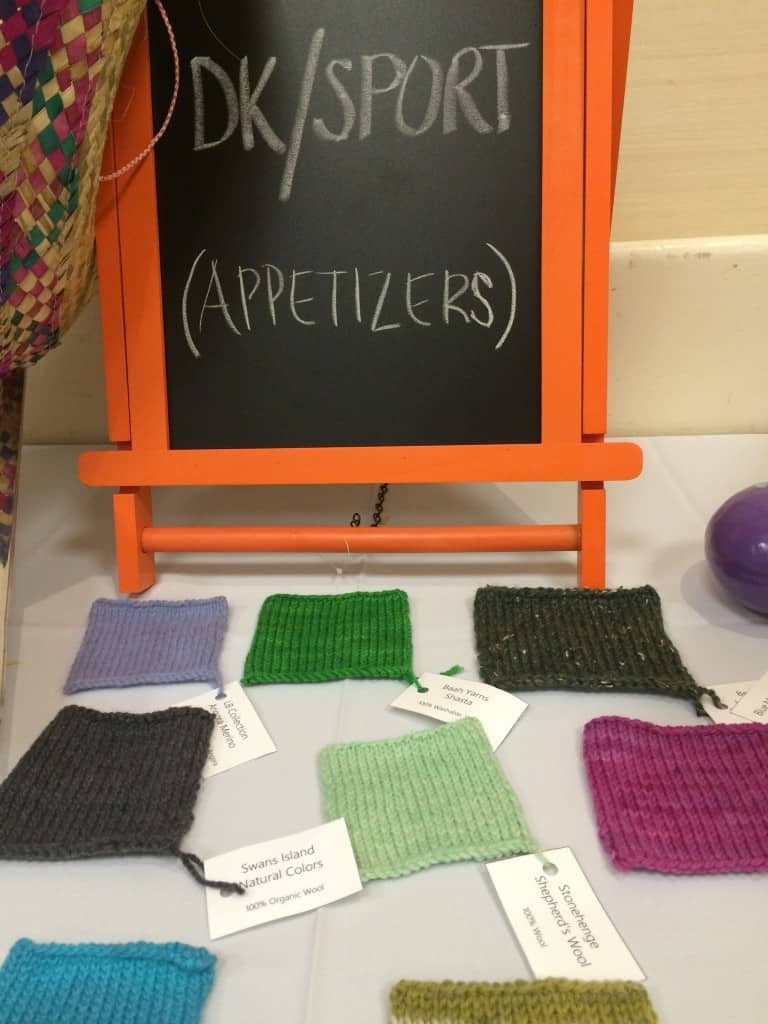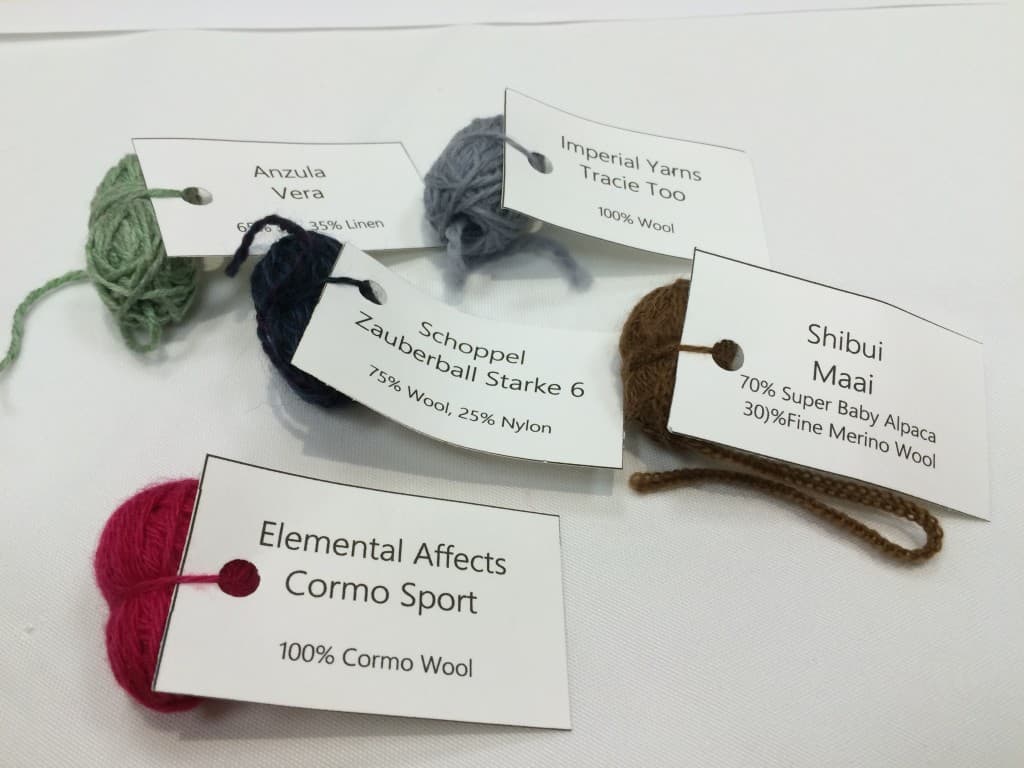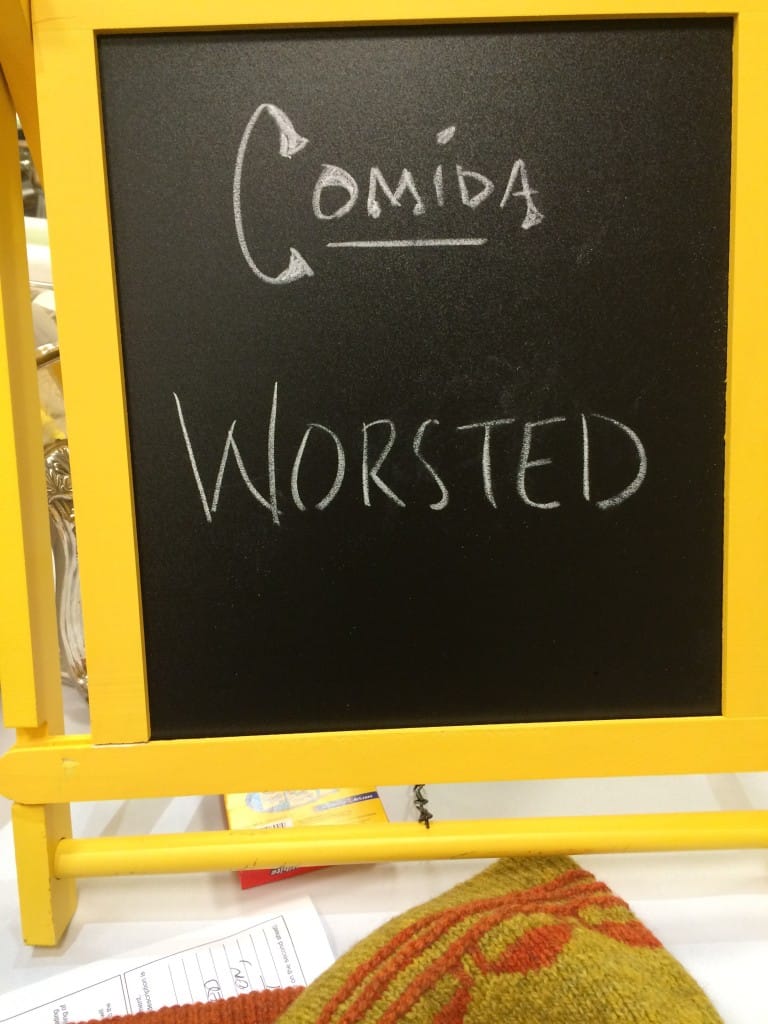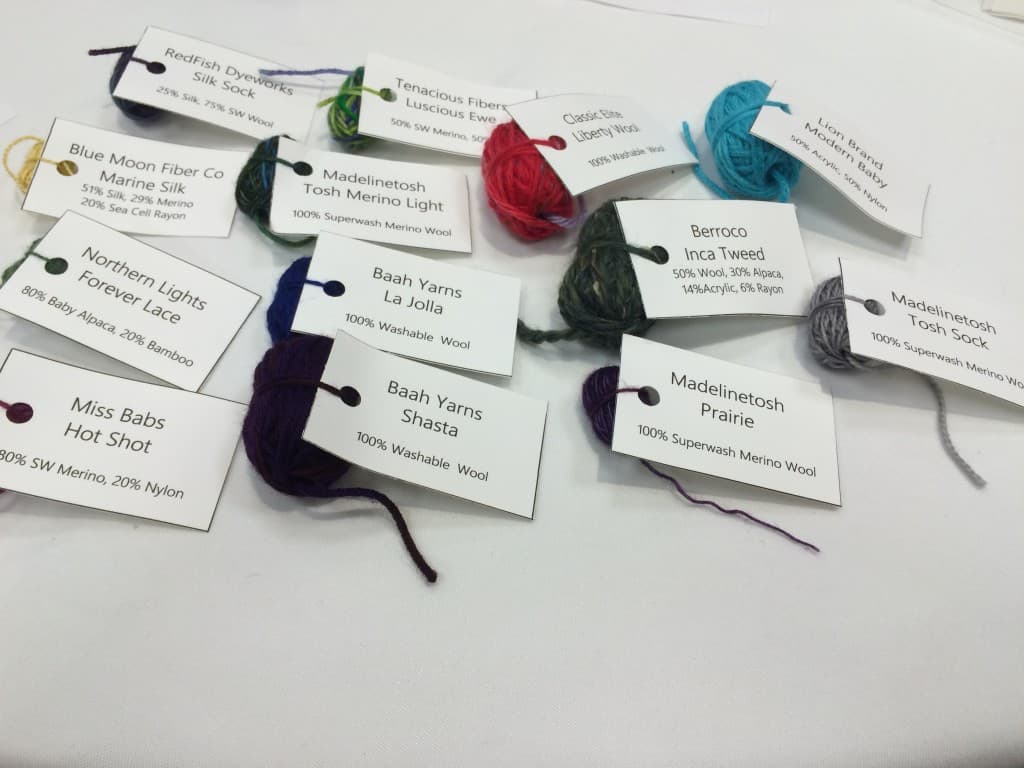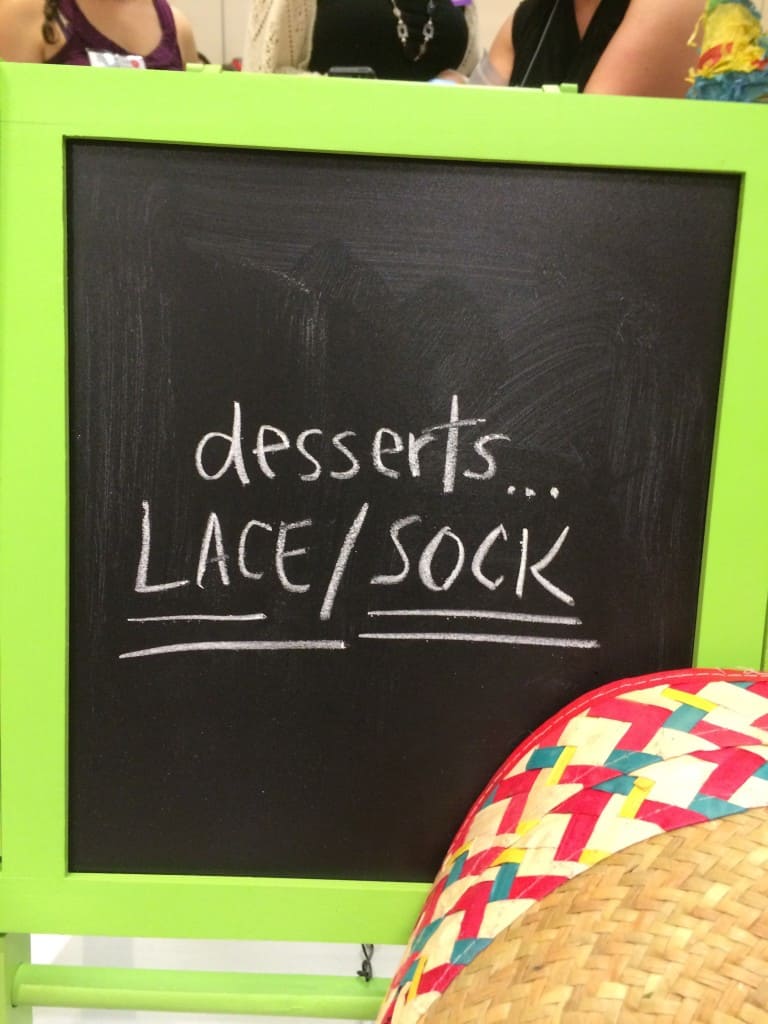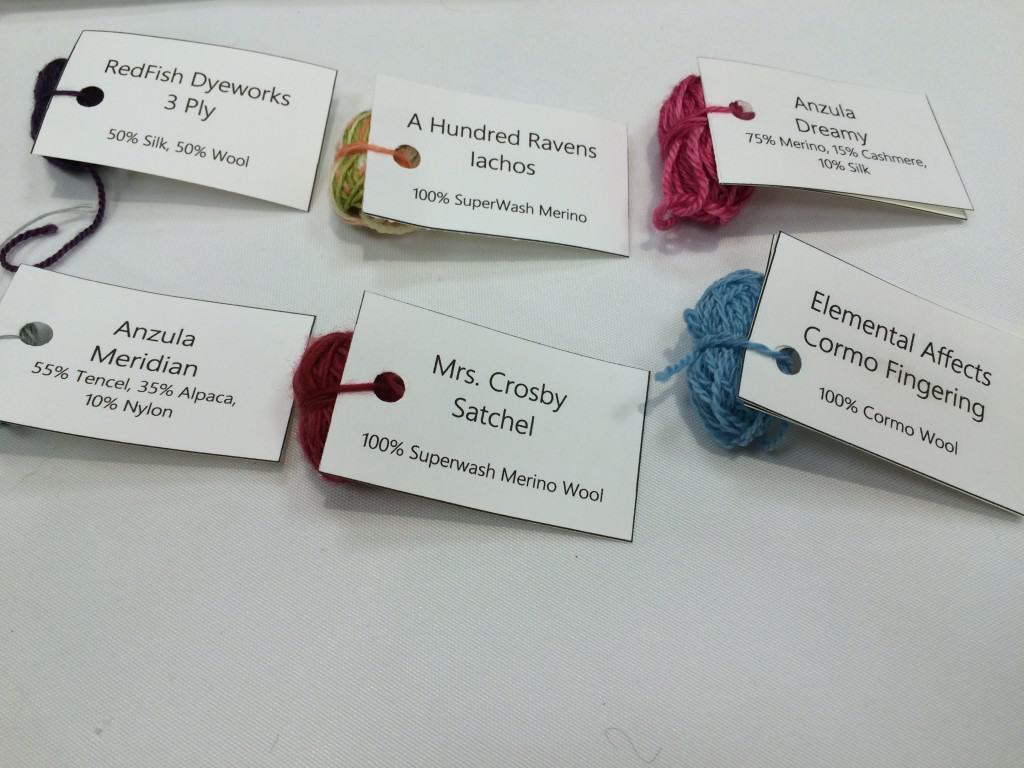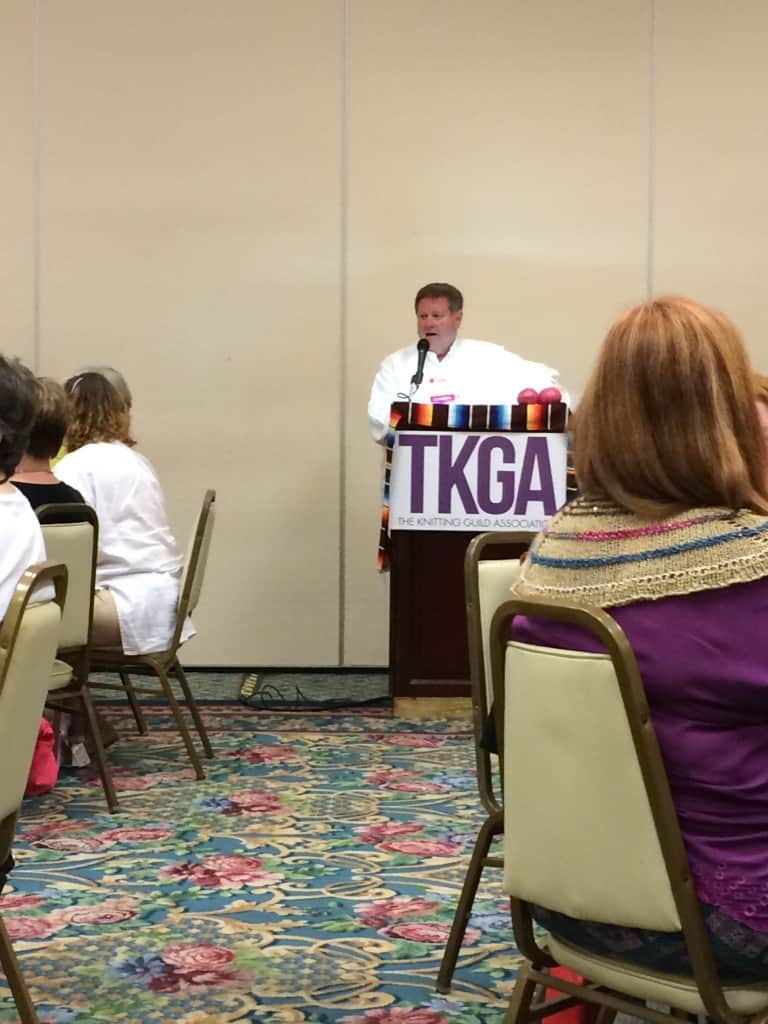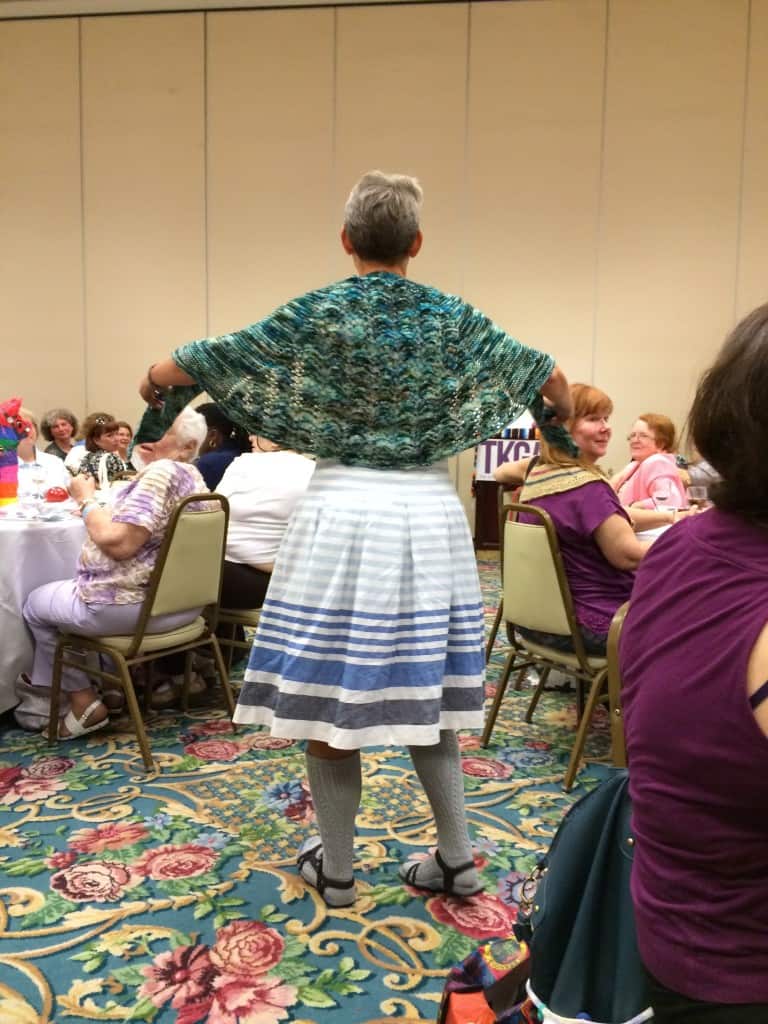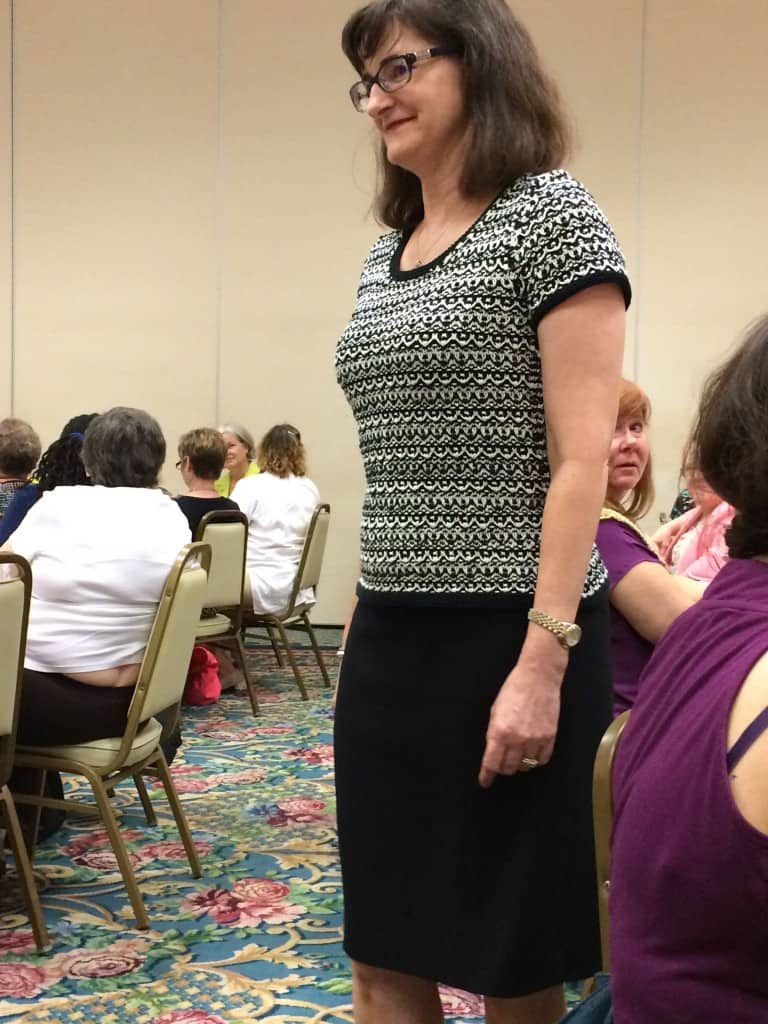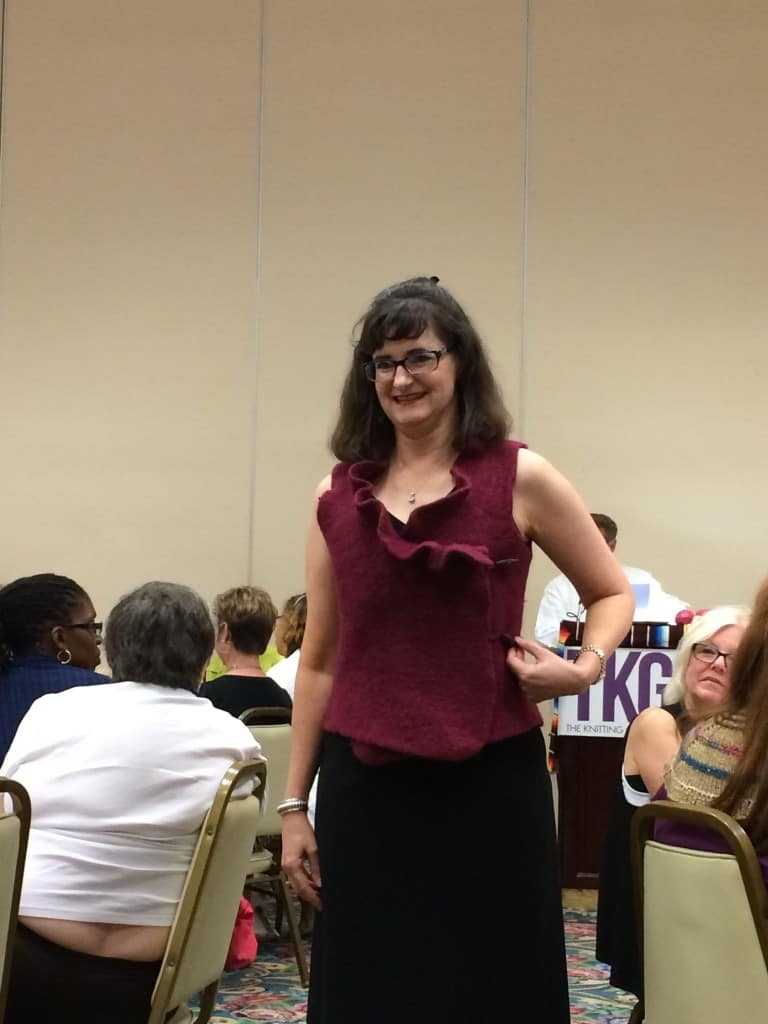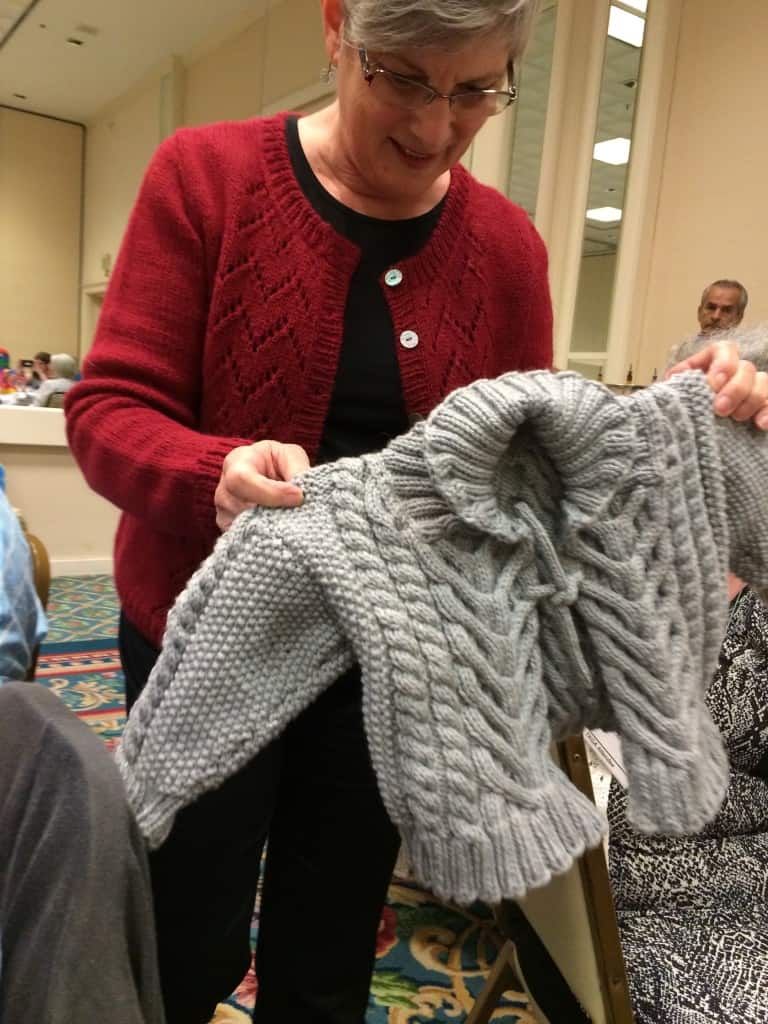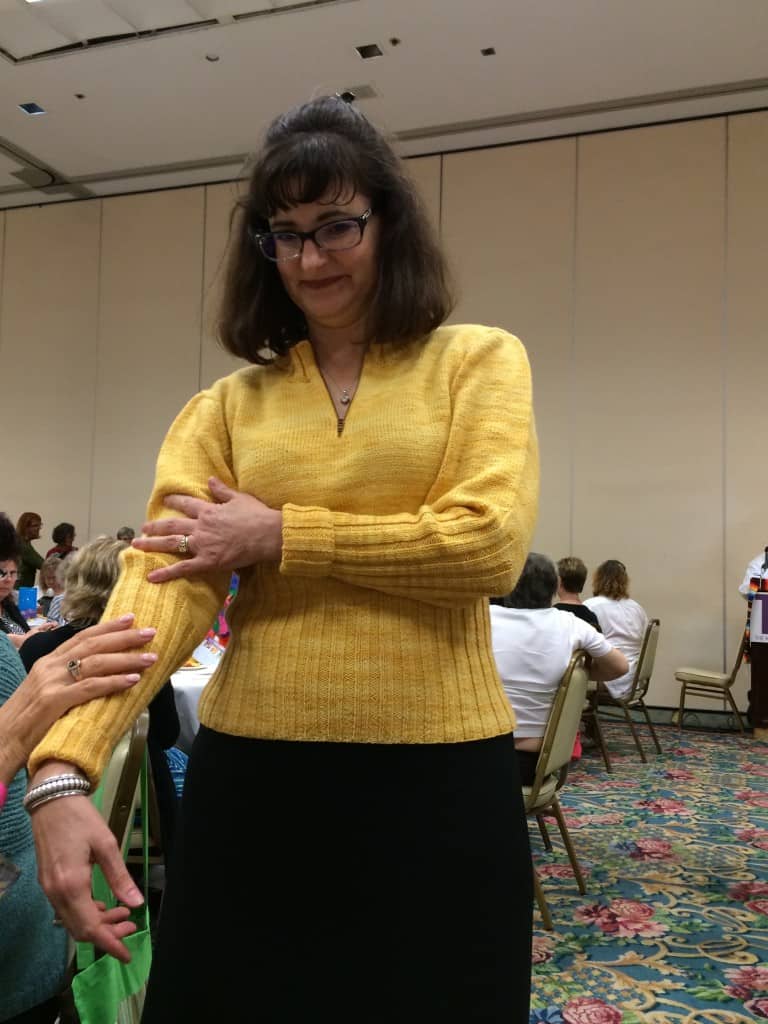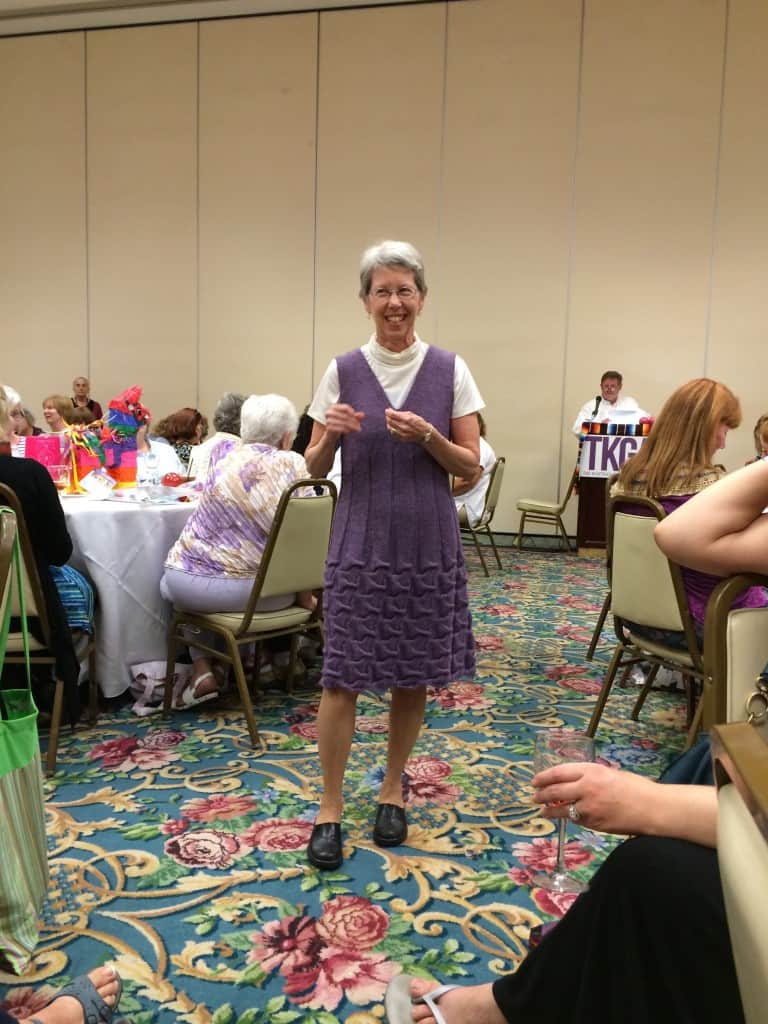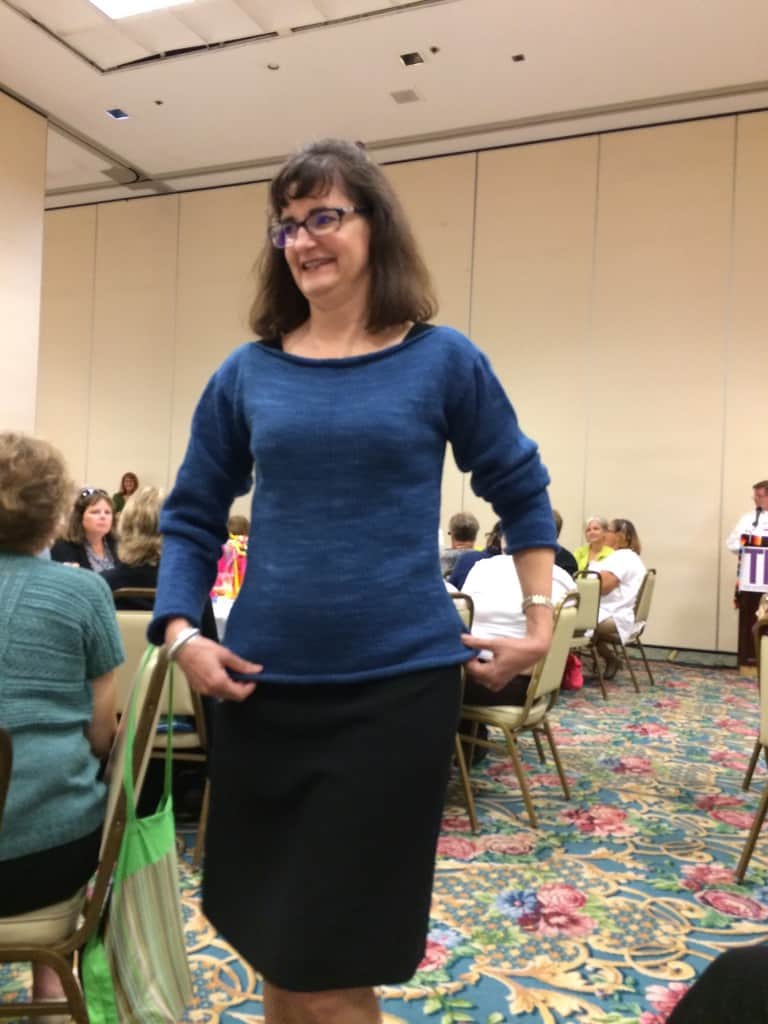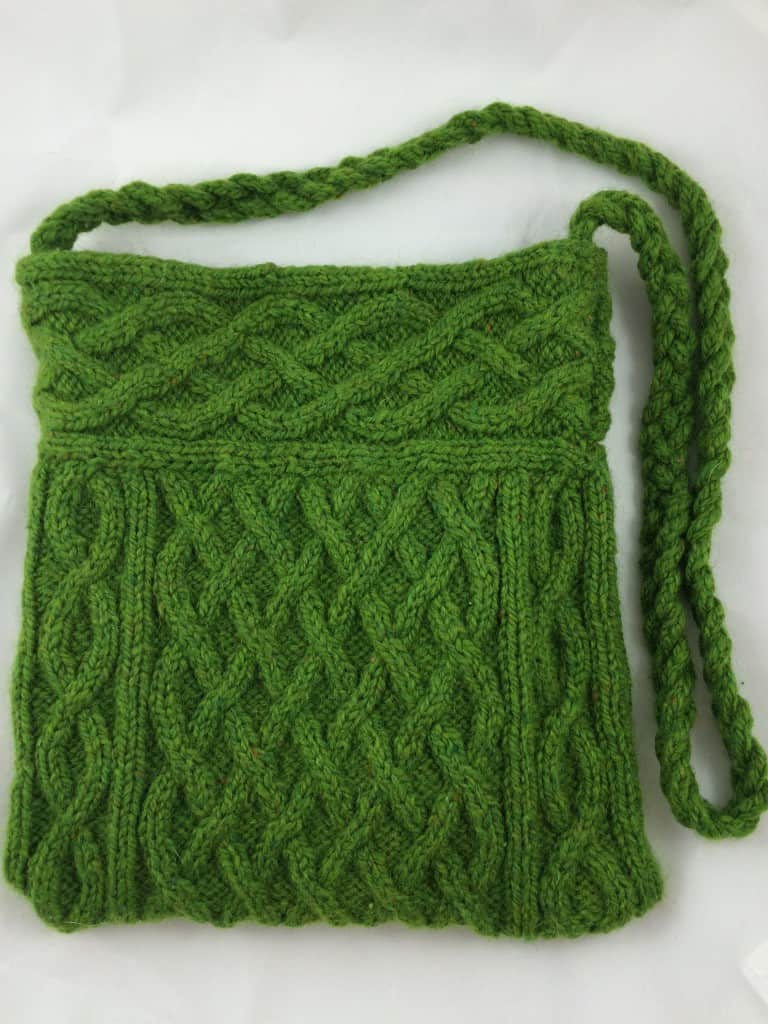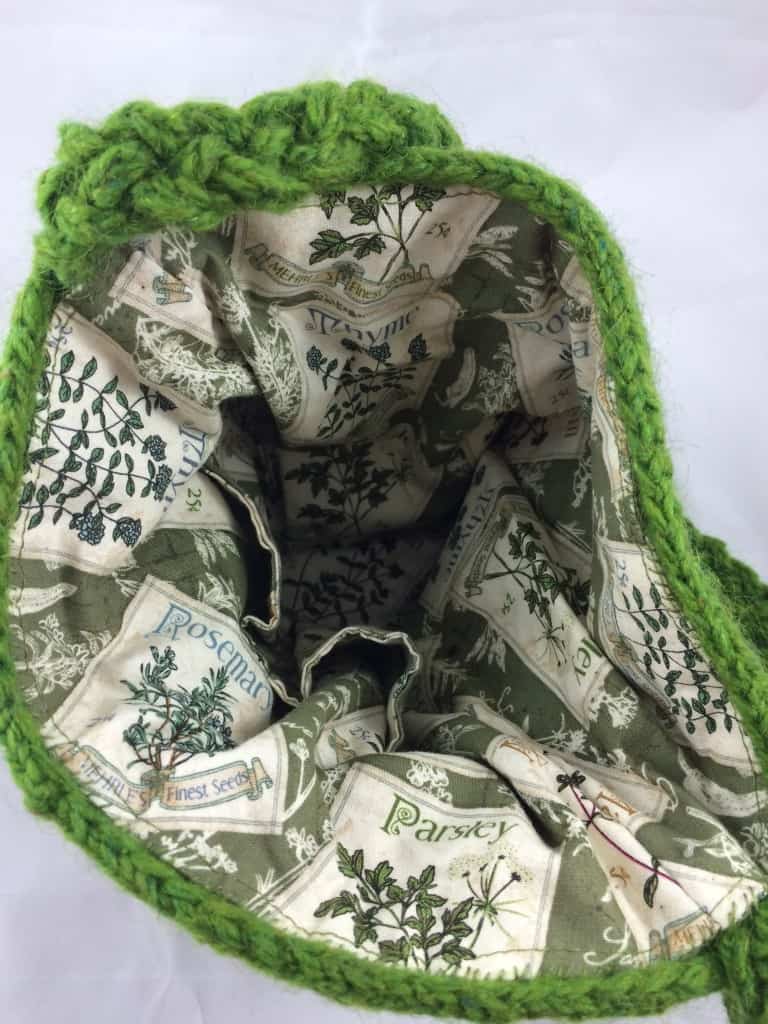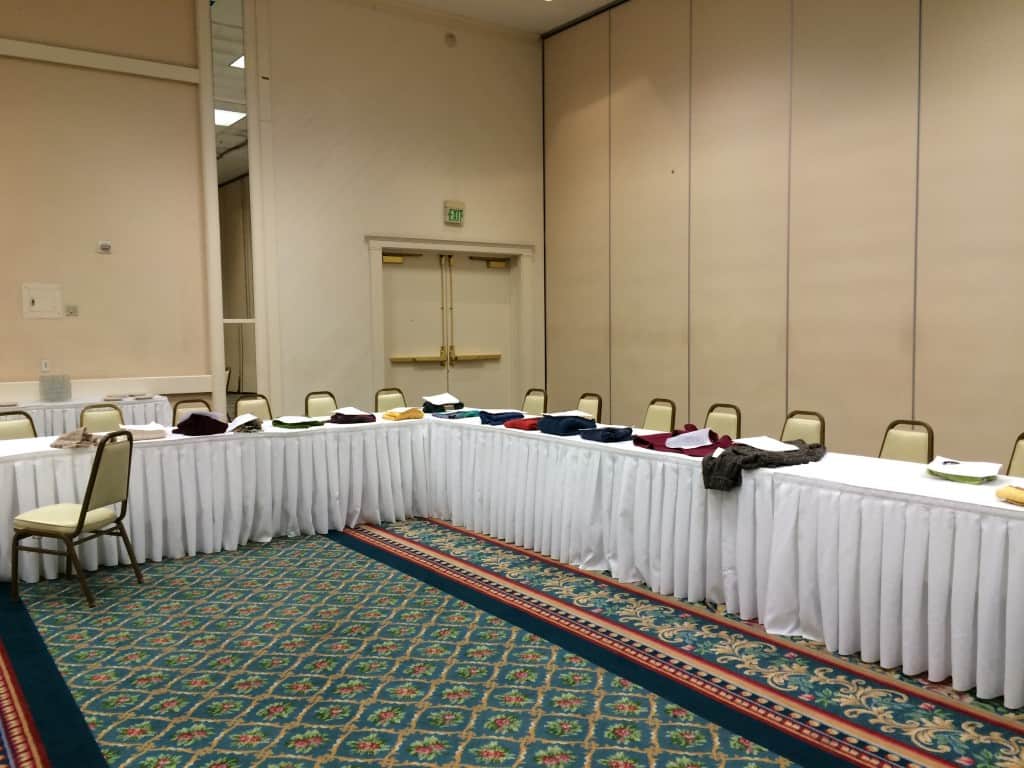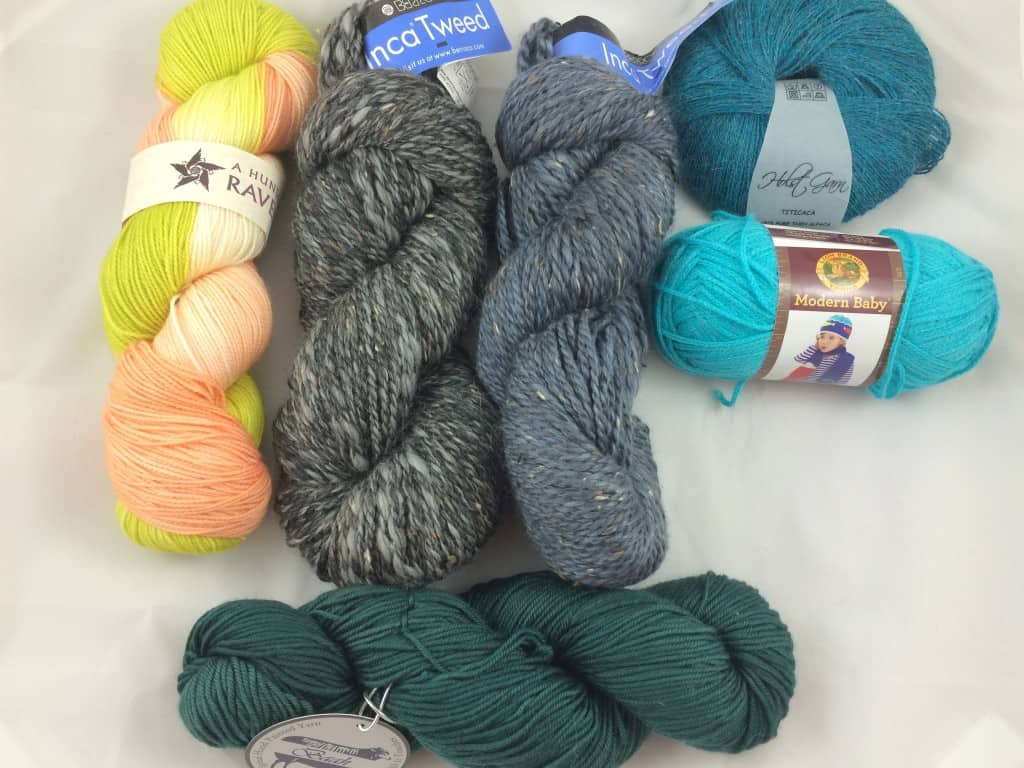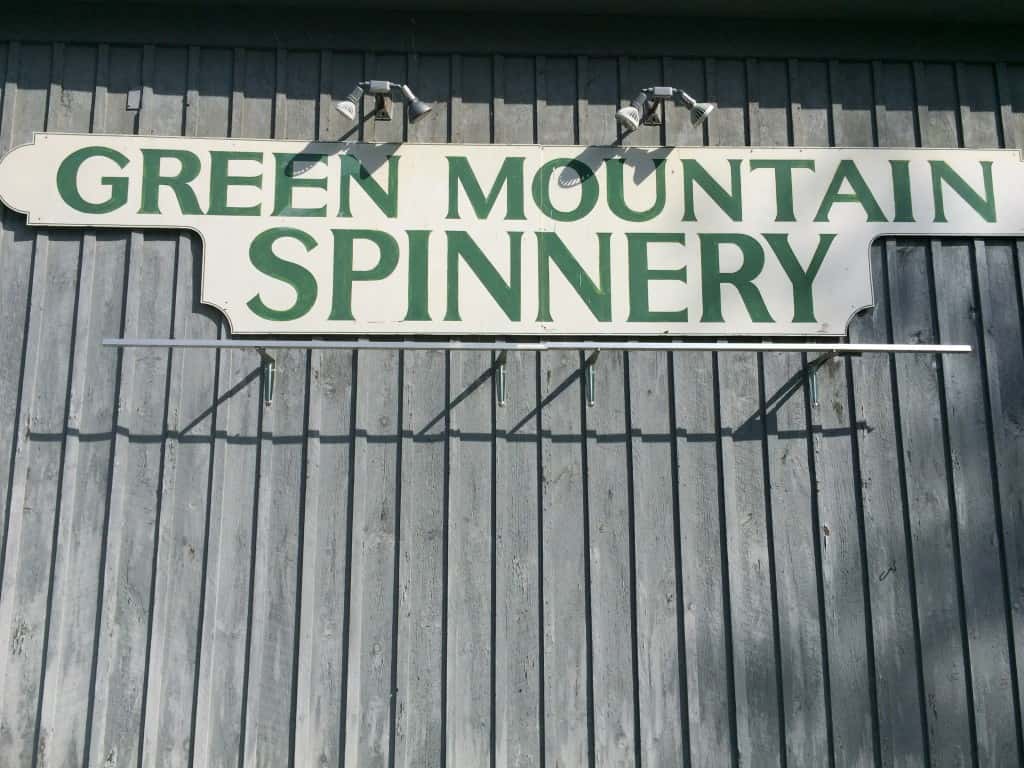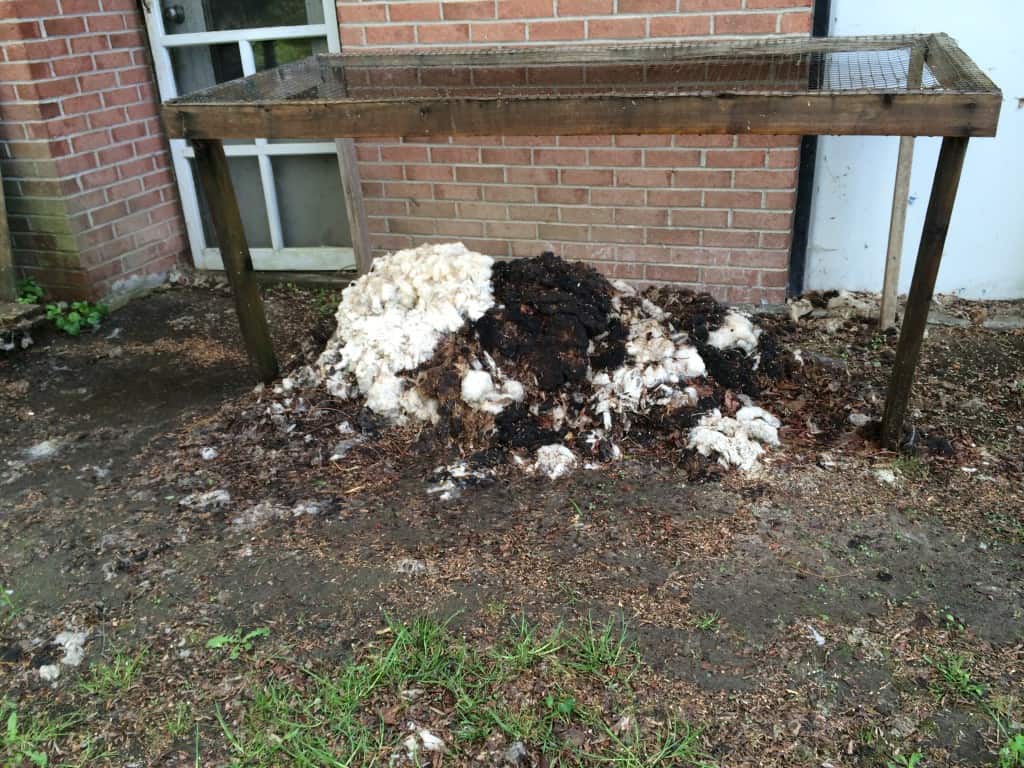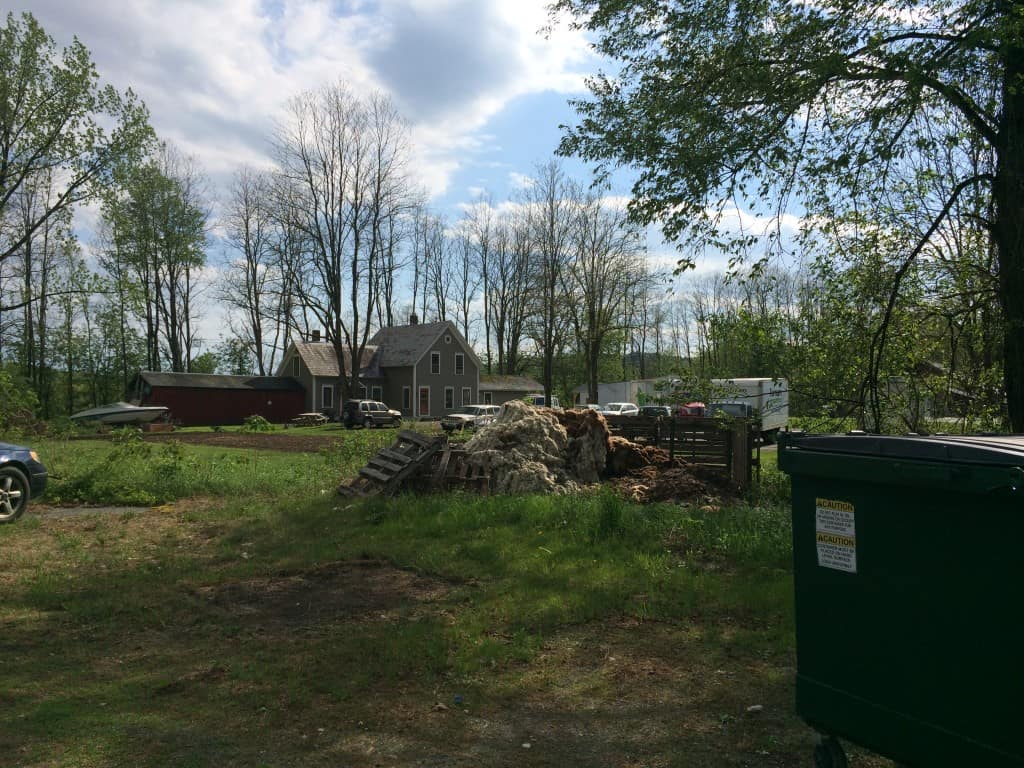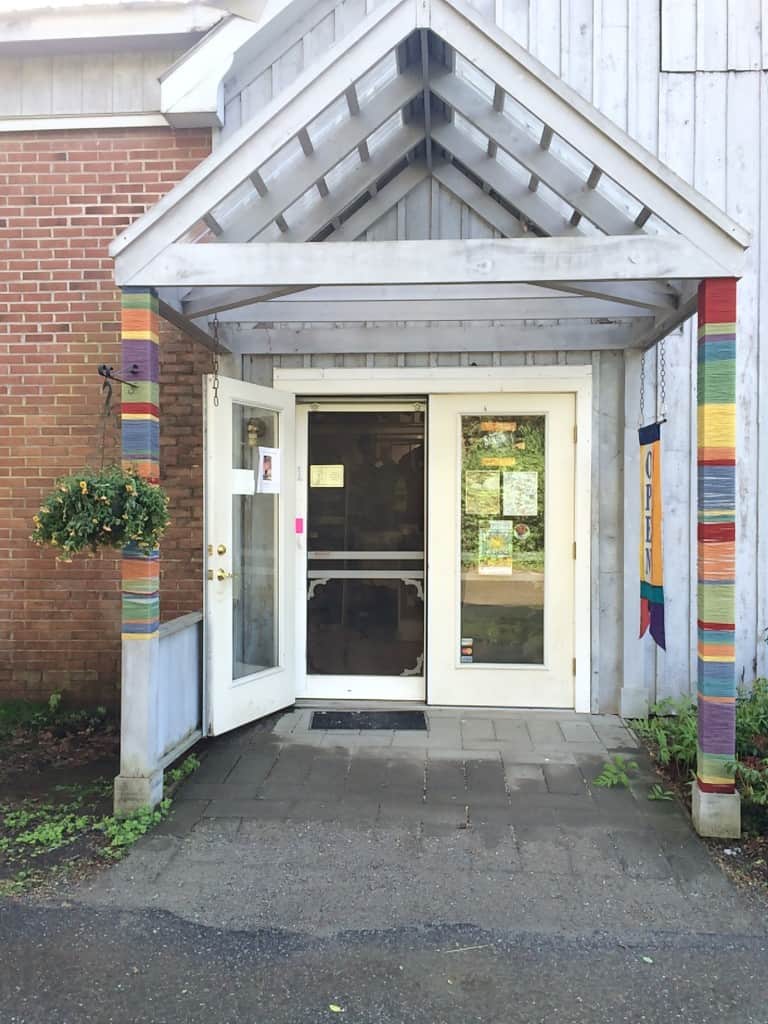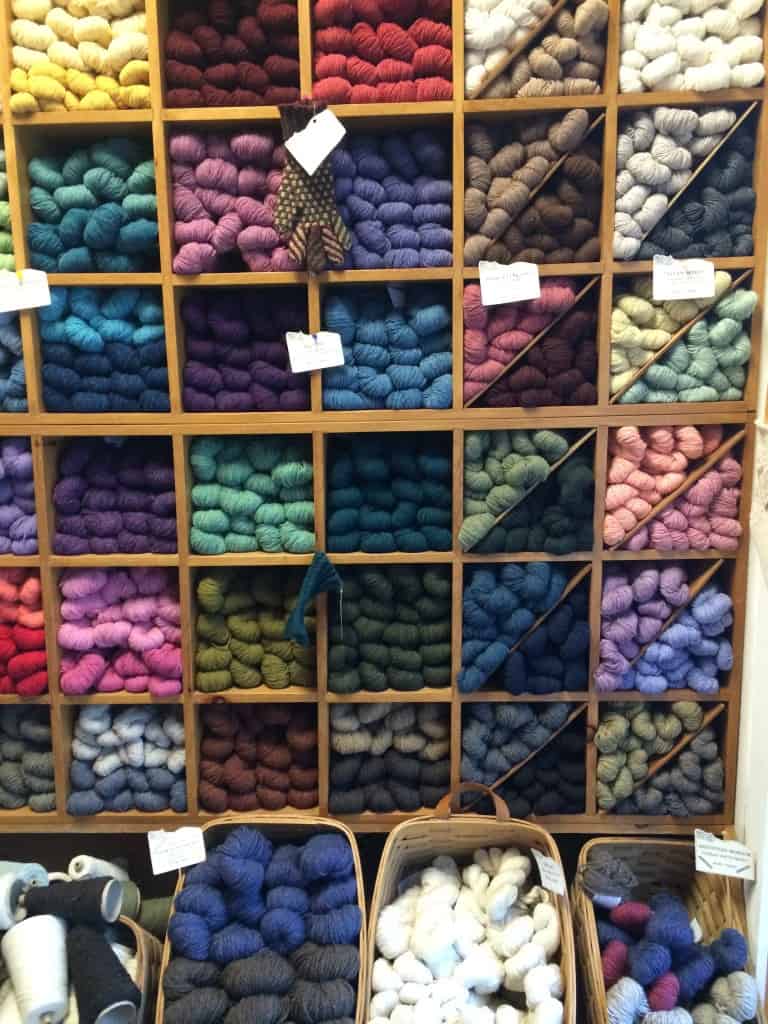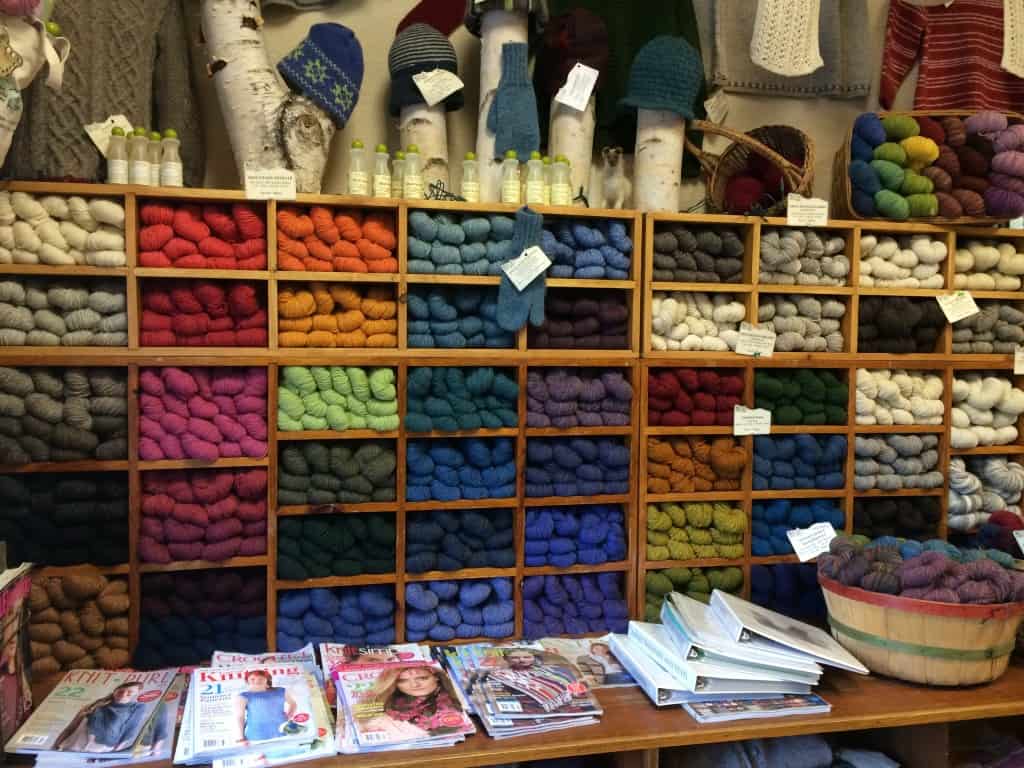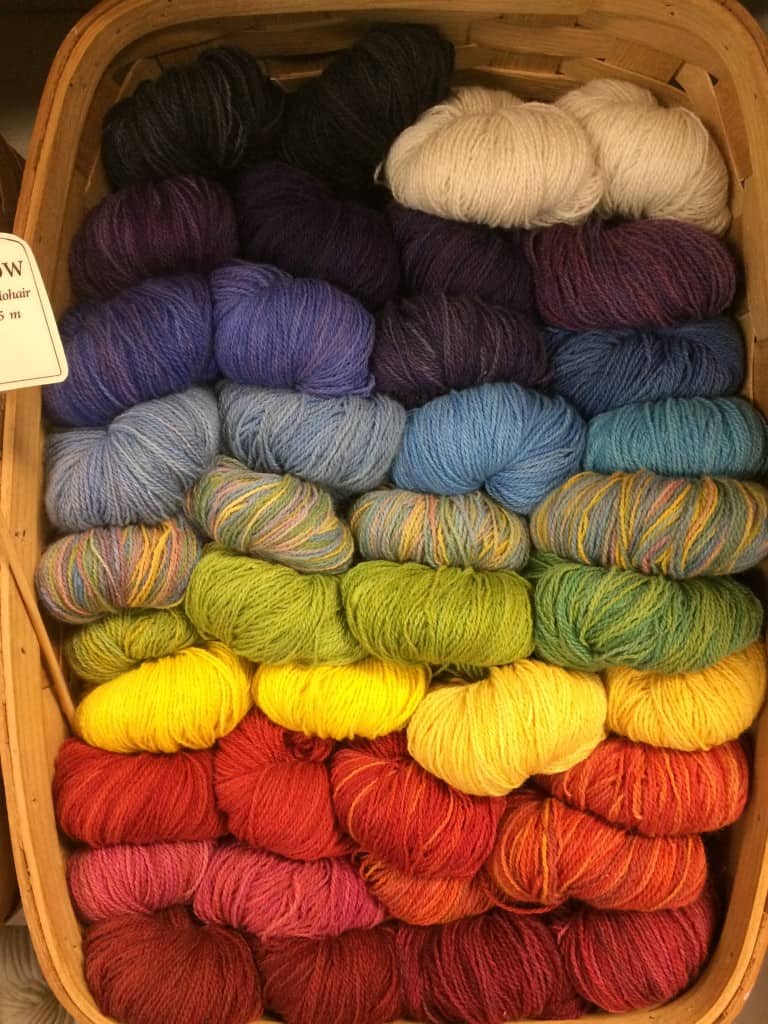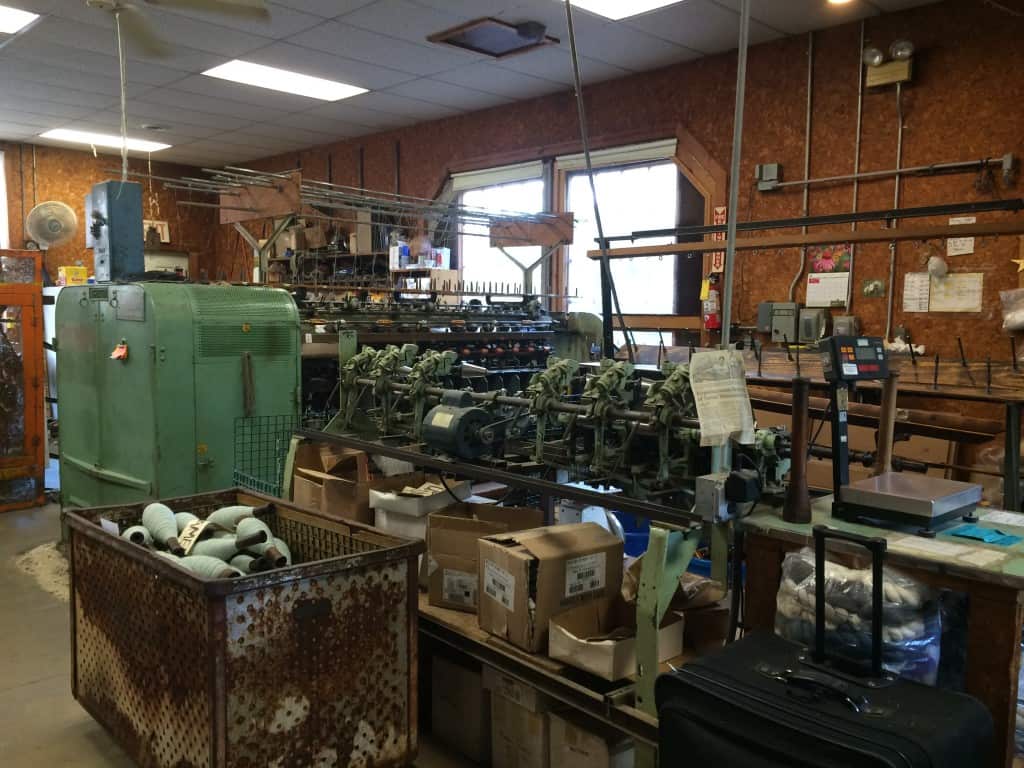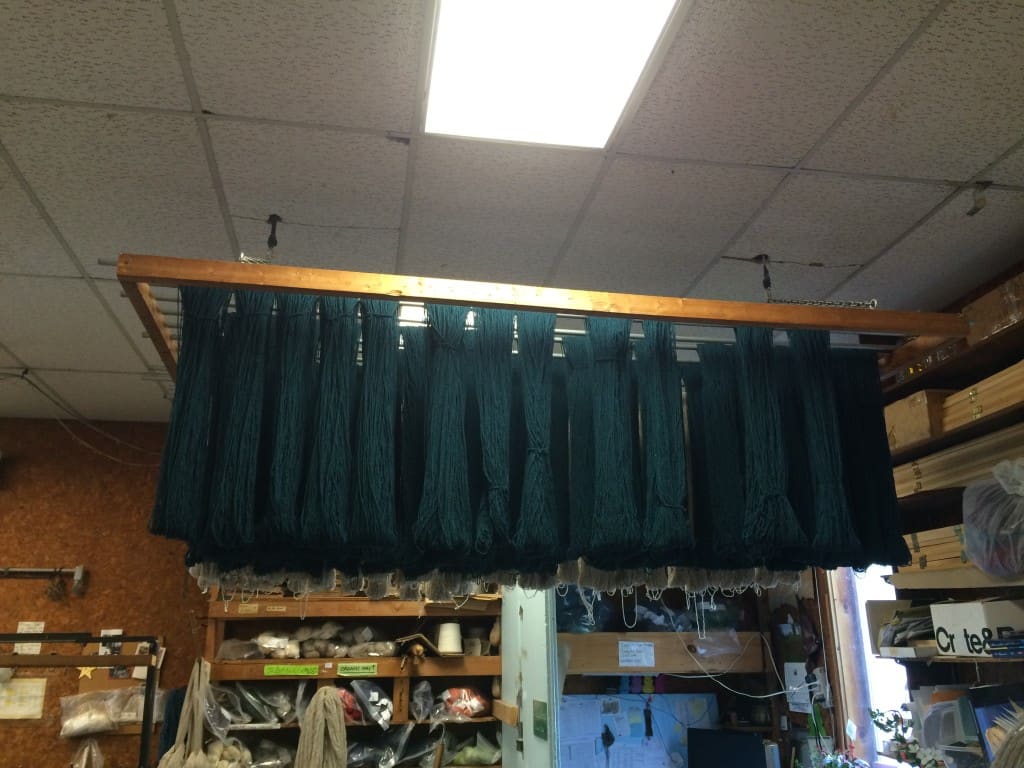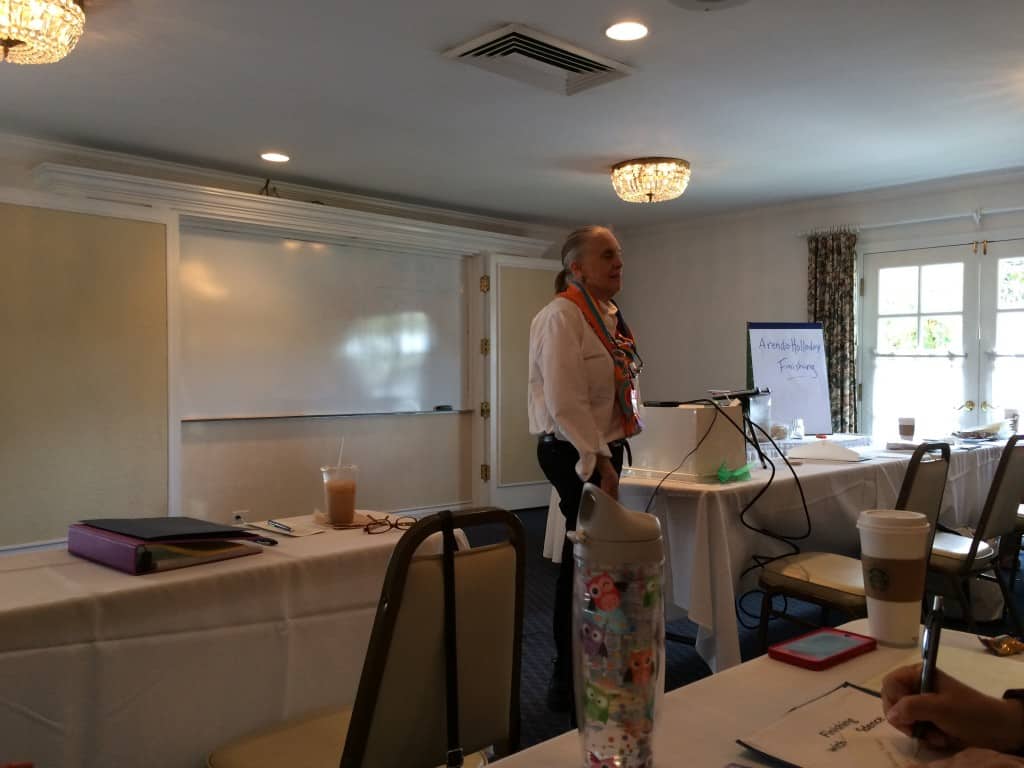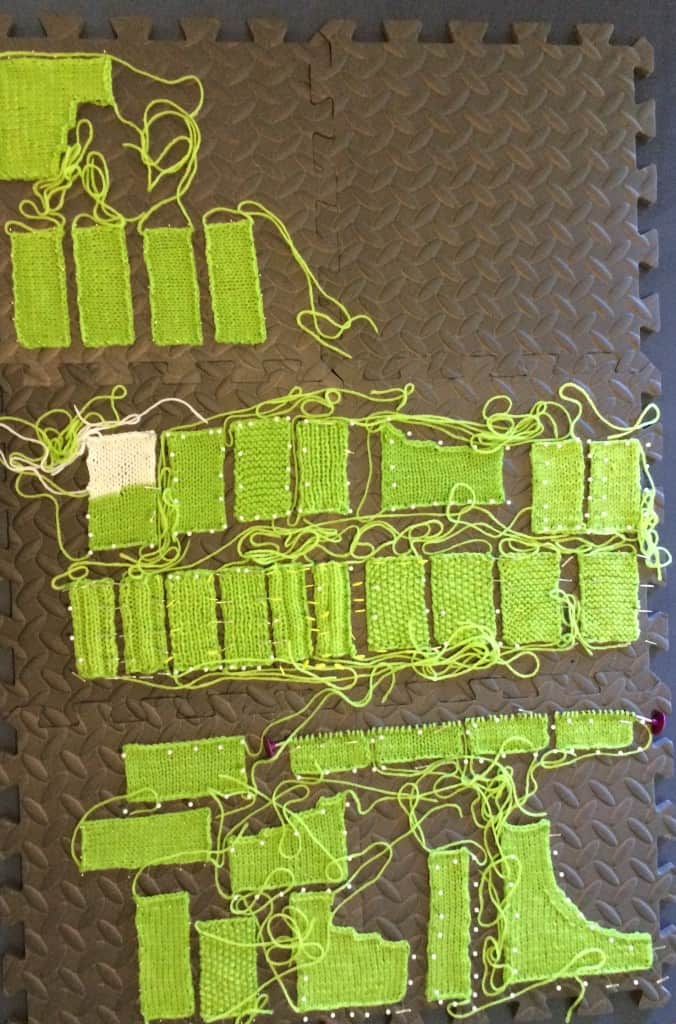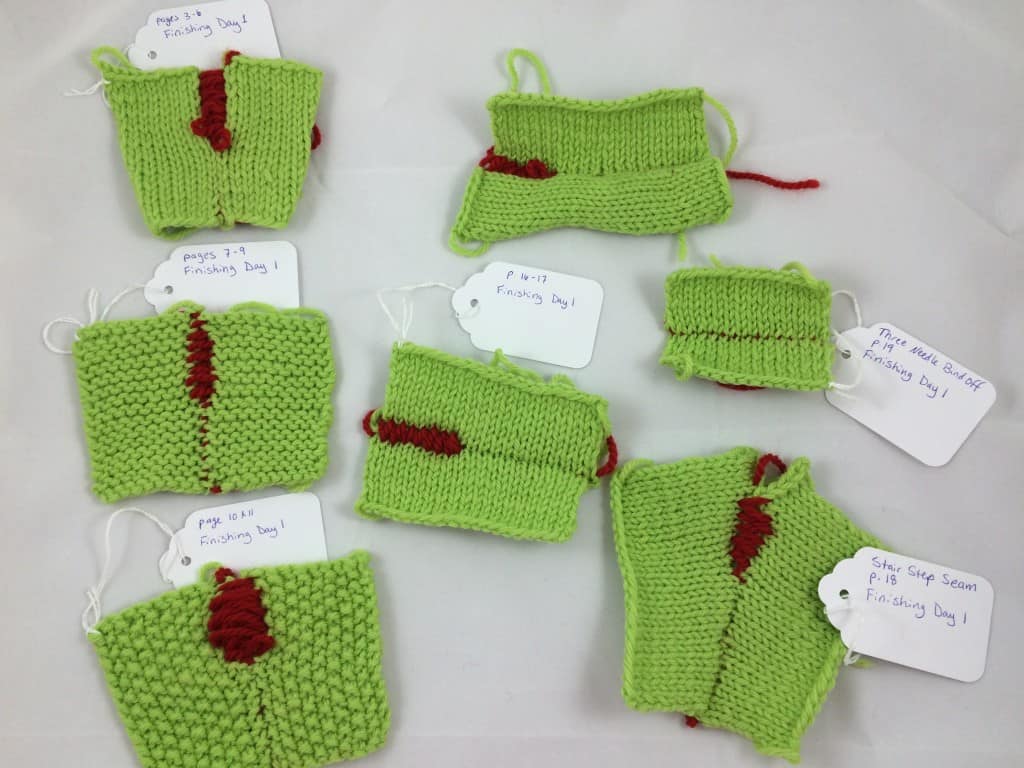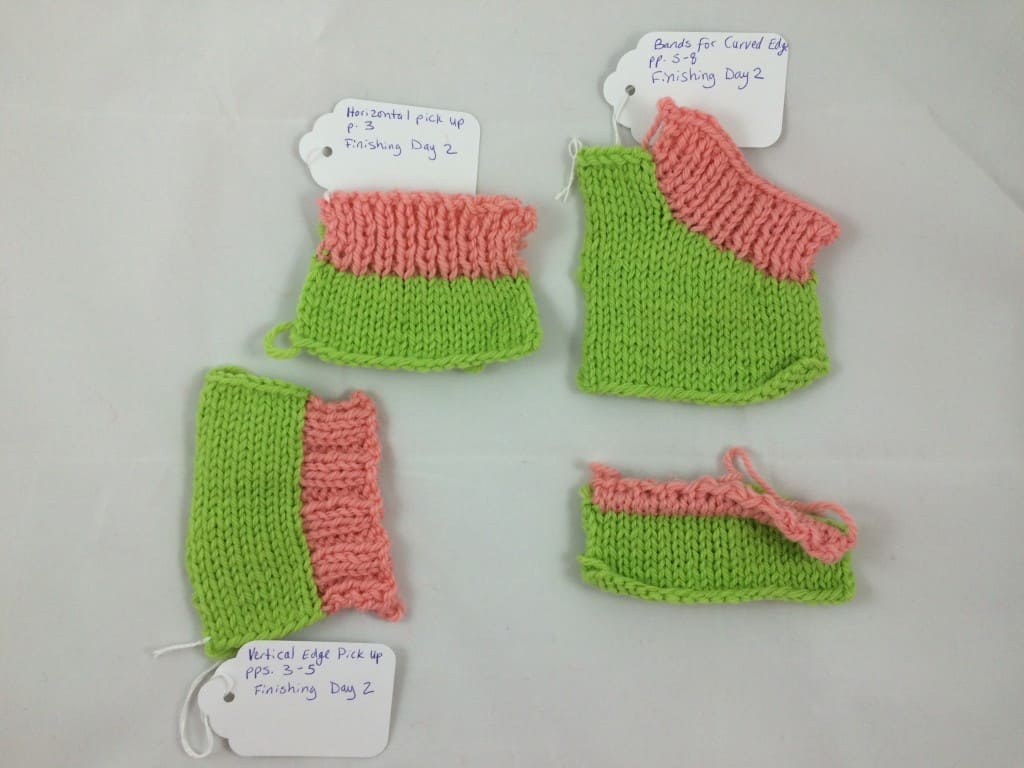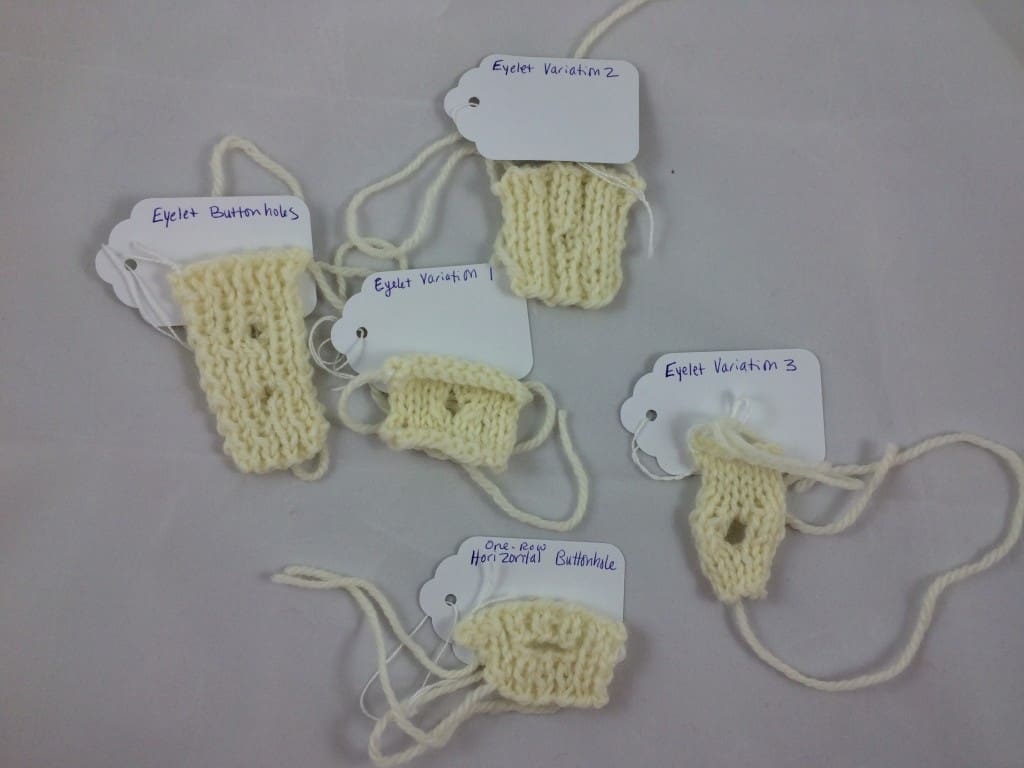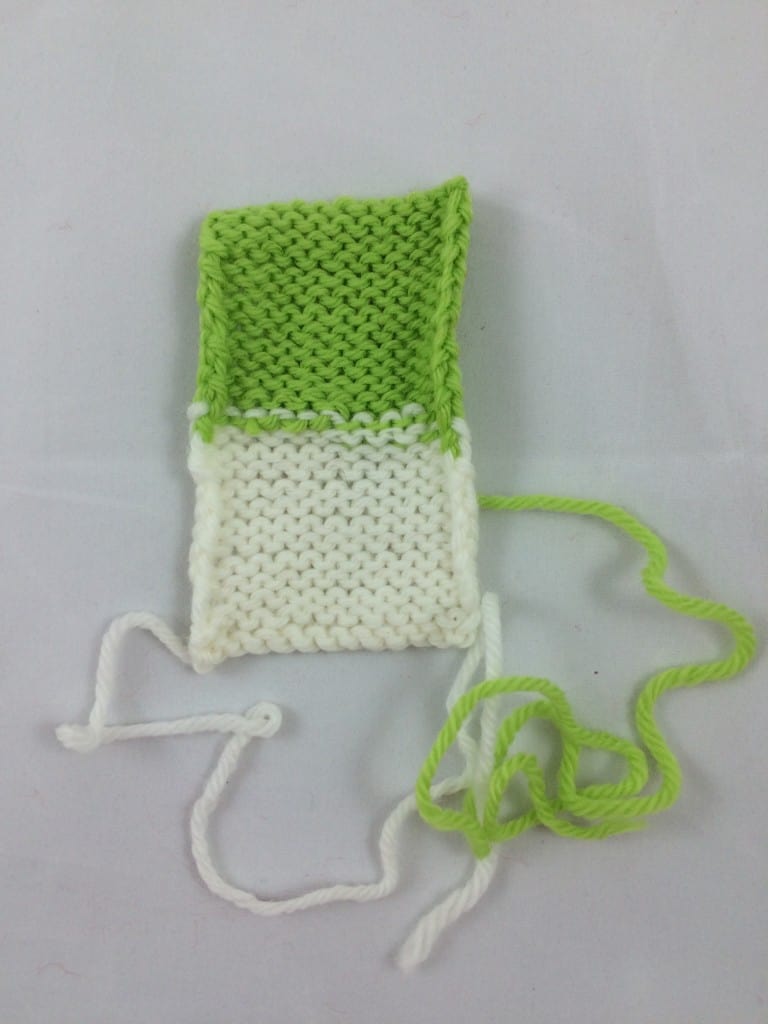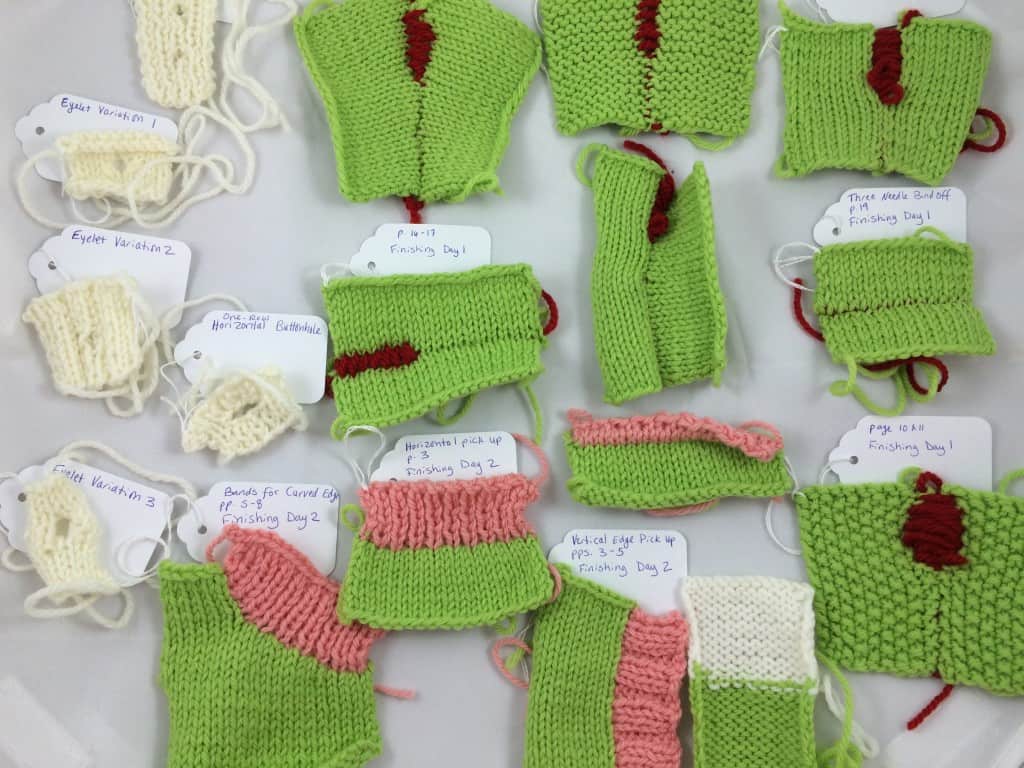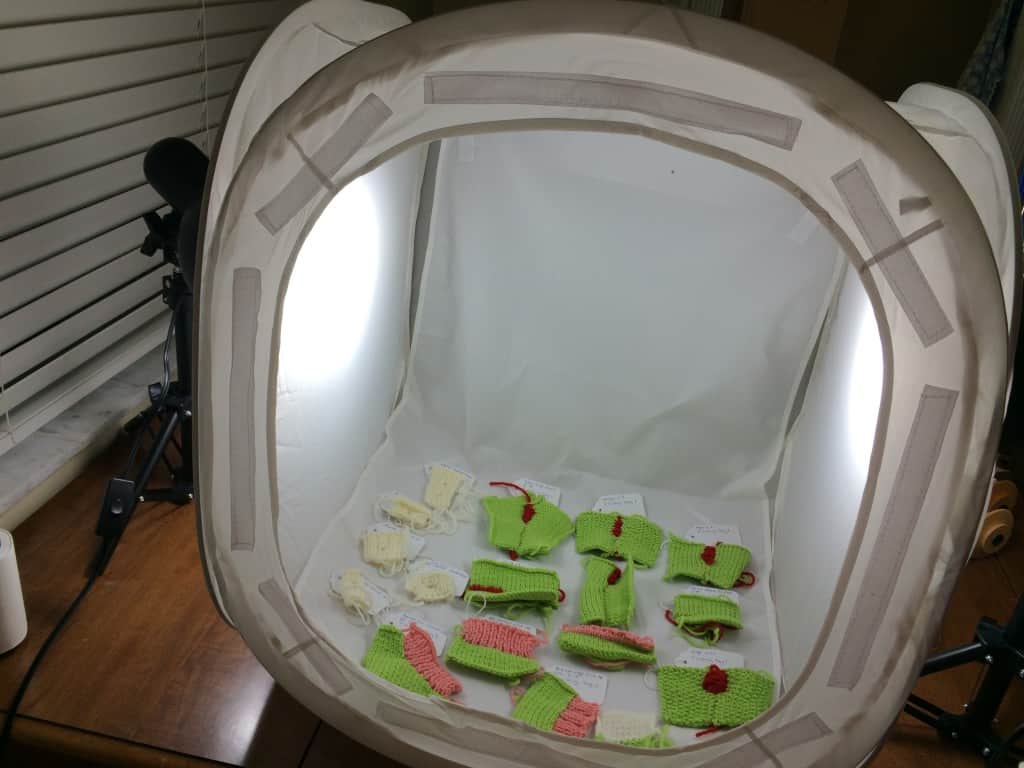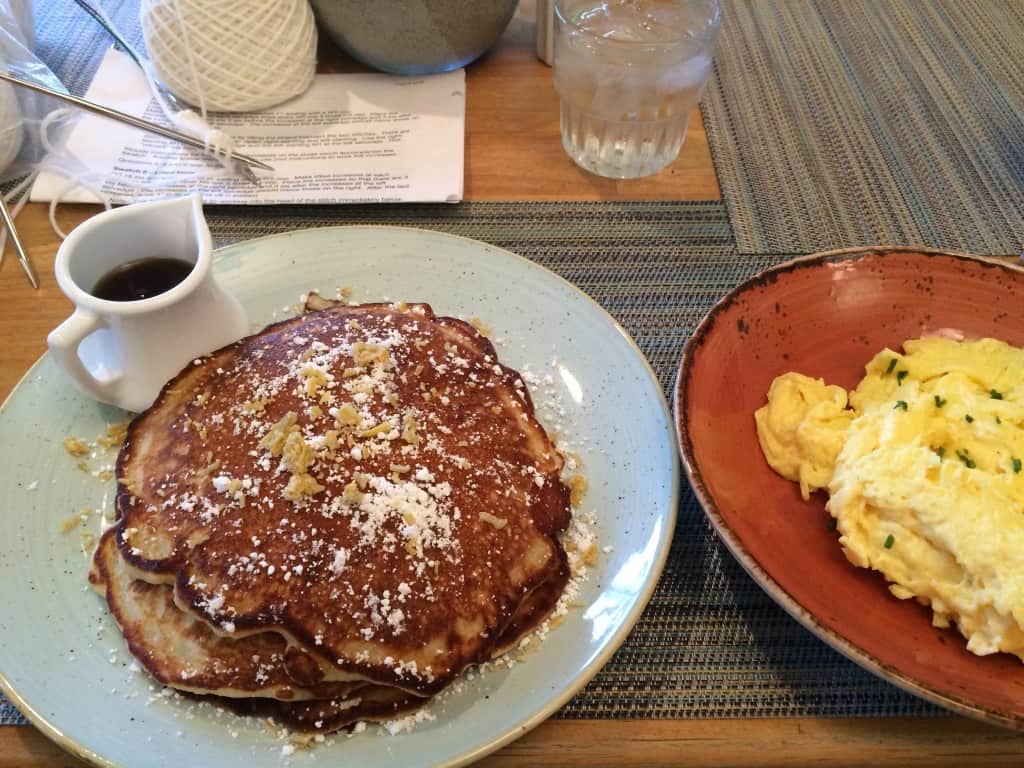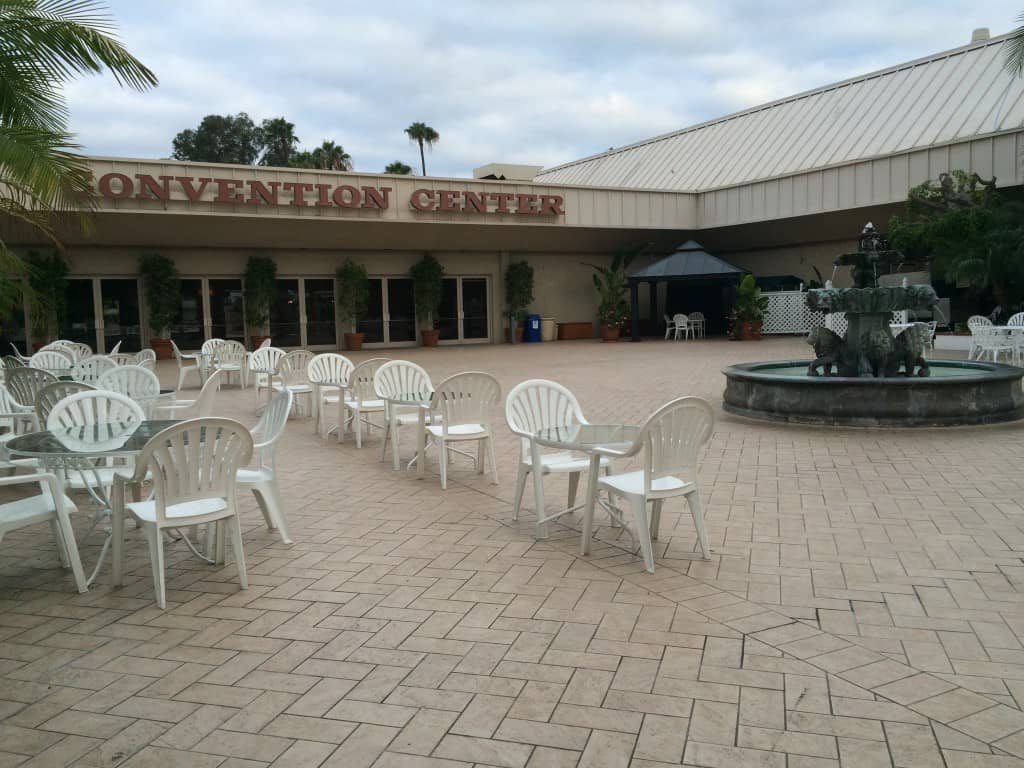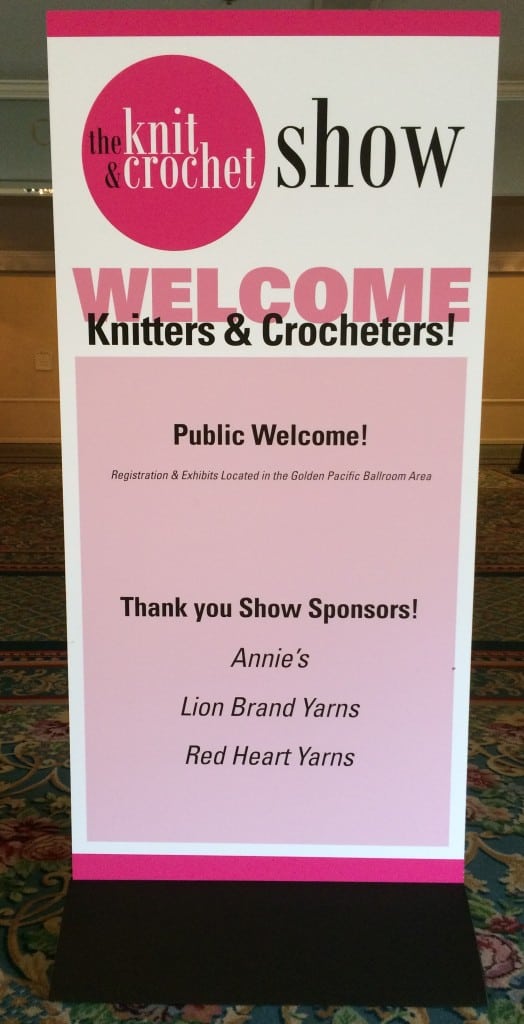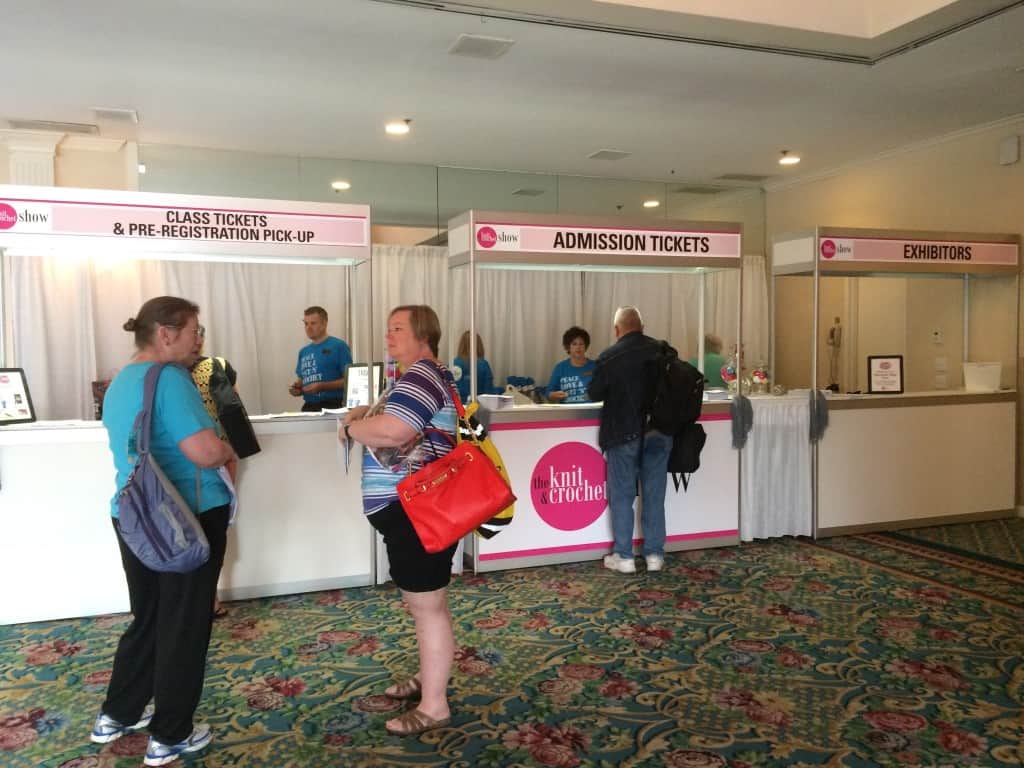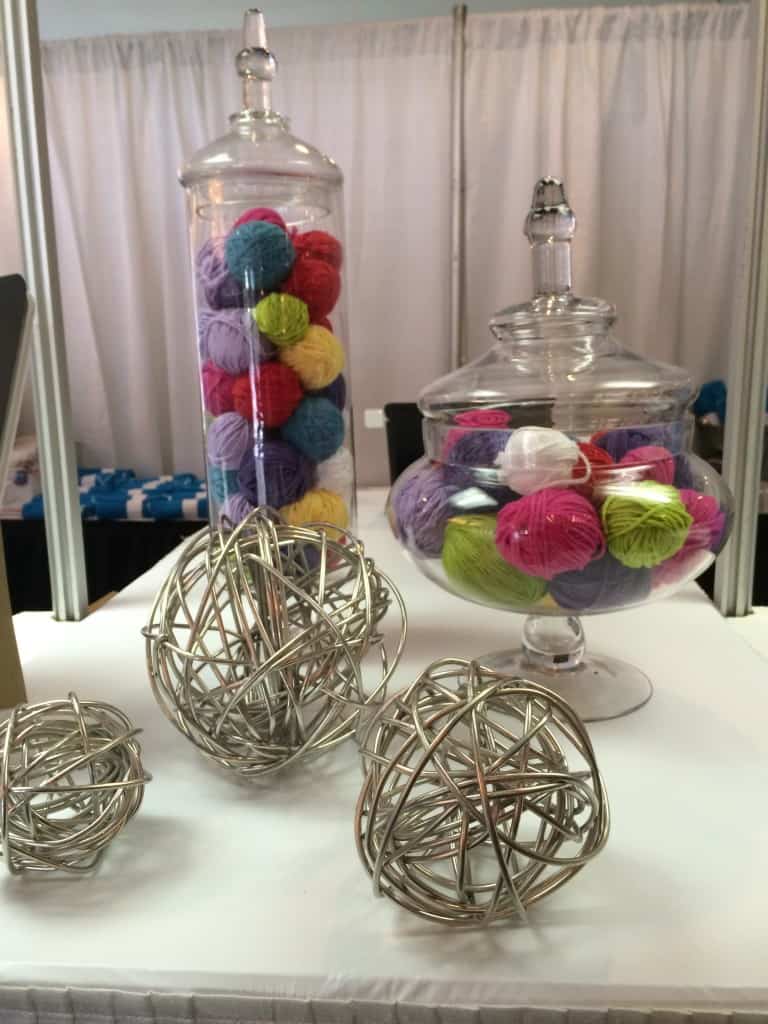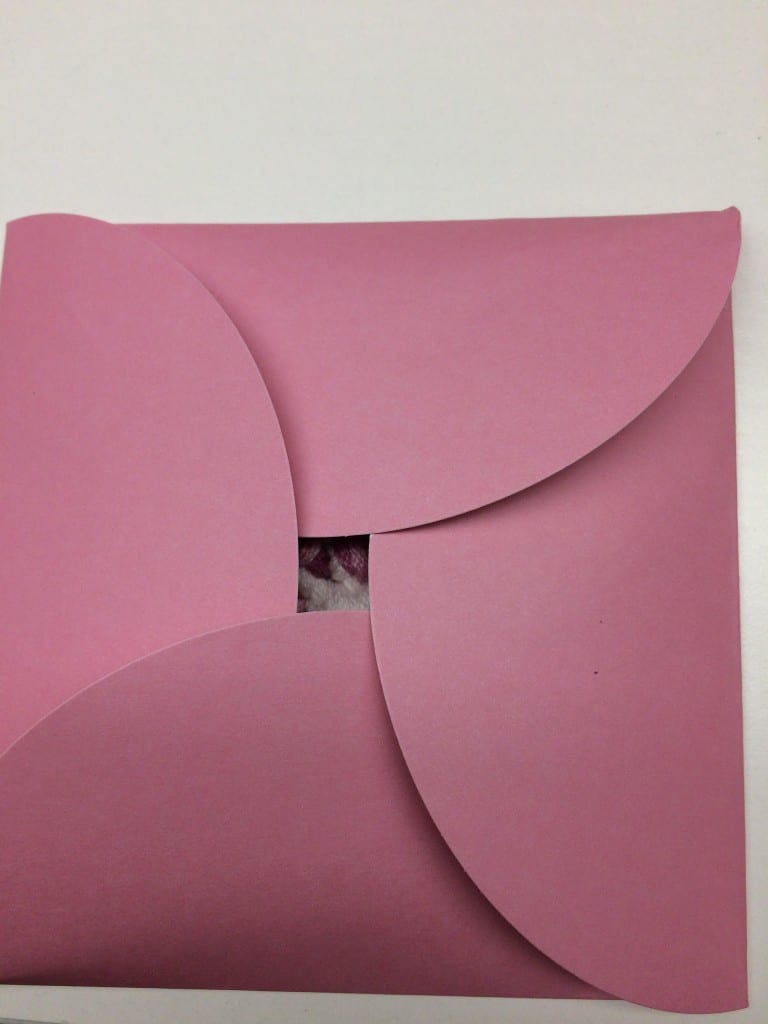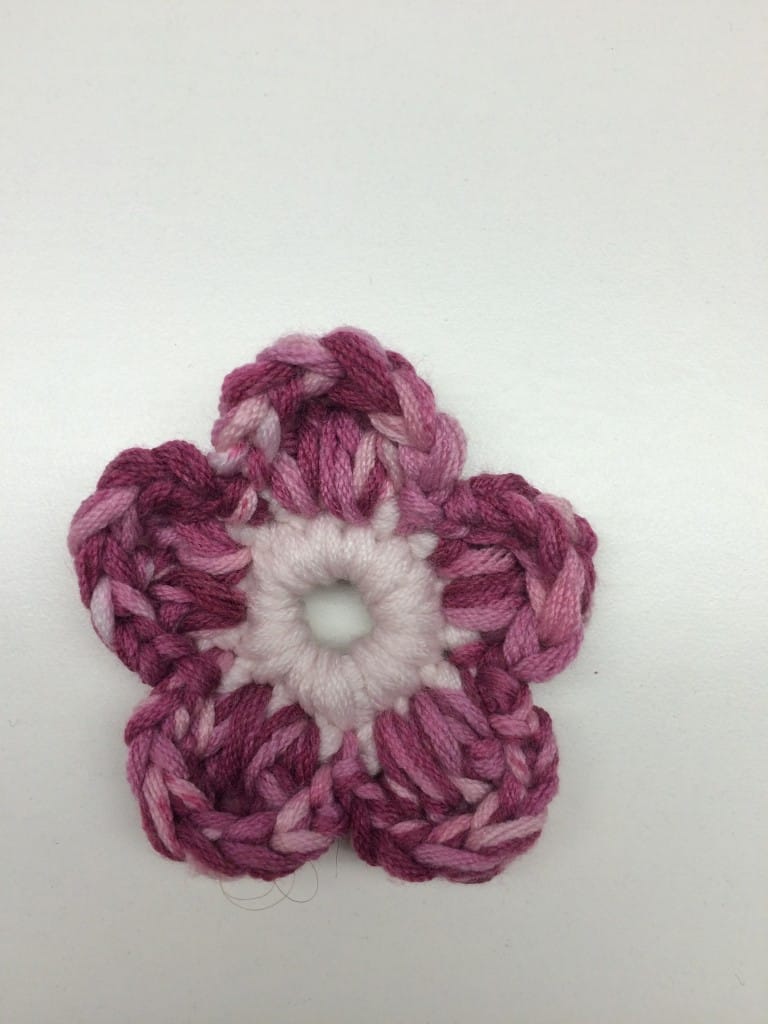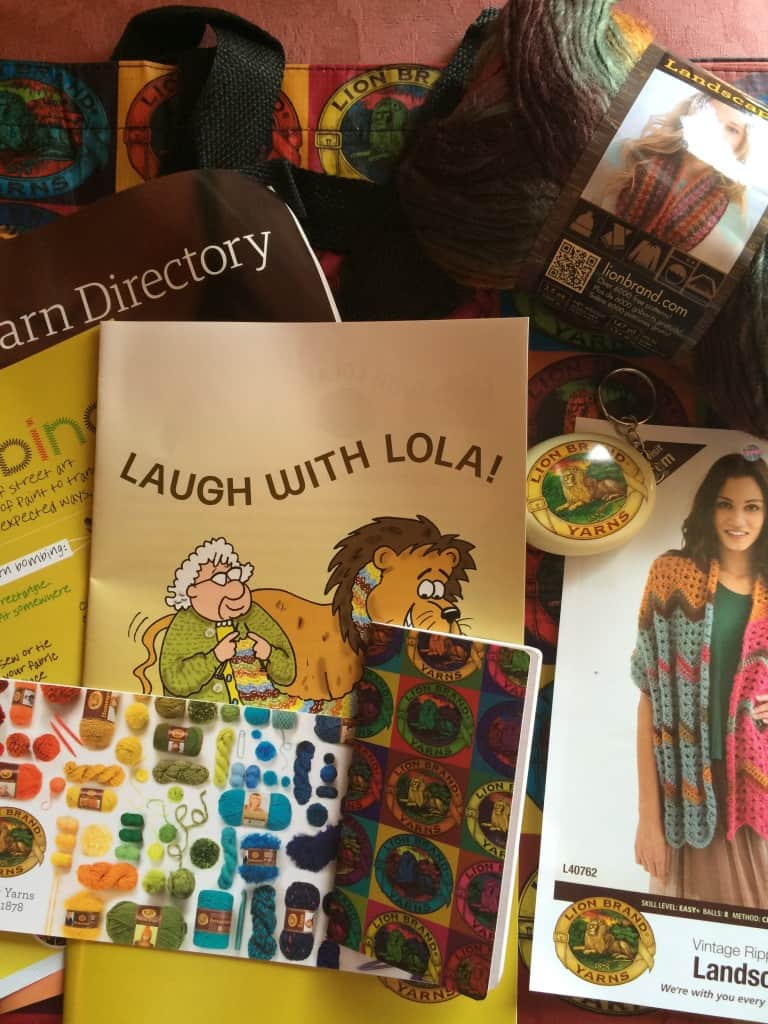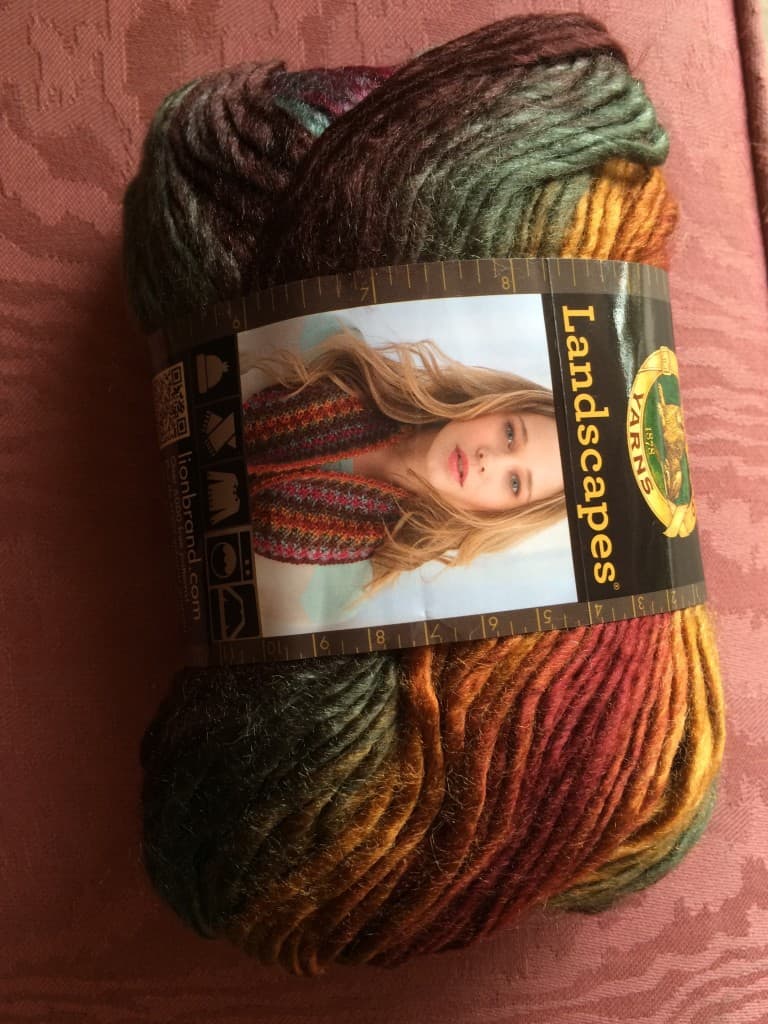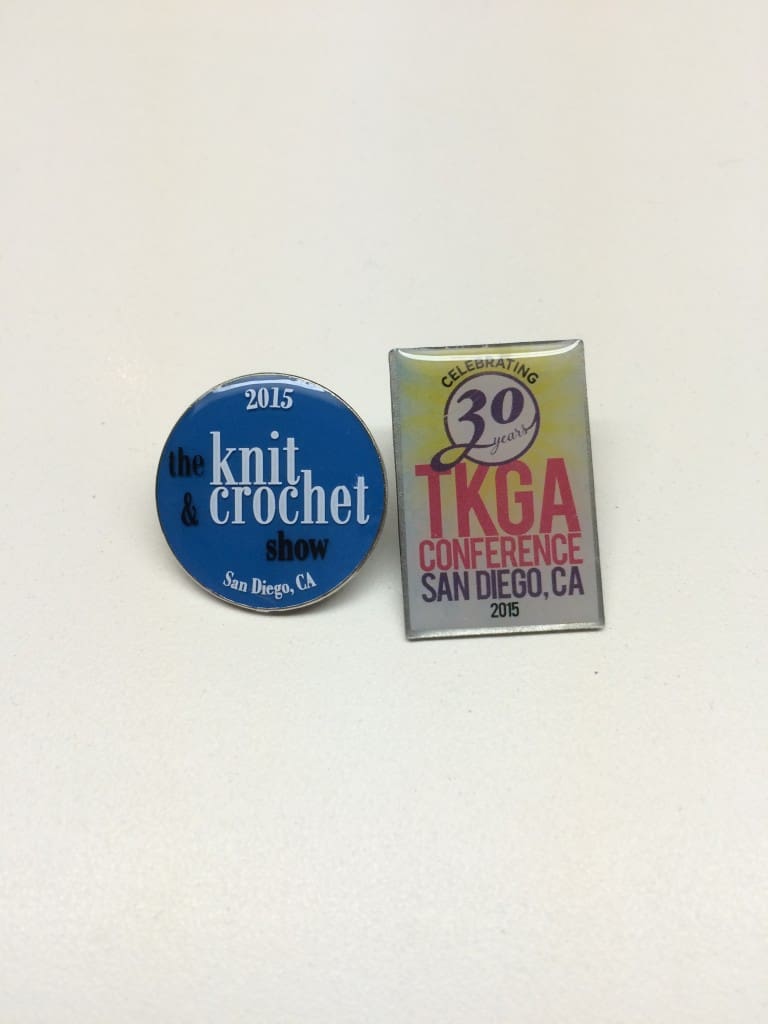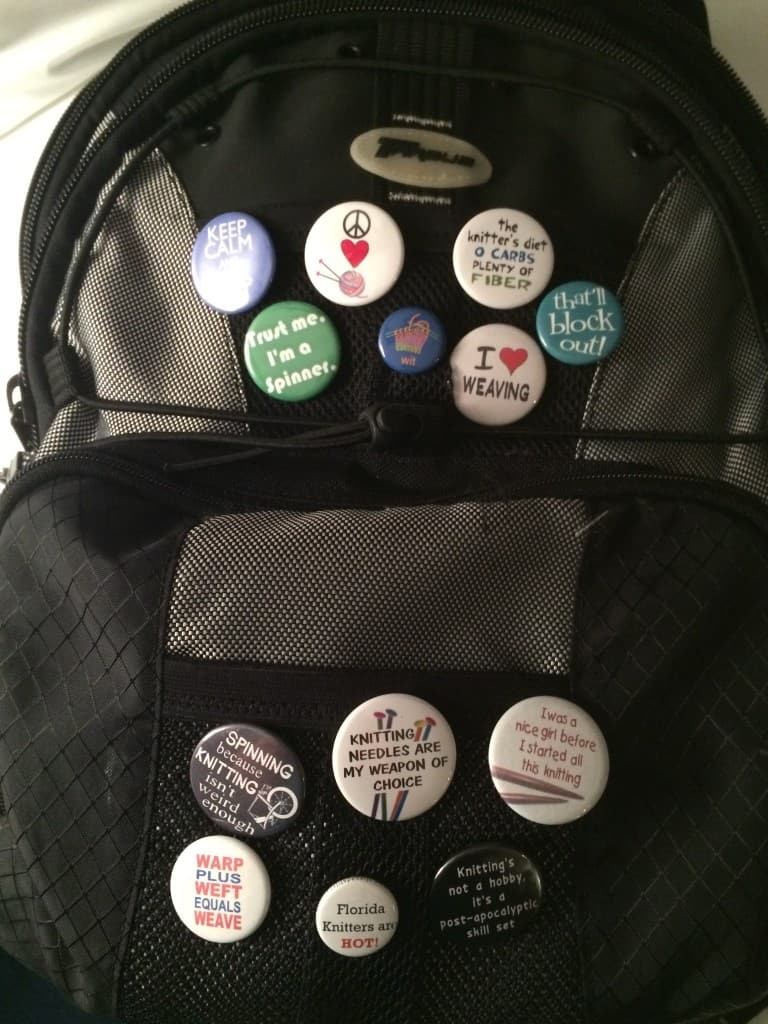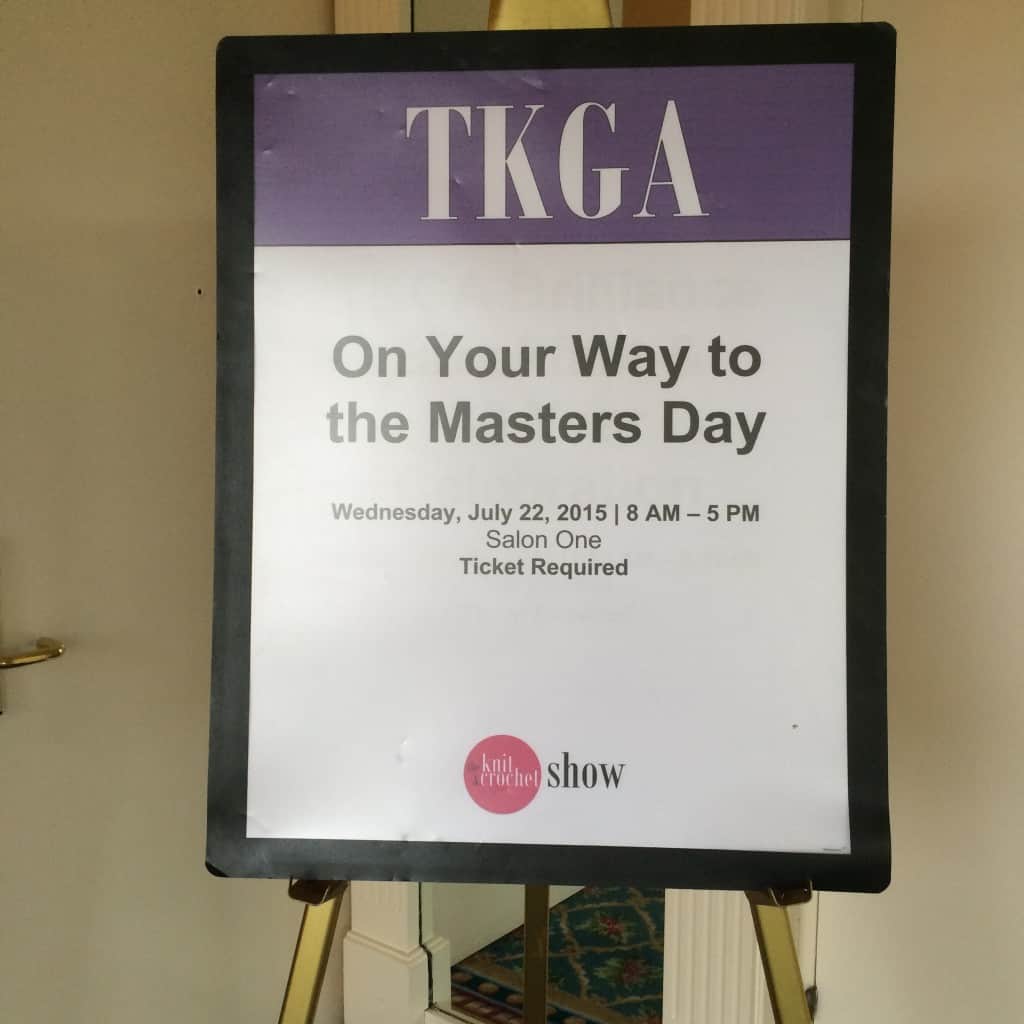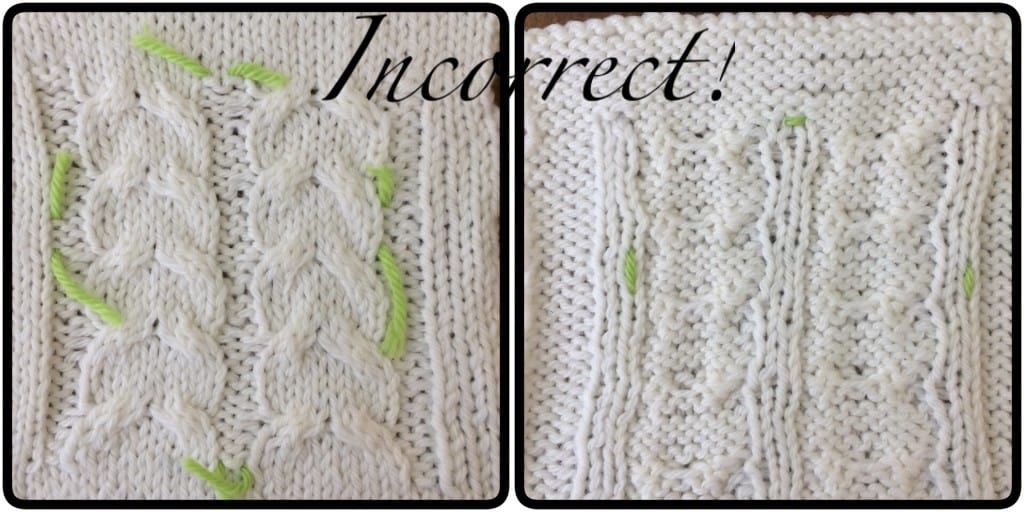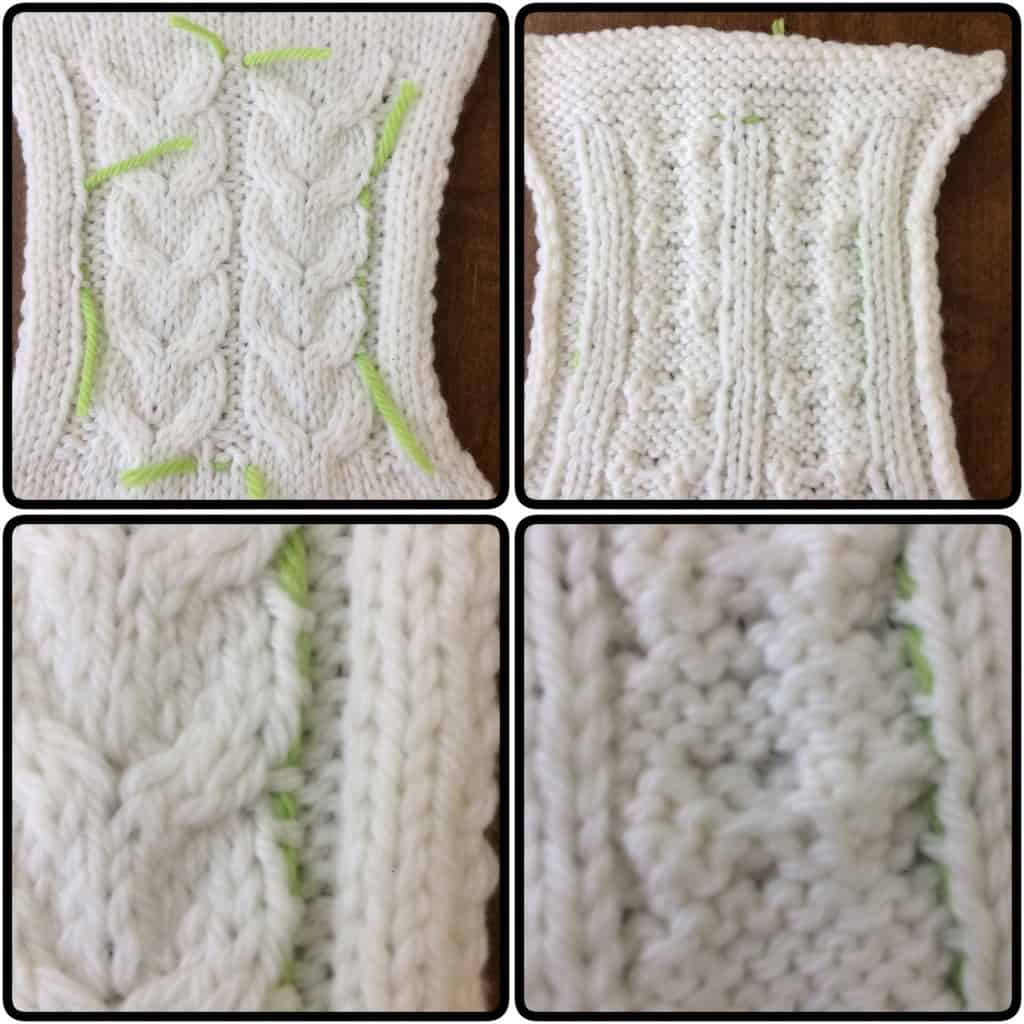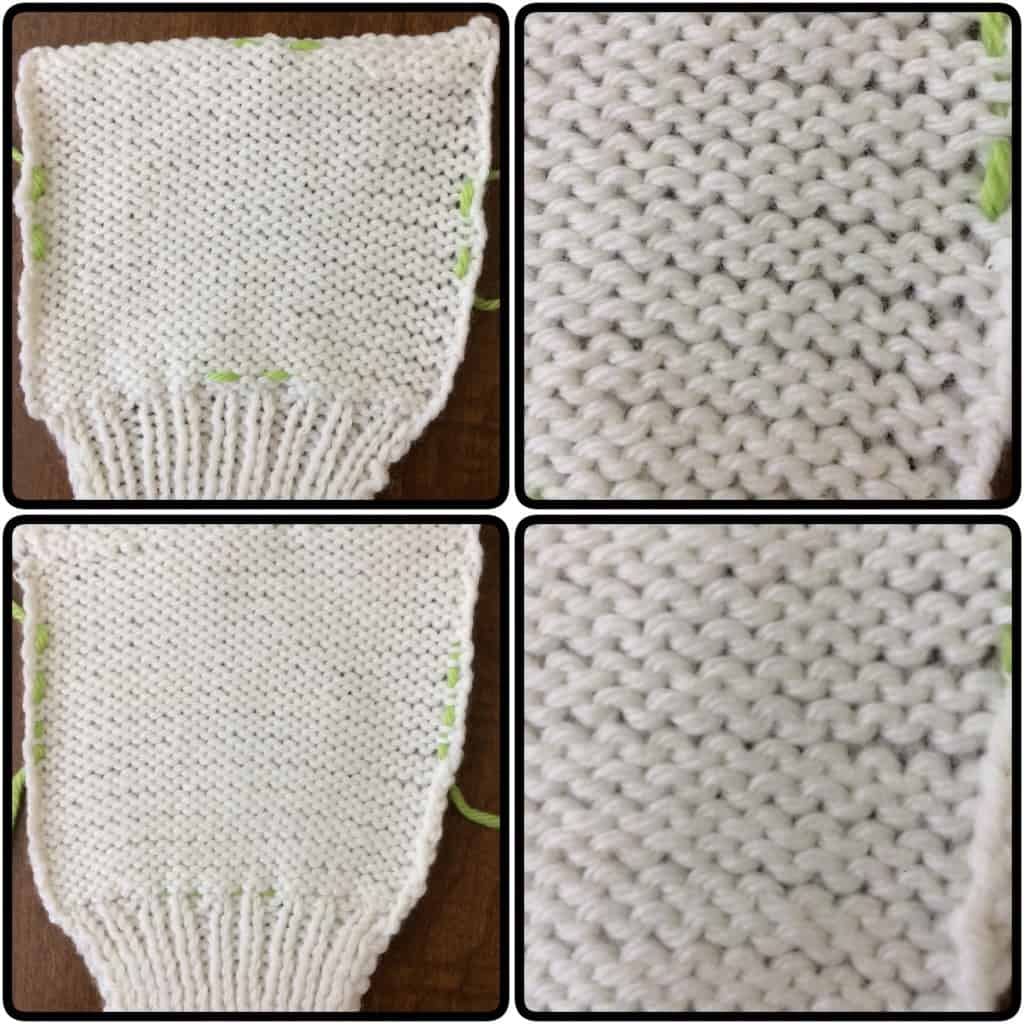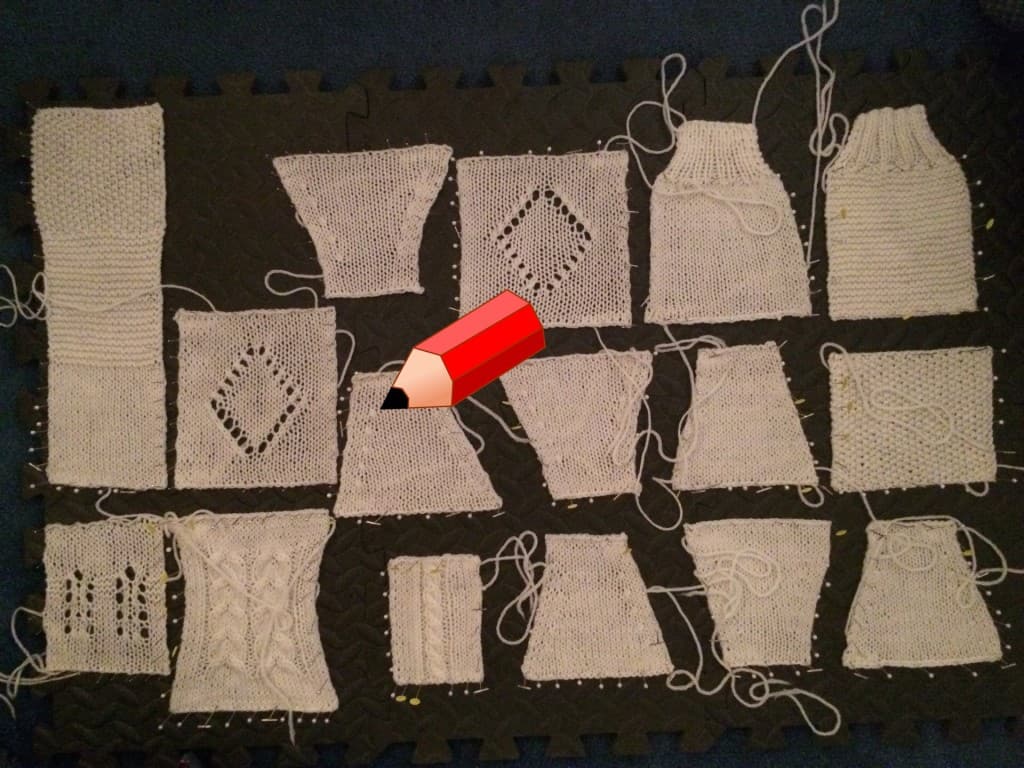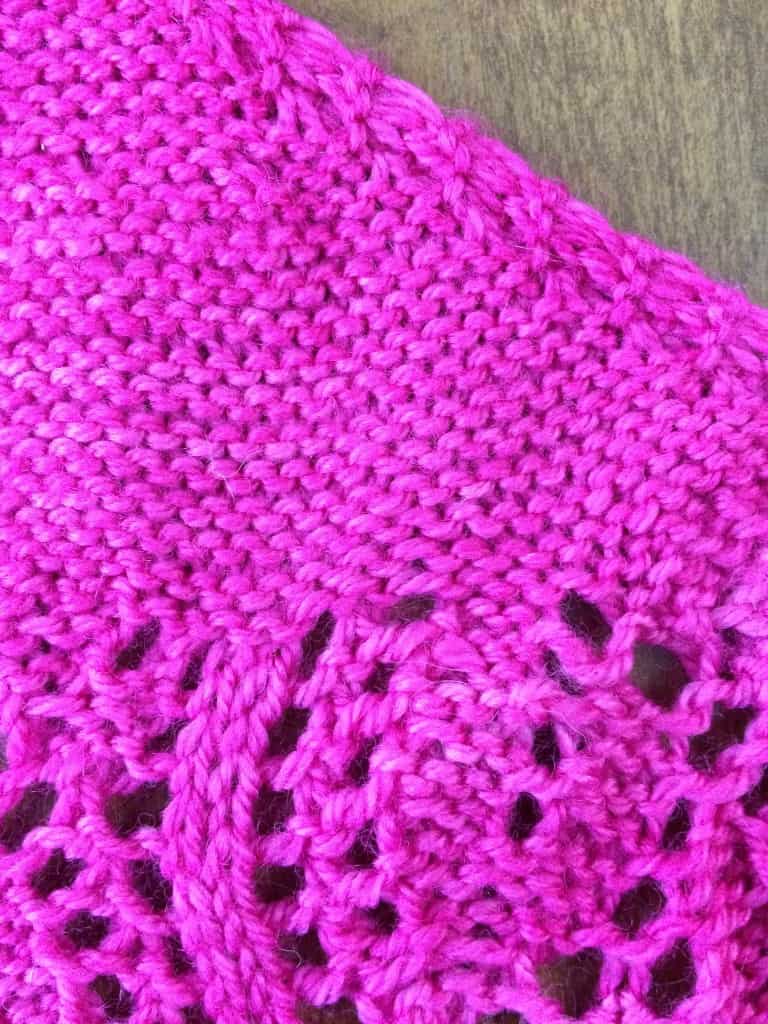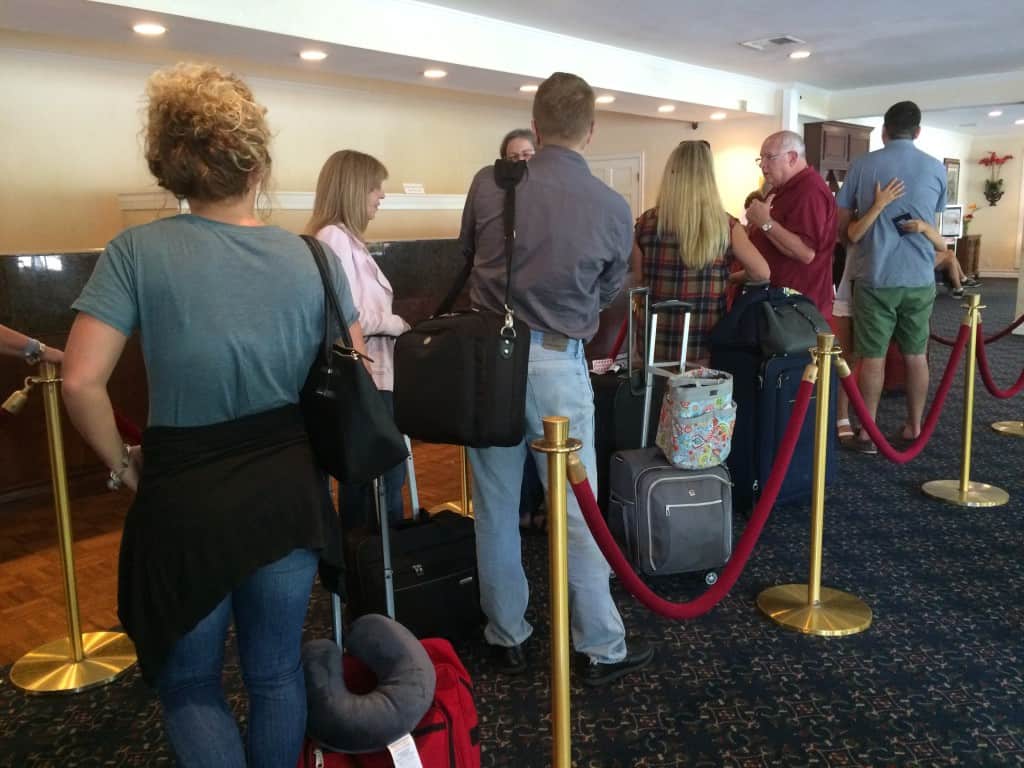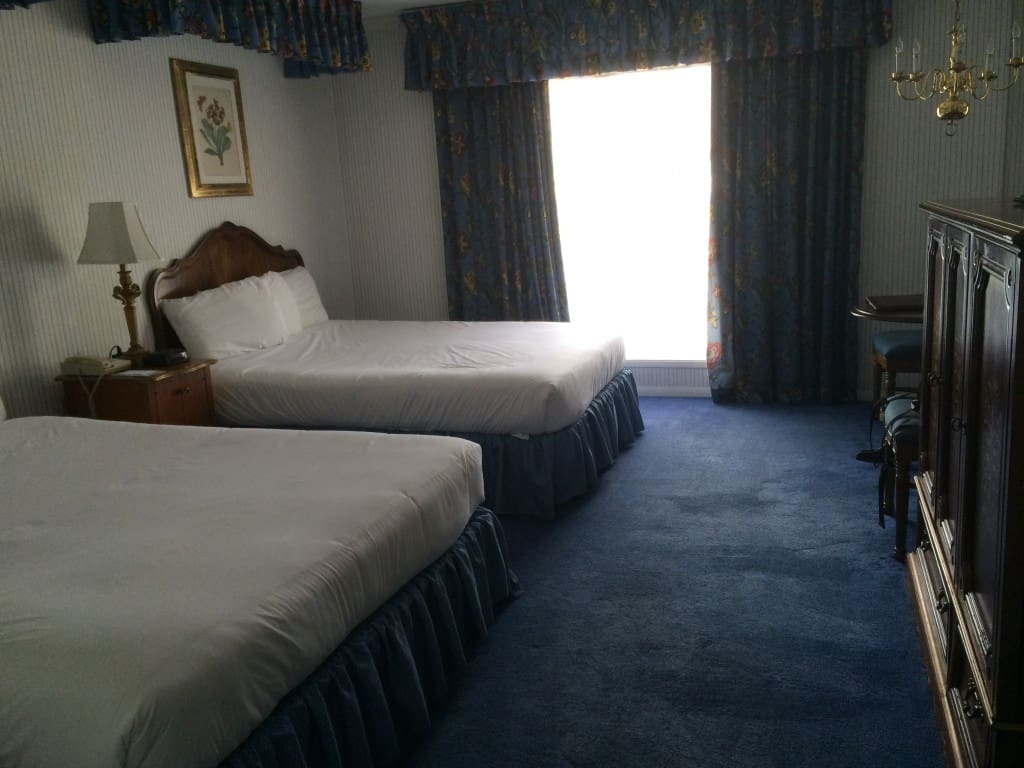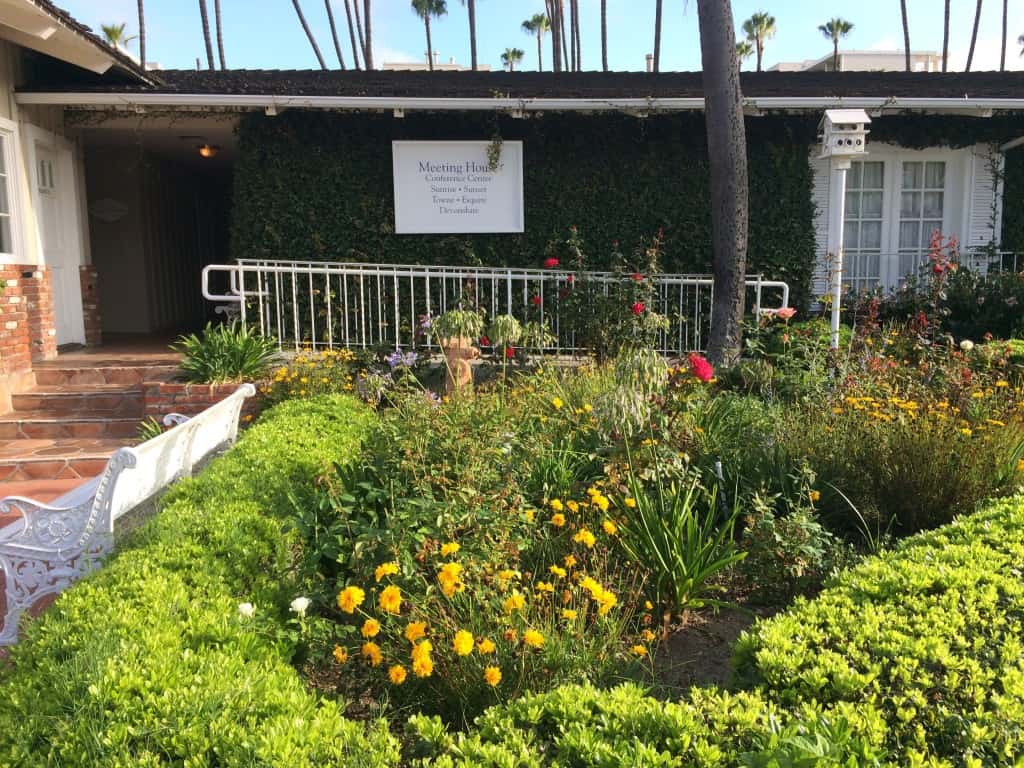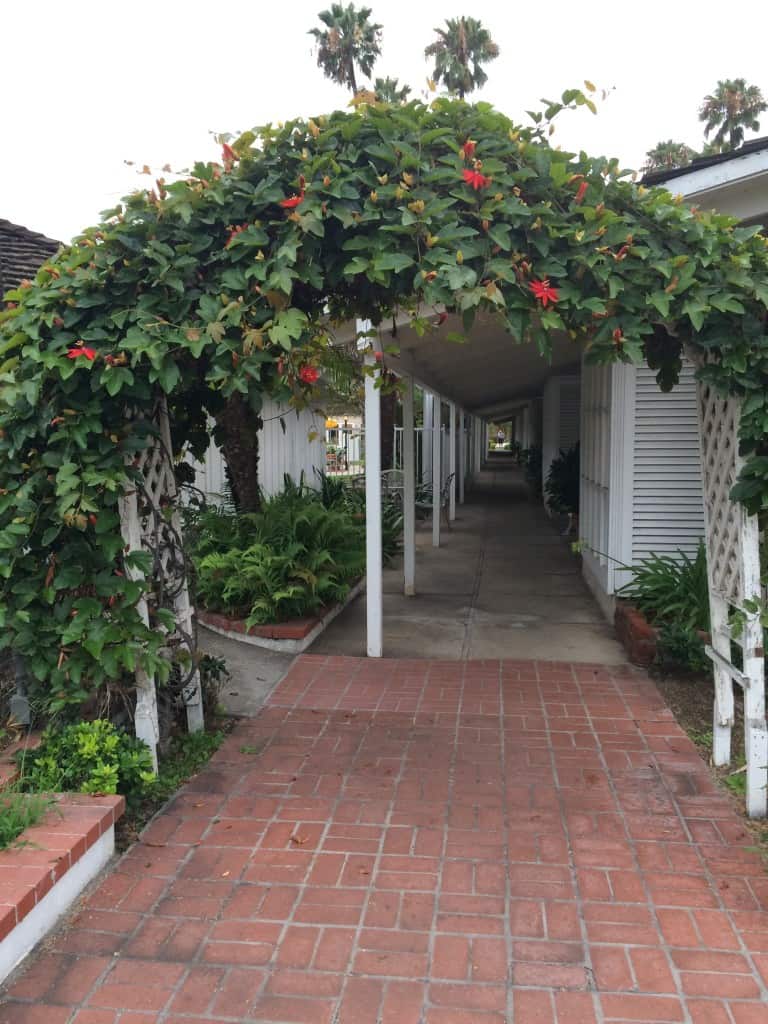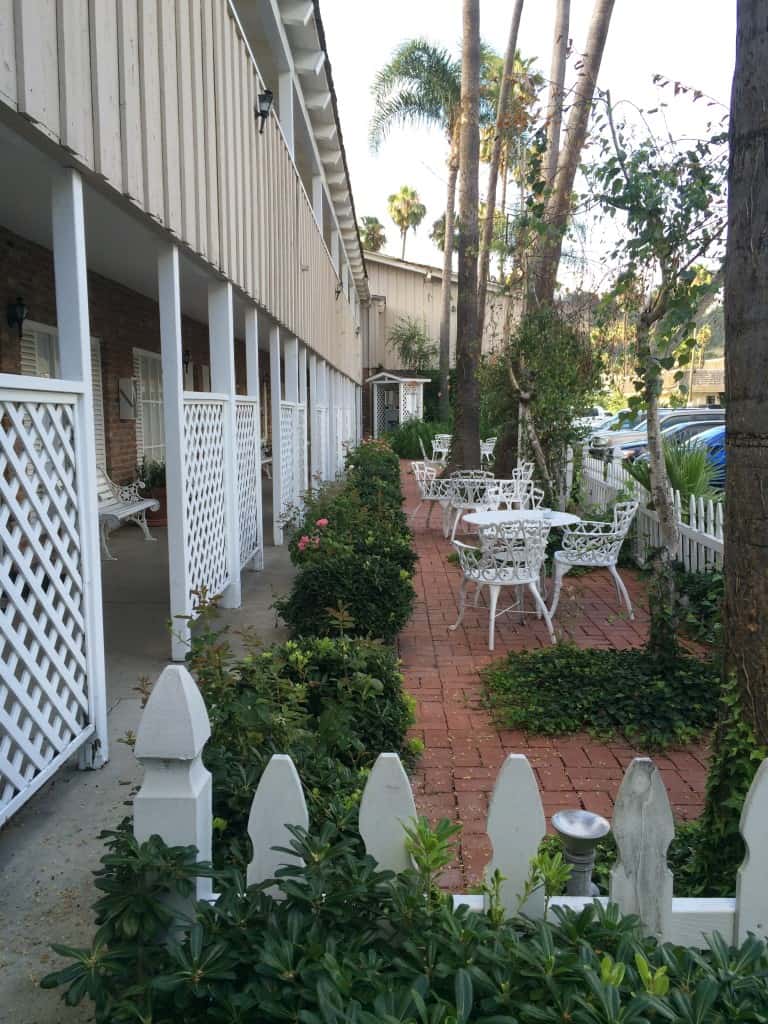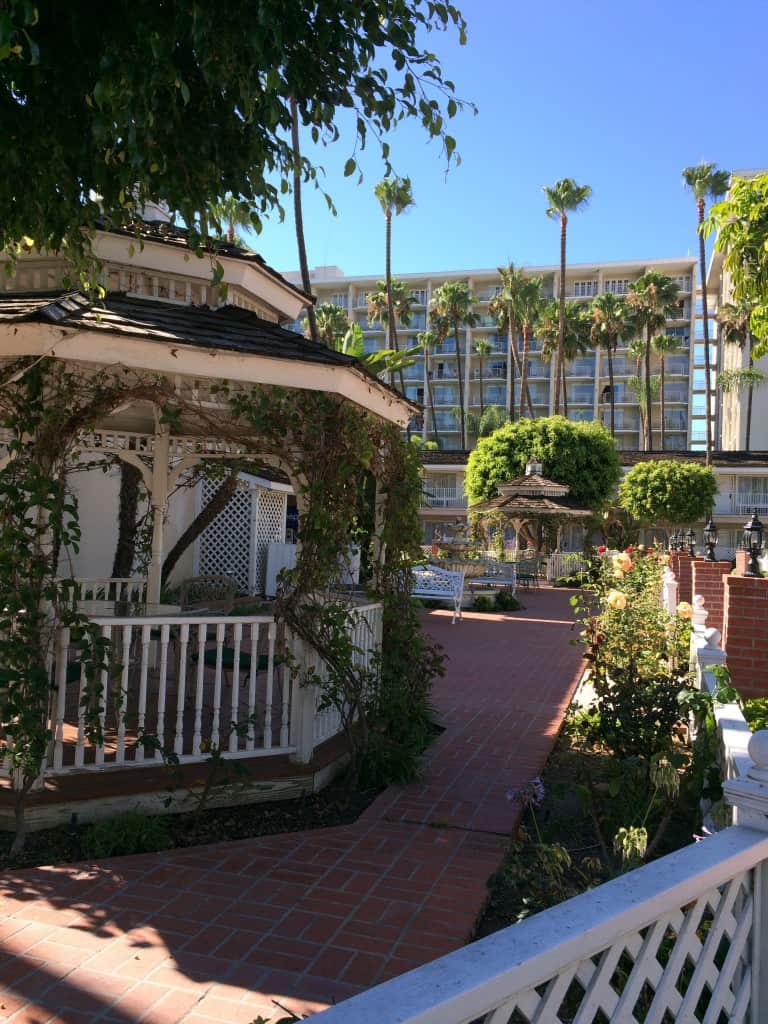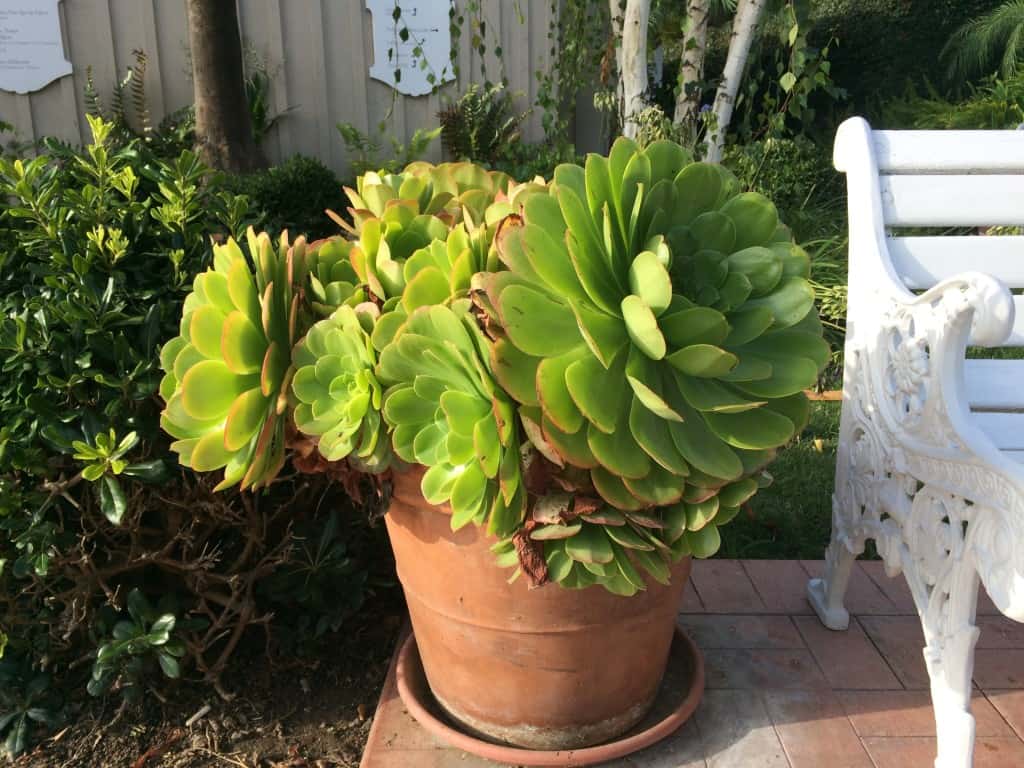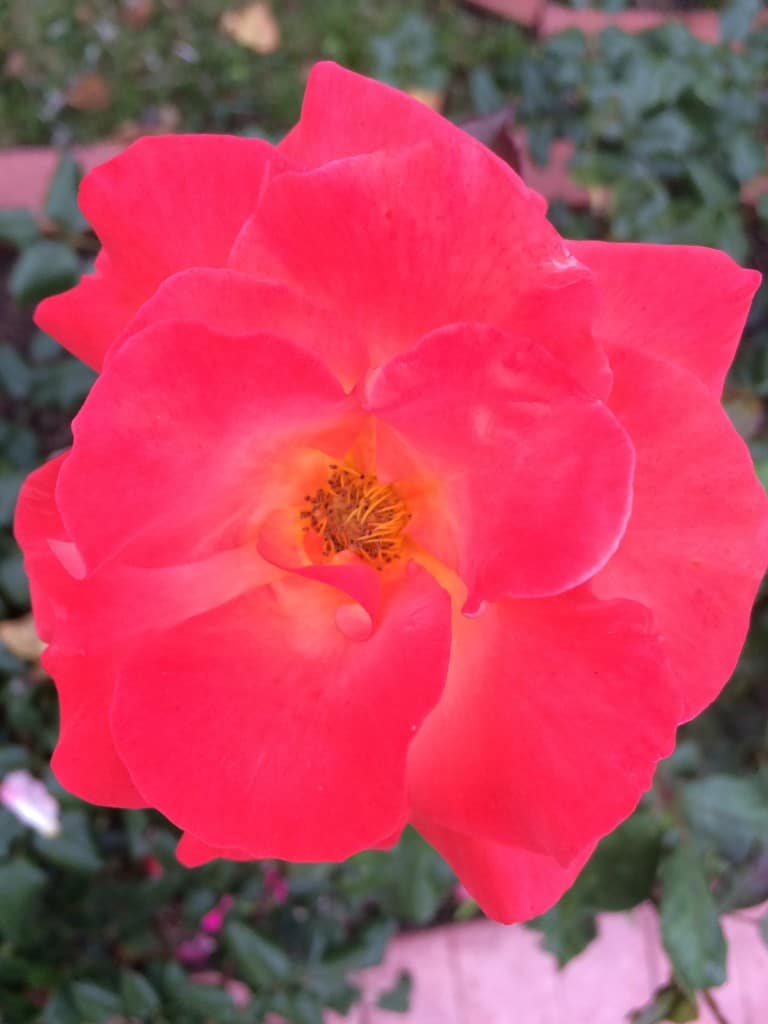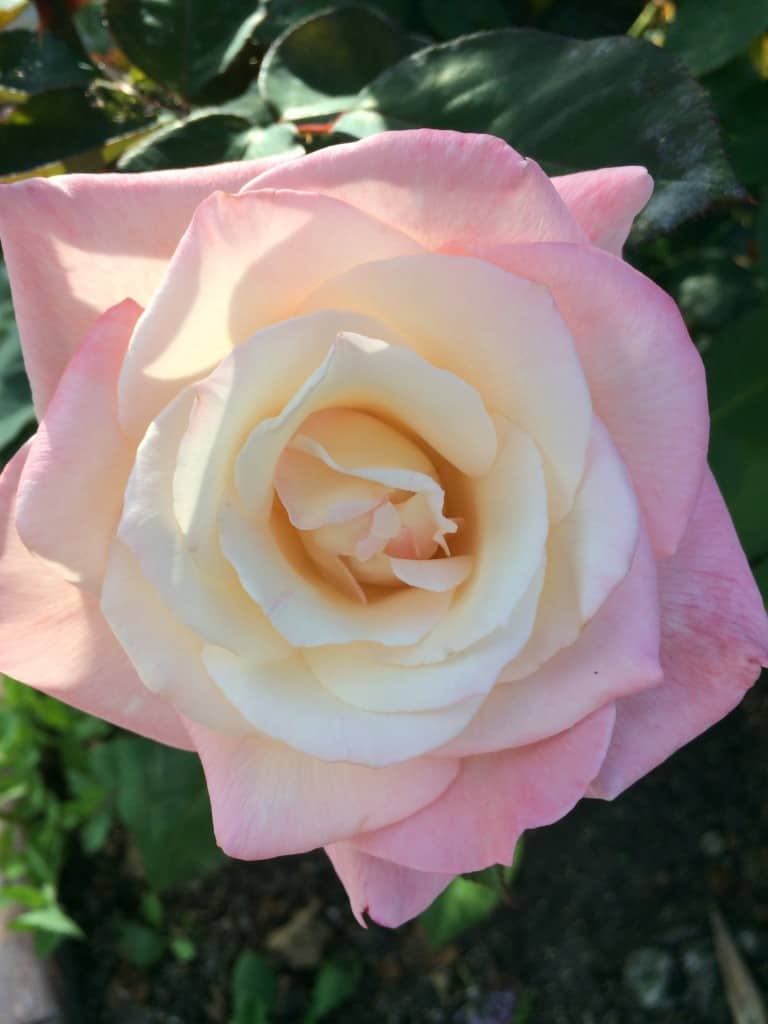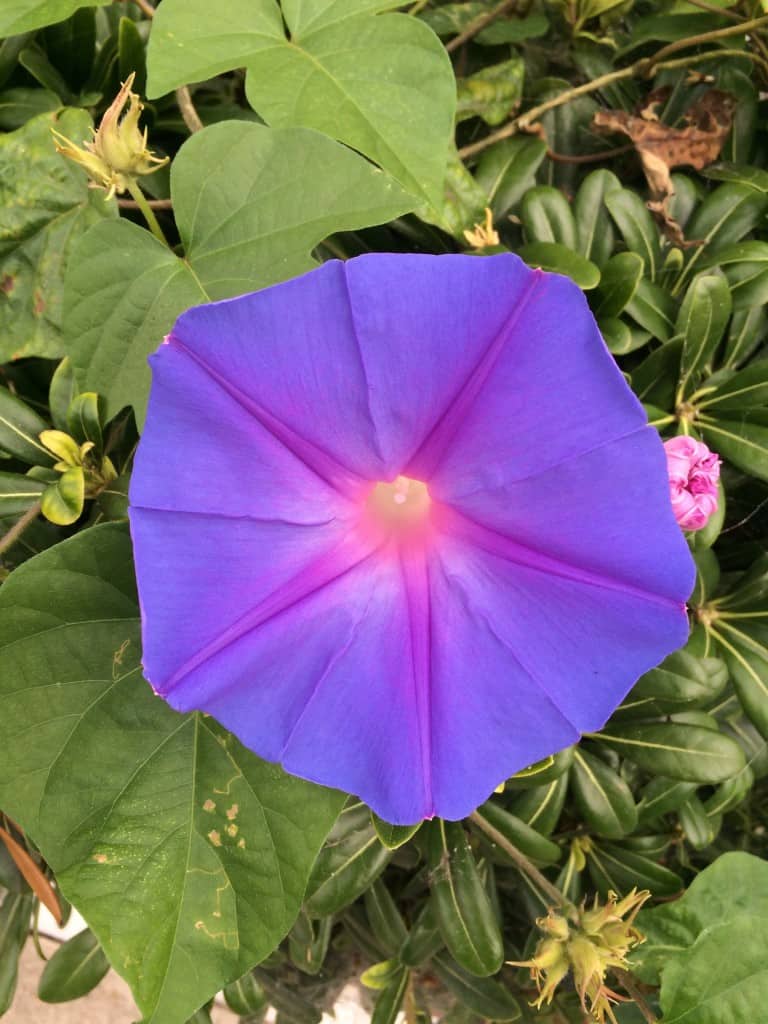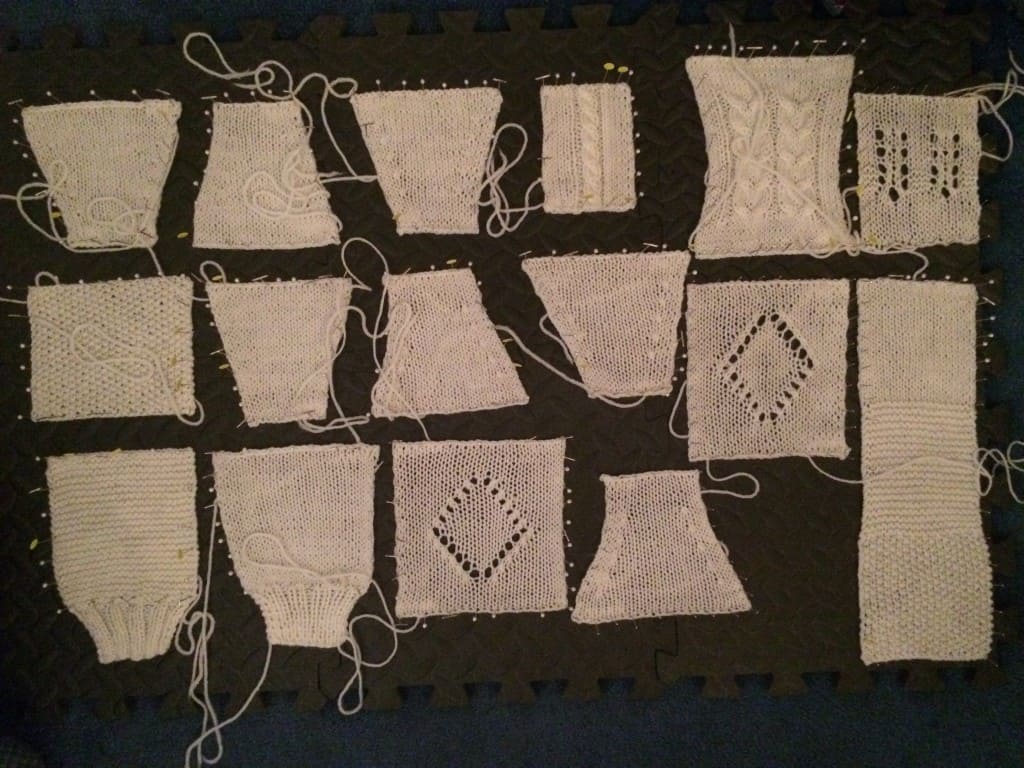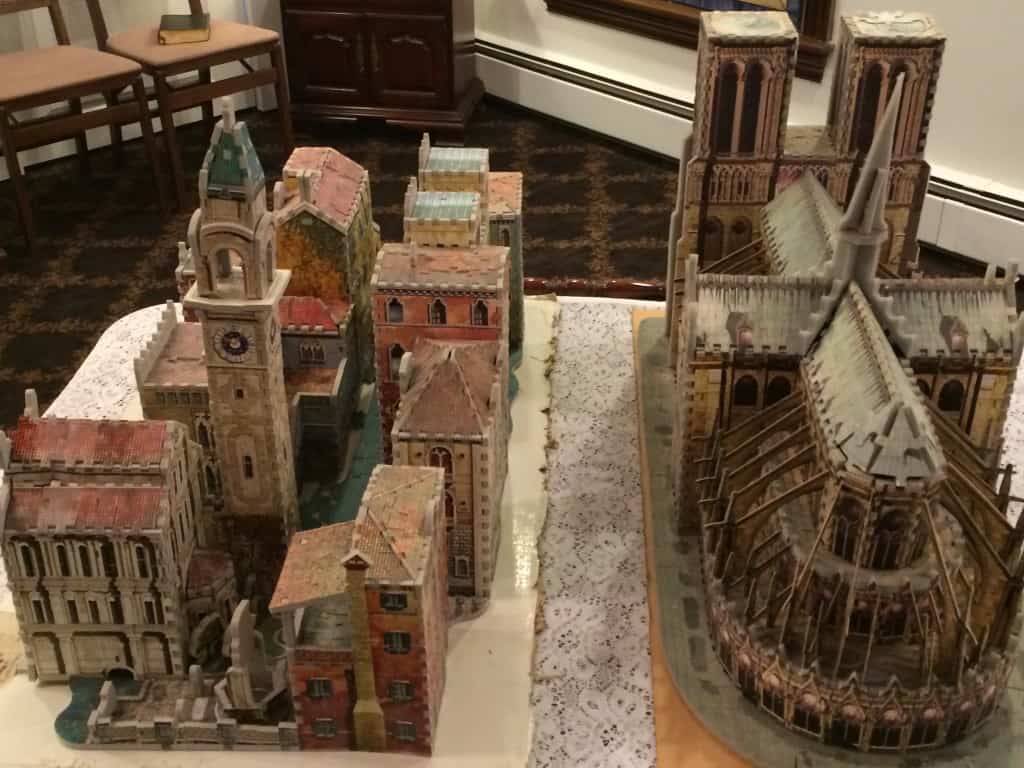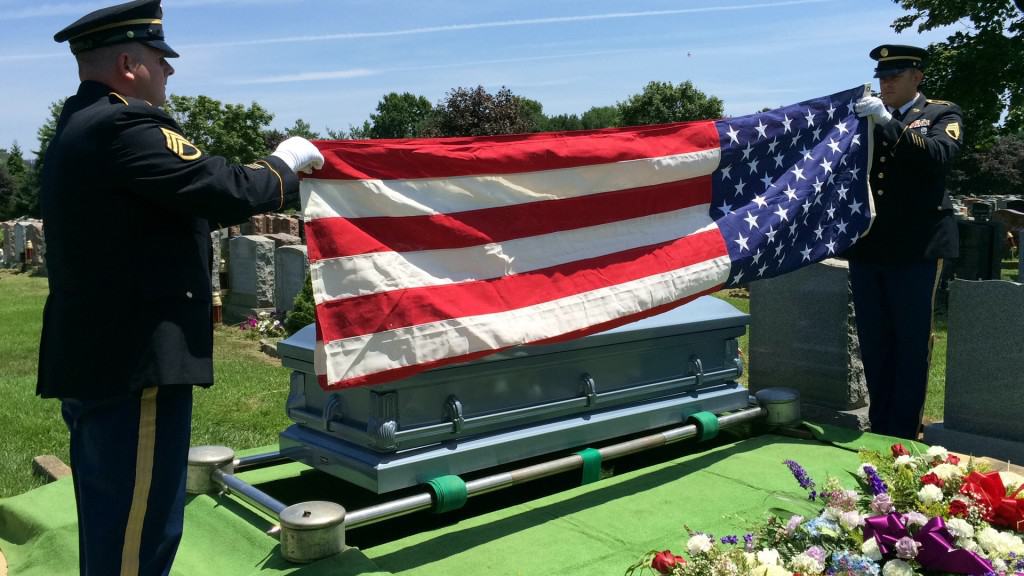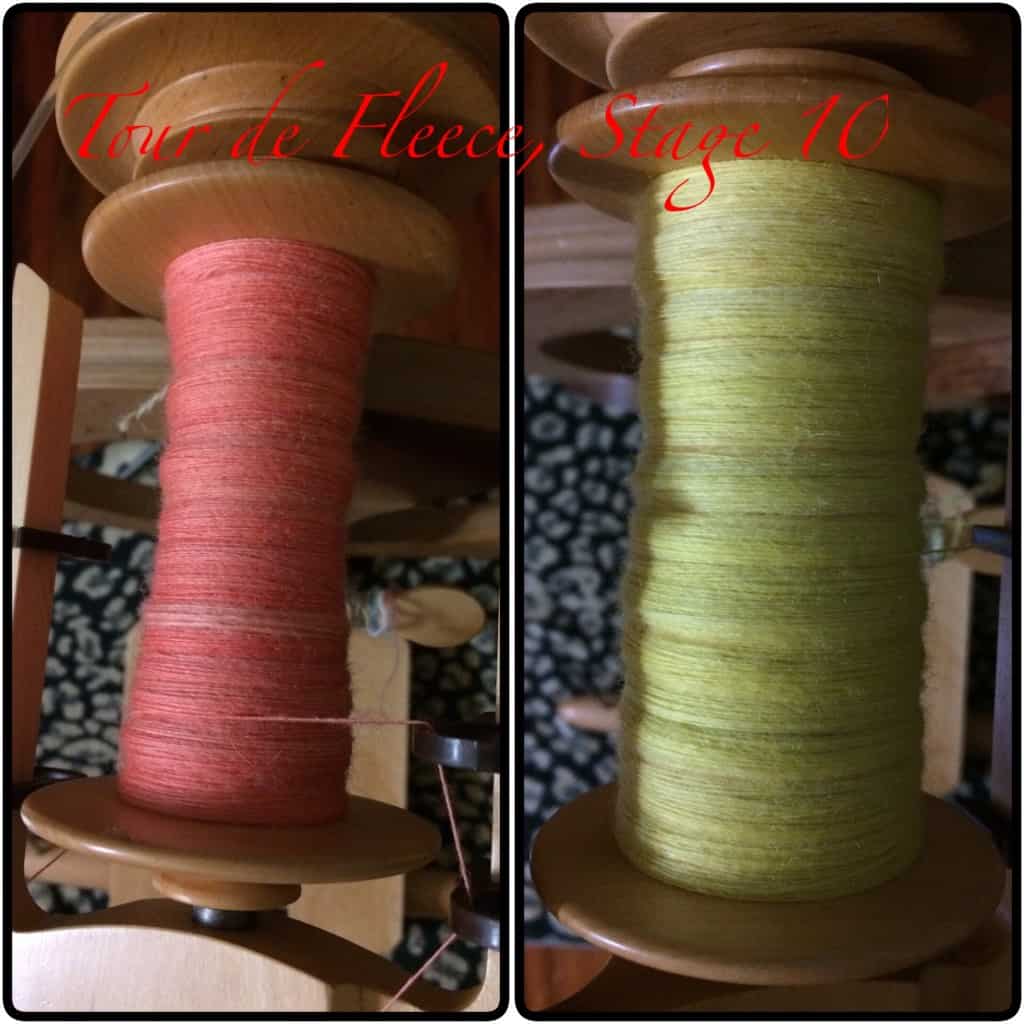I went to TKGA primarily for education, but I signed up for every event I possibly could. Since I was traveling all the way across the country to attend this Conference, I might as well do All The Things! These extra events were the Market Preview, The Breakfast of Brilliance, and The Yarn Tasting. I realize that the title of this blog sounds like it is the last post in this series on TKGA. It is not. These extra events took place on Thursday and Friday. I’m publishing this post today since I’m writing in roughly chronological order. I did attend two classes on Saturday and I will post about them tomorrow.
But before I get to those events, I have to share this license plate, which Heather and I spotted in the hotel parking lot when we were on our way back from lunch on Thursday:
I particularly love how the setting sun looks like a ball of yarn!
The Market Preview
The market did not open to the public until Friday, but anyone attending the conference got to go into the market from 7 to 9 pm on Thursday. When we arrived 20 minutes before the doors opened, the line reached all the way across the lobby!
The line grew quickly, snaking around the lobby. By the time the doors opened, the back of the line was nearly to the market doors.
I headed straight to RedFish Dyeworks. I had not heard of these local dyers before, but during the Finishing Course on Thursday, Arenda showed us several Fair Isle sweaters she’d knit with their yarn and raved about their color sense. I bought a package of twelve 50g / 450 yard skeins of 20/2 silk for weaving:
I also bought 4 ounces of 50% silk / 50% baby camel roving. The roving is incredibly soft thanks to the baby camel fiber and has the sheen of silk. I can’t wait to spin it!
Newton’s Yarn Country booth was next door to RedFish Dyeworks. Their booth was standing room only!
They sell weaving yarns at excellent prices. I looked through the booth, but didn’t buy anything. Most of their yarns were cotton or tencel and I already have many cones of those fibers for weaving.
The Yarnover Truck was in the house. Like literally in the house, on the market floor.
Four Purls, a LYS in Lakeland, FL, has a yarn truck, which I’ve seen at various events (e.g. Orlando Distaff Day 2015), but it’s always parked outside. I love the name “Yarnover Truck.” I want to call them and ask them bring that yarn over. Too bad I live on the opposite side of the country. The inside of the truck is lovely, with built-in cubbies full of yarn:
I didn’t buy anything from them during the market preview, but I came back later to pick up some yarn for a baby blanket that I’m making for a friend.
Another booth carried Jelly Yarn.
Remember those jelly shoes every little girl had back in the late 70s and early 80s? This yarn feels just like those shoes. And some of the colors glow in the dark:
I resisted the temptation to buy some during the market preview because what would I actually do with it? While it’s tempting to think that I might knit myself jelly shoes (or slippers, perhaps) I’m certain they’d be too fragile to wear outside during a Florida summer. I was unable to resist its siren call for the entire Conference however. Three skeins came home with me (in Ravenclaw colors, of course).
Unique Market Features
The TKGA / CGOA Market had two unique features: The Brilliance Bar and a Yarn Winding Station.
During posted Office Hours, at least two Master Hand Knitter Committee Members manned the Brilliance Bar. Attendees could make an appointment to ask knitting-related questions. Whether you wanted a little info on the Master Hand Knitter program or you needed help trouble-shooting a current project, this was the place to go! I didn’t personally make an appointment — almost every class I took was taught by a Committee Member, so I had many opportunities to ask questions during the Conference. I’d love to hear comments from people who did visit the Brilliance Bar or people who worked it. What kind of help did you get? What was the craziest problem anyone brought to the Bar?
OMG. Every fiber event should have one of these. I realize it might not be practical for a large event like Maryland Sheep and Wool, but why haven’t I seen this at the smaller events I’ve attended? I could knit my new yarns NOW. I don’t have to wait to get home to my swift and ball winder!
CGOA Member Design Competition
Each year, CGOA (Crochet Guild of America) runs a Member Design Competition. Entrants must submit their work by July 1. Pieces are on display at the Conference Market and prizes are announced at the Saturday night banquet. “Entries must be original designs that have not been previously entered in this competition, previously published in any print or electronic media, or otherwise publicly available before the date of competition (our judges need to have never seen this work before). Entries do not have to be new or recently crocheted, as long as they are your own designs.” (from the Eligibility Guidelines, available on the members-only section of CGOA’s website). This year, crocheters could enter pieces in 7 categories: Fashion, Accessories, Home Decor and Afghans, Thread Crochet, Young Designer (25 years old or younger), and First-Time Entrant / Non-Professional (no designs previously published in any form). CGOA judges awarded prizes in each category. Anyone attending the Market could vote for one piece for the Attendee Favorite. Here’s a few of my favorites:
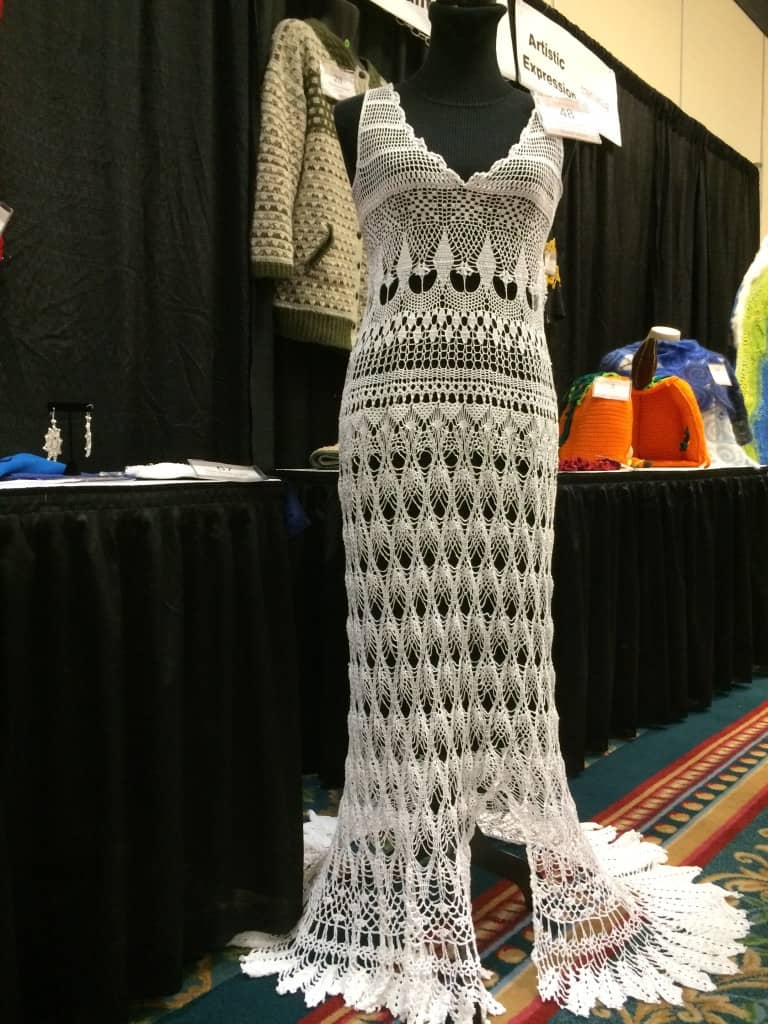
My favorite pieces were all by the same person: fiber artist Kayt Ross. Her website (www.vivaciousart.com) is down, but she does have a Facebook page.
This crocheted cat suit probably looks unwearable:
But someone has actually worn it and looked amazing in it. I found this picture on Pinterest; it was pinned from the artist’s website.
Ross’s entry in the Afghan category was only partially visible under the other afghans. I love the color combination and the freeform shape.
Her piece Danikil Depression won Third Place in the Artistic Expression category. This one was so huge that it was difficult to get good pictures. Here’s a couple of angles.
Her piece Cobblestones won Second Place in the Artistic Expression category.
Finally, the piece that I considered the showstopper: “Emily Rose”. I voted for this one for People’s Choice. I don’t know if it won in that category or not, but it did win First Place in the First Time Entrant category and the overall Grand Prize. Yes, this really is crochet. I leaned in as close as I could get to the piece without touching it and even that close it was difficult to see the stitches. It’s beautiful work.
The list of all the winners, except People’s Choice, is on MarlyBird’s website. She was at the show and did book signings. I believe she was also one of the Design Competition Judges.
The Breakfast of Brilliance
The Breakfast of Brilliance started at 7:30 am Friday.
At this event, anyone who finished Master Knitter Level 3 (the final level) since the last Knit & Crochet Show received a pin from current Committee Chair Suzanne Bryan. A total of 13 people finished level 3 in the last year, but only 7 were able to come to San Diego. I asked Arenda if this was the most people to finish level 3 in one year. She didn’t know off the top of her head, but there’s no doubt that Master Knitters are an elite group. (While working on this blog post I ran across a page on TKGA’s website with pictures of each pinning ceremony since 2007. In 2007, 24 people received pins. In 2008 and 2010, 17 graduates received them.) In the 30 years of TKGA’s existence, only 300 people have completed Level 3. TKGA has the complete list of graduates on their website. Congratulations to all the new graduates!
Level 3 requires knitters to design two projects: a hat and a sweater. One must be Aran (that’s one color, with lots of cables, bobbles, and texture) and the other must be Fair Isle (that’s color work). The knitter can decide if he or she wants to make an Aran hat and Fair Isle sweater or vice versa. During breakfast, we had a fashion show of the new graduates’ final pieces. Some graduates modeled their own pieces. Master Hand Knitter Committee members modeled the rest. Each piece was beautiful! I didn’t get everyone’s names to match with the pieces and I didn’t get good pictures of all the pieces. These are the best pictures and information that I got during the event!
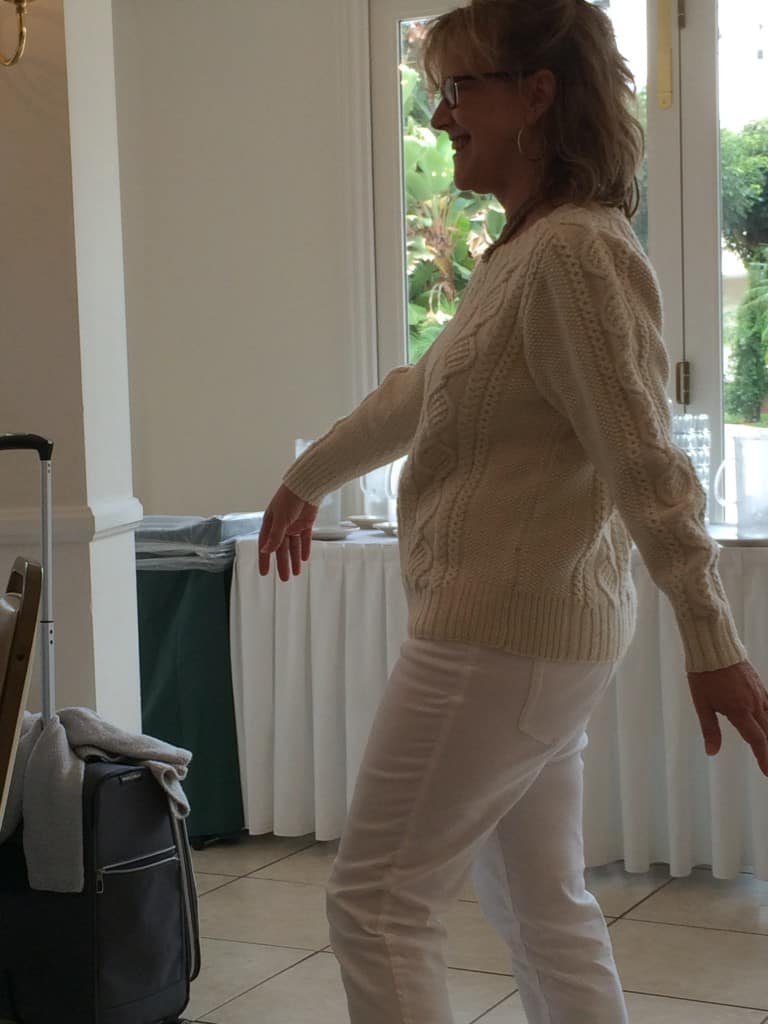
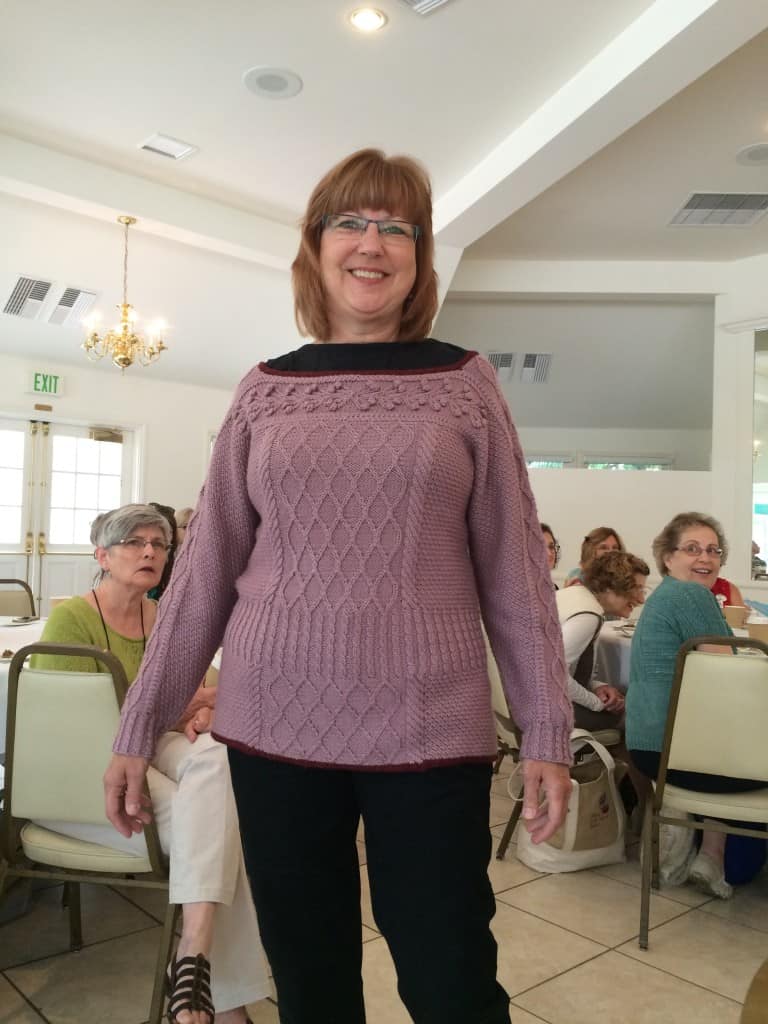
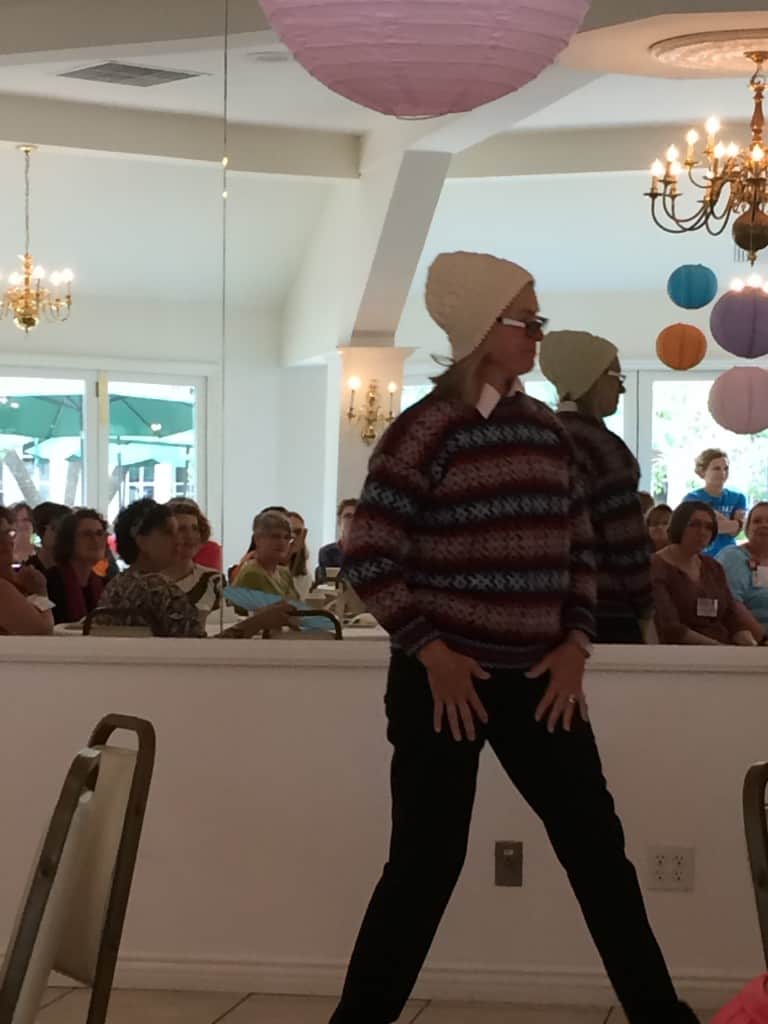
At the end of the Breakfast, we had a drawing for door prizes. Emma won a bag full of yarn. It was like Mary Poppins magical bag but full of yarn instead of mirrors or hat stands.
The Yarn Tasting
The most important thing I have to say about the Yarn Tasting is THANK YOU to Arenda Holladay, Suzanne Bryan, Binka Schwan, and Charles Gandy. One hundred tickets were available for the Yarn Tasting and the event sold out. Each attendee left the event with 40 mini center pull balls of yarn. Arenda, Suzanne, Binka, and Charles hand wound those mini balls. That’s 4,000 mini balls. Arenda makes it sound easy; she’s even got a video on YouTube demonstrating how to wind them. I don’t care how easy they are to wind; it’s got to take a long time to wind 4,000 mini balls. Thank you all!
Here’s links to the sponsors’ websites: A Hundred Ravens, Anzula, Baah, Berroco, Blue Moon Fiber Arts, Brooklyn Tweed, Classic Elite, Elemental Affects, Green Mountain Spinnery, Holst Garn, Imperial Yarn, LB Collection, Lion Brand, Madelinetosh, Miss Babs, Mrs. Crosby Loves to Play, North Light Fibers, Oink Pigments, Peace Fleece, RedFish Dyeworks, Skacel, Shibui, Stonehenge Fiber Mill, Swans Island, Tenacious Fibers (blog and Etsy), and Universal Yarns.
The Yarn Tasting was spectacular. There’s just no other word for it. I’ve never been to an event like this one and had only the vaguest idea what it would be like. We got to the ballroom 15 minutes before the doors opened, so of course there was a line.
When the doors opened, we all filed into the room. Committee members handed each attendee a goodie bag:
We used the goodie bags to collect our mini yarn balls during the event. When we got the bag, it only had 8 yarn balls in it.
The bag itself is part of our gift — it is moth-proof 4 mil plastic! In addition to the 8 yarn balls, each bag held coupons from several sponsors, a 16″ bamboo Chiao Goo needle in either US size 2 or US size 2.5, and 3 magazines.
As you may have guessed from the “Fiber Fiesta” on the event sign, the Yarn Tasting had a Mexican theme, which was carried throughout the night. Seven or eight varieties of yarn were scattered around the table. There was one mini ball / person of each variety.
The placemats listed every yarn we got to sample. Each person got one mini ball of each variety of yarn listed here!
We got 8 mini balls in our bag and 7 or 8 on the table. The remaining samples were set up as a buffet.
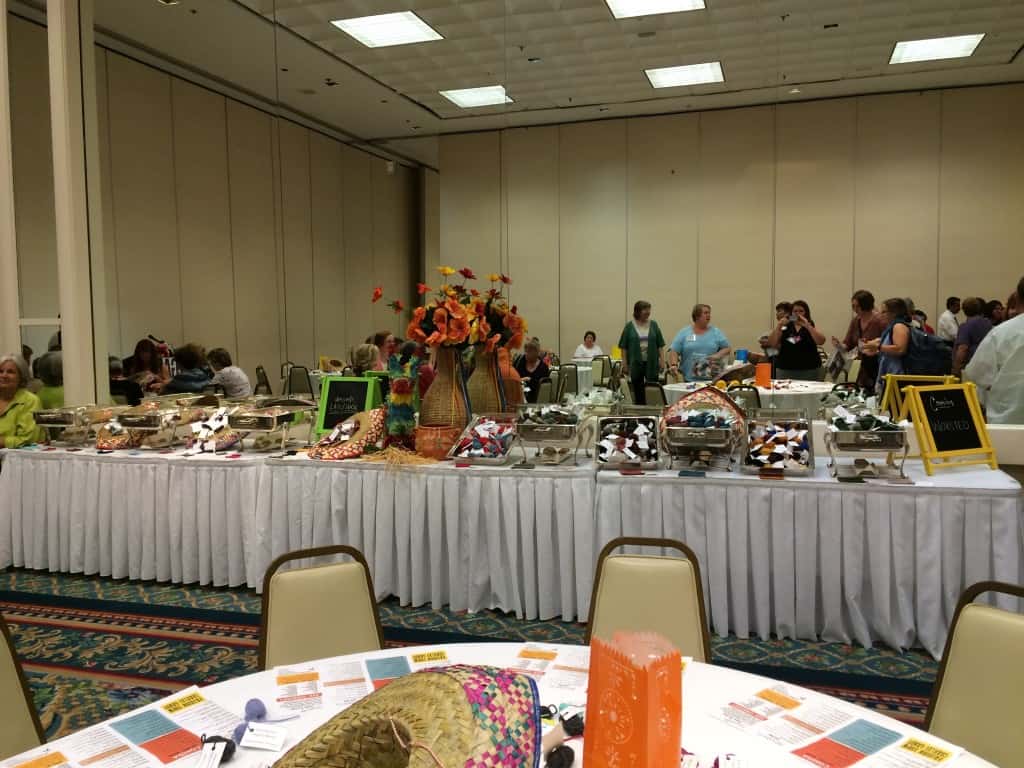
We walked through the buffet, collecting one of each variety displayed.
The buffet sections were labeled by courses, just like they would be if we were getting food. A swatch of each yarn in that category decorated the tables. I believe Arenda knit all the swatches.
After we got our yarn from the buffet, Charles Gandy MCed a fashion show, featuring objects knit from sponsor yarns.
I did not get pattern names, model names, or knitter names for any of these projects — I was lucky just to get pictures! I only have pictures of a small fraction of the beautiful knitwear in this fashion show.
I submitted two items for the fashion show, but failed to take pictures of the models! The first was the Sand Tracks Scarf, knit with Swans Island yarn. The second was a Quinn Cabled Bag. In 2013 I knit 9 of these bags, each in a different color of Peace Fleece. I finished 8 of them and gave them as Christmas gifts. The 9th was mine. The knitting has been finished for more than 18 months, but it’s been sitting in my UFO pile, waiting for me to sew in the lining. Since I said I would submit it for the fashion show, I had to get that lining sewn in. I finally finished it during lunch on the day of the Fashion Show!
After the Fashion Show, anyone who submitted objects went to the ballroom next door to pick up their knitting. Everything looked beautiful, folded up in a row on tables!
As if everything we’d gotten already wasn’t enough, we each got a bag with 5 or 6 skeins of yarn as we left the Yarn Tasting, all donated by sponsors. Each person’s bag was a little different. Arenda suggested we head out to the lobby for a “Halloween candy swap” if we wanted to find enough skeins for large projects!
Like I said — a spectacular event!
Bonus: A Visit to Green Mountain Spinnery
Back in May, I went to Burlington, Vermont to attend my cousin’s college graduation. I drove from Burlington down to Northampton, MA to go to WEBS and meet up with some Ravelry friends, then on to Hartford, Connecticut to spend a couple of days visiting my sister. During my trip, I visited a total of 12 yarn shops! I keep threatening to write blog posts about the trip, but haven’t done it yet. One of the places I visited was Green Mountain Spinnery. Since they were one of the Yarn Tasting Sponsors, I thought I’d slip that visit into this post.
Green Mountain Spinnery is a co-op. Most of the people who work there are part owners of the company, and it is run on democratic principles. When I planned to visit the shop, I didn’t realize that it was a tiny retail space in the mill! As soon as I parked, I knew this wasn’t an ordinary yarn shop. This sorting table is right beside the parking area. Yes, that’s a pile of discarded wool, full of tags or debris.
There’s another big pile of discarded wool out back.
The entrance to the retail space:
Inside the retail space:
It was late in the day when I got there, and the mill was not operating. I did get a quick peek inside.

